
- High-impact business writing
- Effective email writing
- Bid, tender and sales-proposal writing
- Technical writing
- Writing for customer service

- Customer-service writing
- Effective report writing

Business writing essentials

How to write a presentation (and deliver it, even via Zoom)
Jack elliott.
31 minute read

You’ve been asked to give a presentation. Chances are, your response will be roughly one of the following:
1. It’s a subject you’re passionate about and you’re a confident speaker. You’re pleased to have the opportunity.
2. You secretly worry that your style is flat and unengaging. You’re not looking forward to it.
3. At best, the prospect makes you nervous; at worst, terrified. You’d rather have root canal surgery.
If you belong in one of the last two categories, you probably know you’re not alone. You may have heard the statistic that public speaking is more widely feared even than death .

However you feel about the prospect of presenting, this comprehensive guide will take you step by step through the process of planning, writing and delivering a presentation you can be proud of (even via Zoom).
Use the contents links below to jump to the section you need most, make your way through methodically from start to finish, or bookmark this page for next time you need it.
What is a presentation?
Essentially, it’s a story. And its origins go back thousands of years – to when our ancestors gathered around the campfire to listen to the wise elders of the tribe. Without PowerPoint!
These days, presentations encompass the glitz and scale of the Oscars or the new iPhone launch through to business briefings to smaller audiences, in person or – increasingly – online. We’re focusing on the business side.
Whatever the occasion, there’s always an element of drama involved. A presentation is not a report you can read at your leisure, it’s an event – speakers are putting themselves on the spot to explain, persuade or inspire you. Good presentations use this dynamic to support their story.
Always remember: everyone wants you to do well
If you are nervous, always remember: no one sets out to write a poor presentation and no one wants to go to one either. There may be private agendas in the room, but for the most part audiences approach presentations positively. They want to be engaged and to learn. They want you to do well.
First things first: the date’s in the diary and you need to prepare. Let’s break it down.

1. Preparing your presentation
Imagine you’re a designer in the automotive industry and your boss has asked you to give a presentation. The subject: the future of the car and how it will fit with all the other modes of transport.
Where to start? How to approach it? First you need an angle, a key idea.
We talk about ‘giving’ a presentation – and of course it’s the audience who will be receiving it. So, instead of beginning with cars (in this case), let’s think about people. That way we can root the talk in the everyday experience we all share.
Maybe you remember a time you were stuck in traffic on a motorway. Morning rush hour. No one moving. Up ahead children were crossing a footbridge on their way to school, laughing at the cars going nowhere. And you thought, ‘Enjoy it while you can! This will be you one day.’ But maybe not. Surely we can do better for future generations!
There’s your opening – the whole issue captured in a single image, and you’ve immediately engaged your audience with a simple story.
The who, the why and the what
Always begin with the people you’ll be addressing in mind. Before you start writing, answer three fundamental questions: who is your audience, why are you talking to them and what do you want to say?
The answers will provide the strong foundations you need and start the ideas flowing. Ignore them and you risk being vague and unfocused. Clear writing is the result of clear thinking and thinking takes time, but it’s time well spent.
Got a presentation to write? Before you do anything else, answer three fundamental questions: who is your audience, why are you talking to them and what do you want to say? @EmphasisWriting Share on X
Start with the audience
Are you a senior car designer talking to your team? If the answer’s yes, you can assume high-level, shared knowledge.
But if you’re talking to the sales or marketing departments, you can’t make the same assumptions – there are issues you might have to explain and justify. And if it’s a press briefing, it’s about getting the message out to the general public – a different story again.
Knowing your audience will also dictate your tone. Your presentation to the board is likely to be quite formal, whereas a talk for your team can be more relaxed.
And what’s the audience’s mood? On another occasion you might have bad news to deliver – perhaps the national economy and the company’s finances are threatening people’s jobs. Then you must empathise – put yourself in their position and adapt your tone accordingly.
I want to …
You also need a clear objective (the why ). For our car designer, the overriding objective should be to plant a key idea in the audience’s mind. Starting with that image of the schoolchildren, it’s to convince the audience that the company has a radical and distinctive design future.
That’s the takeaway. How should they do that? Should they explain, persuade or inspire – the three key strategies for any presentation? You may need to use several of them to achieve your goal.
Objectives should always complete the statement ‘I want to …’. What do you want to do ?
It’s about …
The what is the substance of your presentation – the building blocks, all the facts and figures that tell the audience ‘It’s about …’.
Back to our designer. The move away from petrol and diesel will allow a complete rethink of car design. The electric power unit and battery can lie under the car’s floor, freeing up all the space taken up by the conventional engine. And then there are all the issues around emission-free, autonomous vehicles in the ‘smart’ cities of the future.
When you’re planning, it can be helpful to get all the information out of your head and onto the page, using a mind map , like the example below (for a talk on UK transport policy).
This is an effective way of unlocking everything you know (or still need to do more research on). Start with your main topic, then keep asking yourself questions (like who, what, when, where, how and why) to dig into all the aspects.

Mind map with the topic of ‘UK transport policy at the centre. Arrows point out to six bubbles with the labels ‘Who’, ‘When’, ‘Why’, ‘How’, ‘What’ and ‘Where’. More arrows point out from each of these bubbles to explore related points in each area, and still more arrows from some of those points to expand further. The information reads:
- Special interests / NGOs
- Need for clear government direction
- What industry will do
- R&D spend
- What industry is doing
- Congestion [this leads to the sub-point ‘Wasted time and money’]
- More pollution
- More congestion
- More wasted time and money
- Climate change
- Road pricing
- Legislation
- Working together
- New technology
- Exports/revenue
- Social policy
- Rest of world
- Emerging economies
Once you’ve got it all out on the page, you can identify which parts actually belong in your presentation. Don’t try to include every last detail: audiences don’t want to process piles of information. They are more interested in your ideas and conclusions.
Now let’s put all this research and planning into a structure.
2. How to structure your presentation
On 28 August 1963, Dr Martin Luther King Jr stood on the steps of the Lincoln Memorial in Washington DC and delivered one of the most powerful speeches in history: ‘I have a dream’.
He was the leader of the civil rights movement in the US and his audience that day numbered in the hundreds of thousands. His goal was to inspire them to continue the struggle.
Presentations usually aim to either explain, persuade or inspire – sometimes with elements of all three. Your aim will determine your structure. This will be the backbone of your presentation, giving it strength and direction.
Explain in a logical sequence
When you explain, you add to people’s knowledge to build the key idea. But ask yourself, what does this audience already know?
If you’re an astrophysicist talking to an audience of your peers, you can use terms and concepts you know they’ll be familiar with. If you’re explaining black holes to Joe Public, you can’t do that. Typically, you’ll have to use simple analogies to keep the audience with you (‘Imagine you’re in a huge dark room …’).
Whether it’s black holes or new software, good explanations start with what we know and then build on that understanding, step by step, layer by layer. The audience will stay with you if they can follow your logic and you can help this with linking comments – ‘Building on that … ‘, ‘This means …’, ‘To illustrate that, I’ve always found …’.
Presentations usually aim to either explain, persuade or inspire – sometimes with elements of all three. Your aim will determine your presentation's structure. @EmphasisWriting Share on X
We need to change
If you’re writing a persuasive presentation, you also need to follow a particular sequence.
Whether you’re writing a pitch for a prospective customer or making research-based recommendations to a client, you follow the same structure. That structure is the Four Ps . It’s a powerful way of leading your audience’s thinking.
Start with the current situation – where you are now ( position ). Explain why you can’t stay there, so the audience agrees things have to change ( problem ). Suggest up to three credible ways you can address the issue ( possibilities ). Then decide which one is the optimum solution ( proposal ).
Three is a magic number for writers – not too many, not too few. But there may be one standout possibility, in which case you go straight to it ( position, problem, proposal ).
Think about how the pandemic has profoundly changed our working lives. Towns and cities are full of offices that people used to commute to. But to maintain social distancing, we’ve been encouraged to work from home where possible and to stay away from public transport.
At some point, decision-makers within organisations will have to make a call – or share a recommendation – about what to do long term. Should we go back to the office, stay at home or combine the two?
If we had to present on this choice using the Four Ps structure, we could outline the pros and cons of each possibility and then make a push for the one we recommend above the others. Or we could join the likes of Google and Twitter and simply propose purely remote working well into the future.
I have a dream
A presentation that inspires is about the future – about what could be. Scientists inspire children to follow careers in astronomy or physics with their passion and stunning visuals. Designers re-energise companies with their radical, exciting visions. Business leaders convince their staff that they really can turn things around.

An audience watching an inspirational presentation is not going to take away lots of facts and figures. What’s important is their emotional and intellectual engagement with the speaker, their shared sense of purpose. One way to build that engagement is with your structure.
From dark to light
The most inspiring presentations are so often born of shared struggle. On 13 May 1940, Winston Churchill addressed the British parliament – and the British people listening on their radios – in the darkest days of the Second World War.
He was brutally realistic in his assessment of the current position: ‘We have before us many, many long months of struggle and of suffering.’ He then set out his policy: ‘To wage war by sea, land and air, with all our might … against a monstrous tyranny’, and the prize: ‘Victory, however long and hard the road may be.’
In difficult situations, audiences immediately see through false hope and empty rhetoric. They want honest acknowledgement, and the determination and clear strategy to lead them to the future.
We can imagine how the same structure could show up in a more business-related context:
‘I’m not going to sugar-coat the figures. We have to change to save jobs and secure our future. There will be dark days and sacrifices along the way, but what’s the hardest part of any turnaround? It’s getting started. To do that, we all need to keep asking two fundamental questions: where can we improve, how can we improve? And if we push hard enough and if we’re utterly relentless, change will come and our momentum will build.’

Are you going to appeal to your audience’s
- habits of thought (current beliefs)?
If your recommendations run counter to their current beliefs, try appealing to their emotions.
3. Writing your presentation script
You don’t have to write a script. Some people put a few PowerPoint slides together and wing it; others make do with bullets on a smartphone, laptop or cue cards. It depends on the event and the presenter.
Writing a full script takes time, but if it’s a very important presentation and you might use it again – perhaps to appeal for investment – it will be worth it.
Some people will write a full script because the company or organisation that’s commissioned a presentation will want to see a copy well ahead of the event (often for legal reasons). Others will write the script, edit it down to the required time and then edit it down again to bullets or notes.
If the presentation is to a small audience, your notes or bullets will suit a more conversational approach. There are no rules here – see what works best for you. But what you must do is know your subject inside out.
To write clearly, you must think clearly and a full script will expose the areas that aren’t clear – where an explanation needs strengthening, for example, or where you should work on a transition.
Timing is everything
A full script also helps with working out timing, and timing is crucial. TED talks, for example, have a strict 18-minute limit, whether in front of an audience or online. That’s short enough to hold attention, but long enough to communicate a key idea. (The ‘I have a dream’ speech lasted 17 minutes 40 seconds and it changed the world.)
It takes a very skilled presenter to go much over 30 minutes. If you are taking questions during or after your presentation , however, it’s fine to build in extra time.
Imagine you’re writing your presentation in full and your slot is 20 minutes. On an A4 page with a 14-point Calibri font and 1.5 line spacing, that will equate to about 10 pages.
You can also divide the page in two, with slides on the left and text on the right (or vice versa). Then you can plan your words and visuals in parallel – and that will be roughly 20 pages.

Script page with a slide on the left-hand side and text on the right. The slide has the heading ‘What is your purpose?’ and has a photo of a smiling person at a whiteboard mid-presentation. The text on the slide reads:
Do you want to:
- do a combination of all three?
The notes next to the slide read:
How should they do that? Should they explain, persuade or inspire – the three key strategies for any presentation? You may need to use several of them to achieve your goal.
The most powerful key on your keyboard – Delete
Use these numbers as your goal, but your first draft will probably be longer. That’s when you start deleting.
Be ruthless. Anything not adding to the story must go, including those anecdotes you’ve been telling for years ( especially those anecdotes). It’s not about what you want to tell the audience, it’s about what they need to hear.
Don’t feel you have to include every single issue either. Dealing with two or three examples in some detail is far better than saying a little bit about many more.
And interpret visual material you’re displaying rather than describing it, just as you wouldn’t repeat the text that’s on the screen. The audience can see it already.
It’s a conversation
Be yourself – don’t write a script that’s not in your style. We want the real you, not a supercharged version.
Some people are naturals when it comes to presenting – which can mean they’ve learned how to draw on their authentic strengths.
Sir David Attenborough is a great example. He has a wide-ranging knowledge of the natural world. He has an infectious passion and enthusiasm for his subject. And most importantly, he doesn’t lecture the camera: he talks naturally to his audience (and he’s now using Instagram to inspire new generations).
You can take a cue from Sir David and make your presentation style your own. Knowing your own strengths and really understanding your why will help you speak with purpose and passion.
And aim to speak naturally. Use conversational, inclusive language. That means lots of personal pronouns ( I believe, we can) and contractions ( Don’t you wonder …, you’re probably thinking …).
Sir David Attenborough introduces his new series, Our Planet at its premiere. He builds up our awareness by layering information alongside arresting statistics. These are framed simply, in relatable terms (‘96% of mass on the planet is us …’), so we easily grasp their shocking significance. He also uses ‘we’ and ‘us’ a lot to underline how this environmental emergency affects us all on ‘the planet we all call home’.
Finding the right words
Imagine you’re talking to someone as you write. And try saying the words out loud – it’s a good way to catch those complex, overlong sentences or particular words that will be difficult to say.
Presentations are not reports that can be reread – the audience has to understand what you are saying in the moment . Don’t leave them wondering what on earth you’re talking about, as they will only fall behind.
So avoid using long or complex words, or words you wouldn’t hear in everyday conversation (if your everyday conversation includes ‘quarks’ and ‘vectors’, that’s fine). And beware of jargon – it can exclude the audience and it quickly becomes clichéd and outdated.
Here are some more hints and tips on how to write effectively for speaking:
Syntax (word order): Disentangle your thoughts and arrange the words in your sentences to be simple and logical. Often, complex syntax shows up when the main point is getting lost inside excess information (or that the speaker is unsure what their main point is).
Pace, rhythm and tone: Varying the pace, rhythm and tone of sentences makes both the speaking and listening experience far more enjoyable.
Make sure the stress falls on the most important words. For example, ‘To be or not to be ‘ (where the stress rises and falls on alternate words) or ‘I have a dream ‘ (where the stress falls on the final word).
Vary the length of sentences and experiment with using very short sentences to emphasise a point.
Play with rhythm by arranging words in pairs and trios. Saying things in threes gives a sense of movement, progression and resolution: Going, going … gone . Saying words in pairs gives a more balanced tone (‘courage and commitment’, ‘energy and effort’) or a sense of tension between the words (‘war and peace’, ‘imports and exports’).
Analogies: Good analogies can work well in presentations because they paint vivid pictures for the audience. The best way to do it is to use either a simile (‘It wasn’t so much a dinner party, more like feeding time at the zoo’) or a metaphor (‘He was the fox and the company was the henhouse’).
Alliteration: This means using two or more words that start with the same sound, like ‘big and bold’, ‘sleek and shiny’ or ‘key components’. On the page alliteration may look contrived, but it can effectively highlight important phrases in a presentation.
Words to avoid: Be careful about using clichés like ‘pushing the envelope’, ‘playing hardball’ and ‘thinking outside the box’. And think carefully about using any word that ends with -ism, -ise, -based, -gate, -focused and -driven.
Be careful with humour too: don’t write jokes unless you can naturally tell them well. Keep the tone light if it fits the occasion, but a badly told joke can be excruciating.
4. How to start your presentation
People tend to remember beginnings and endings the most, so make sure your opening and conclusion are both strong.
You have about a minute to engage an audience. You want them to be intrigued, to want to know more, to come slightly forward in their seats. If you only learn one part of your presentation by heart, make it that minute.
A quick ‘thank you’ is fine if someone has introduced you. A quick ‘good morning’ to the audience is fine too. But don’t start thanking them for coming and hoping they’ll enjoy what you have to say – you’re not accepting an Oscar, and they can tell you what they thought when it’s over. Get straight down to business.
There are four basic types of introduction which will draw your audience in:
- News – ‘Positive Covid-19 tests worldwide have now reached …’
- Anecdotal – ‘About ten years ago, I was walking to work and I saw …’
- Surprise – ‘Every five minutes, an American will die because of the food they eat.’
- Historical – ‘In 1800, the world’s population was one billion. It’s now 7.8 billion.’
You can interpret these beginnings in any number of ways. If you were to say, ‘I have an admission to make …’, we will expect a personal anecdote relating to your main theme. And because you’re alone in front of us, it’s playing on your vulnerability. We’re intrigued straight away, and you’ve established a good platform for the rest of the presentation.
You can also combine these techniques. The historical beginning creates a sense of movement – that was then and this is now – as well as a surprising fact. It may prompt a thought like, ‘Wow, where’s this going?’ And you can trade on this with your own rhetorical question: ‘What does this mean for everyone in this room? It’s not what you think …’.
As well as setting up your story, you need to quickly reassure the audience they’re in safe hands. One way to do that is to give them a map – to tell them where you’re going to take them and what they’re going to see along the way.
Then you’re starting the journey together.
5. How to end your presentation
Your ending is what you want the audience to take away: your call to action, your vision of the future and how they can contribute.
If your presentation is online or to a small group in a small room, your ending is not going to be a battle cry, a call to man the barricades – that would be totally inappropriate. But equally don’t waste it with something flat and uninspiring.
Here are four effective ways to end your talk (like the intros, you can combine them or come up with your own):
- Predict the future – ‘So what can we expect in the next ten years? …’
- Quotation – ‘As our chief exec said at the meeting yesterday, …’
- Repeat a major issue – ‘We can’t carry on with the same old same old.’
- Summarise – ‘Continuous improvement isn’t our goal. It’s our culture.’
Predicting the future fits well with a historical beginning – it completes the arc of your presentation.
If you end with a quotation, make sure it’s relevant and credible – it has to be an authoritative stamp.
Repeating a major issue means pulling out and highlighting a major strand of your presentation, while summarising is about encapsulating your argument in a couple of sentences.
Your ending can also be a change of tone, perhaps signalled by the single word ‘Finally …’. It’s the audience’s cue to come slightly forward again and pay close attention.
As with your opening, it will have more impact if you’ve learned your ending – put down your notes, take a couple of steps towards the audience and address them directly, before a simple ‘Thank you.’
6. Creating your PowerPoint slides
We’ve all been there – watching a seemingly endless, poorly designed slide deck that’s simply restating what the presenter is saying. So common is this tortuous experience that there’s a name for it: Death by PowerPoint. But it doesn’t have to be like this.
Do you need slides at all?
As with your script, the first thing you should ask is ‘Do I actually need this?’ In 2019, Sir Tim Berners-Lee gave the Richard Dimbleby lecture for the BBC. He spoke for about 40 minutes with no autocue (he’d memorised his script) – and no speaker support.
This is a uniquely powerful form of presentation because the audience’s attention is totally focused on that one person. The call to action at the end of a presentation and delivering bad news are also best done without visuals.
Visual support
But if they’re well-judged and relevant, slides or other visuals can add enormously to a presentation – whether it’s photography, video or the ubiquitous PowerPoint. There are, however, two things everyone should know about PowerPoint in particular:
- It’s incredibly versatile and convenient.
- In the wrong hands, it can be unbearably tedious.
Your PowerPoint slides should not essentially be your cue cards projected onto a screen. They shouldn’t be packed margin to margin with text or full of complex diagrams.
If the presentation is live, the audience has come to watch you, not your slide deck. Online, the deck may have to work harder to sustain visual interest.
As with the script, keep your finger poised over that Delete key when you’re putting the deck together.
How many slides?
There’s no hard-and-fast rule about how many slides you should use, but think in terms of no more than one or two a minute on average. And don’t use more than a couple of short video inserts in a 20-minute presentation.
You might have a section where you show a few slides in a sequence or hold a single slide for a couple of minutes, which is fine. Varying the pacing helps to keep a presentation moving.
Optimise for psychology
As self-professed presentation aficionado David JP Phillips notes in his TEDx talk , people – and that includes your audience – have terrible working memories. If you don’t account for this fact in your slides, your talk will not have a lasting impact. In fact, most of it will be forgotten within around 30 seconds.
To counter this effect, David identifies five key strategies to use when designing your PowerPoint:
- Only have one message per slide: more than that and you’re splitting your audience’s attention.
- Don’t use full sentences on slides, and certainly don’t imagine you can talk over them if you do. People trying to read and listen at the same time will fail at both and absorb nothing. Move your running text into the documentation section instead, and keep the slide content short and sweet.
- People’s focus will be drawn to the biggest thing on the slide. If your headline is less important than the content below it, make the headline text the smaller of the two.
- You can also direct people’s attention using contrast. This can be as simple as guiding their point of focus by using white text (on a dark background) for the words you want to highlight, while the surrounding text is greyed out.
- Including too many objects per slide will sap your audience’s cognitive resources. (Your headline, every bullet, any references, even a page number each count as an object.) Include a maximum of six objects per slide and viewers will give a mental sigh of relief. This will probably mean creating more slides overall – and that’s fine.
More Powerpoint and visual aid tips
Here are a few more guidelines for creating your visual aids:
- Never dive into PowerPoint as job one in creating your presentation. Work out your talk’s structure (at least) before designing your slide deck. Making a genuinely effective PowerPoint requires that you know your subject inside out.
- List any visuals you’ll need as you prepare your script. That terrific photo you saw recently could be difficult to track down, and you might need permission and to pay to use it.
- It bears repeating: keep each slide to one key idea.
- Use the build effect of adding one bullet at a time (or use the contrast trick above) and try not to use more than three bullets per frame (or six objects overall).
- Strip each bullet to the bare minimum – no articles (‘a’, ‘an’ and ‘the’), no prepositions (‘in’, ‘at’, ‘to’ etc) and cut right back on punctuation.
- Every word that’s not there for a reason has to go. Delete, delete, delete.
‘Extra’ slides
- Use a ‘walk-in’ slide. Rather than have the audience arrive to a blank screen, this tells them who you are and your presentation’s title.
- Use occasional holding slides in between those with more content – perhaps an image but no text. They give the audience a visual rest and put the focus back on you.
- A plain white background might look fine on a computer monitor, but it will be glaring on a big screen. Invert the norm with a dark background, or use shading or ‘ghosted’ images to break up backgrounds and add visual interest.
- Some colours work better than others on-screen. Blues and greys are soft and easy on the eye. Red is a no-no, whether for backgrounds or text. And if you stick with a light background, favour a more subtle dark grey over black for the text.
- Use sans serif fonts (like Arial, Helvetica or Calibri) and think about point size – make sure it’s easily legible.
- Only use upper case where absolutely necessary.
Images and data
- Photos work well full screen, but they also really stand out well on a black background.
- Make sure your charts and graphics aren’t too complex. The dense information that’s fine on the page will not work on-screen – it’s too much to take in. Graphs behind a TV newsreader are often reduced to a single line going dramatically up or down.
- Don’t present data or graphs and expect them to speak for themselves. You need to find the story and significance in the data and present that .
And finally
- Proofread, proofread, proofread – or risk standing in front of an embarrassing spelling mistake.
Technical check
- Check what laptop they’re using at your venue. If you’ve written your deck on a PC, run it on a PC (and, of course, the same rule applies if you’ve used a Mac).
- If you’ve emailed your presentation to the venue, take a USB copy along as back-up.
- If you’re presenting online, check which platform you’ll be using and get comfortable with it. If someone else will be hosting the event, make sure you arrange a time for a rehearsal, especially if there will be a producer.
7. Delivering your presentation
You’ve put a lot of time and effort into preparing your presentation and now you’ve come to the sharp end – it’s time to stand and deliver.
Run it through
You don’t have to rehearse, but most presenters do and for good reason – it catches weak points and awkward transitions. And, crucially, it bolsters confidence.
Read your script or go through your bullets aloud – it will help to settle your nerves. If you use colleagues as a dummy audience, you can do a sense check too: ‘Does that bit work?’ ‘Have I explained it clearly?’ ‘Do you get the big picture?’ And rehearsing out loud will catch those words and sentences you thought you could say but can’t.
The more you rehearse, the more familiar and natural the presentation will become. Rehearse the technical side too – where the video is going to come in, how you’re going to vary your pace and tone to maintain interest.
Try speaking slightly more slowly than you would normally so the audience catches every word, and don’t be afraid to pause now and again. It gives a breathing space for you and the audience.

Connect with your audience
When you deliver your presentation for real, establish eye contact with the audience, just as you would in a conversation. In a small room with a small audience, talk to individuals. In a larger space, don’t talk to the first couple of rows and ignore the rest – include everyone.
And if you stumble over your words here or there, carry on and don’t dwell on it – you’ll lose your concentration. Audiences are generally forgiving and they might not even notice.
Each audience is unique: they react differently in different places. And although tomorrow might be the tenth time you’ve done the same presentation, it will be the first time this audience sees it. Your duty is to keep it fresh for them.
A final point
This is your presentation – you’re in control and the audience needs to feel they’re in safe hands.
It’s perfectly natural to feel nervous , but it’s the thought of doing it that’s the worst bit. Once you get going – and especially when you sense the audience is with you – the nerves will start to disappear. Try to enjoy it. If you enjoy it, it’s far more likely the audience will too.
And remember: everyone wants you to do well.

8. How to present online
Taking to Zoom or another online platform to present was once the exception. These days, online presenting is as essential a skill as presenting in person.
The switch to online can be nerve-wracking and cause even usually skilled presenters to falter. But there’s no need for that to happen.
Indeed, all of the advice we’ve talked about on preparing, structuring and writing for in-person presenting is equally relevant for your online delivery. You just need to be ready for the unique challenges that remote presentations pose.
An obvious one is that while you still have an audience, it will probably be muted and possibly even unseen (if webcams are switched off). This makes it far more difficult to gauge audience reaction, and if the event is pre-recorded, there might not be any at all – at least not immediately. Clapping and laughing emojis are not quite like the real thing.
Keep eye contact
But although your audience may be many miles away, there are still ways you can – and should – create a sense of connection with them. Your presentation will have much more impact if you do.
Whether the event is live or recorded, at least start with your webcam on (unless you really can only use slides). If it’s an option and feels appropriate, consider keeping your camera on throughout – remember, you are the presentation as much as any visuals.
If you will be on display, make sure you know where your webcam’s lens is and at key moments of your talk look directly into it – and out at your audience – to punctuate those points.
And don’t look at a second screen to cue up your PowerPoint – viewers will think your attention is wandering.
Engage your online audience
Being an engaging speaker is always important, but remember that the online world is already a place we associate with distraction. It’s also easier for a viewer behind their laptop to disguise their wandering attention than it would be for one in an auditorium or boardroom.
This isn’t to say your audience don’t want to give you their attention. But it is more important than ever to keep your presentation sharp and concise. Revisit your structure, your script or cue cards and your slides. Take a really critical eye to it and (as always) delete, delete, delete anything that’s not directly relevant.
If it works for your format, you can look at making your presentation interactive. You can then break the content into short segments, interspersed with comment, polls, questions and discussion. The variety will be a welcome change for your viewers.
Your visuals are part of what will keep people with you – along with the interplay you create between you and them. This means following the best-practice guidance we covered earlier is even more important.
Using Zoom for your presentation? Master the art of online delivery through this simple mix of set-up, delivery and technical tricks @EmphasisWriting Share on X
Modulate your voice
Your tone of voice is extremely important here because presenting online is like radio with pictures. When people say ‘You have a great voice for radio’ what they mean is that it’s easy to listen to, often because you’re using quite a low-pitched, warm and relaxed register.
Listen to voices on the radio and voiceovers and identify the ones you particularly enjoy. What do you like about them? Why do you enjoy some voices and not others?
A flat, unmodulated voice, for instance, is difficult to listen to for long periods (and isn’t likely to inspire anyone).
Experiment with intentionally adding energy to your voice, as internet audio can have a dulling effect. As our trainer Gary Woodward puts it: ‘Turn up the enthusiasm dial even higher than you think, to make sure it comes through.’ And always vary your pace and tone as you would in a normal conversation.
And if it suits the tone of your talk, smile now and again. Smiling is contagious, and people will hear it in your voice even if they can’t see you.
Perfect your transitions
One of the other key challenges of remote presentations is that you have another layer of technology to wrestle with: sharing your PowerPoint online.
This means that many presentations begin with the popular catchphrase ‘Can you see my screen?’
This can also cause many presenters to stumble through their transitions, making the links between their slides clunky. And while remote audiences may be forgiving, for a slick presentation it’s best to prevent these sort of fumbles.
Naturally, practice plays a part here. But you can also give yourself the advantage with your set-up.
Dave Paradi from Think Outside the Slide explains one great way of setting up Zoom so you can smoothly cue up and run your slide deck – and be certain what’s being displayed.
You’ll even be able to see the rest of your screen (but the audience won’t). As you’ll be able to see what’s coming up, your transitions can also be seamless.
The trick is to use one of Zoom’s advanced settings after you hit ‘Share screen’, to share only a portion of your screen:

Advanced screensharing options pop-up box in Zoom, with the options ‘Portion of Screen’, ‘Music or Computer Sound Only’ and ‘Content from 2nd Camera’. The ‘Portion of Screen’ option is highlighted in blue.
This will give you a frame you can move to the part of the screen you want the audience to see.
Put your PowerPoint slides into ‘presenter view’ before launching the screenshare. Then you’ll be able to see the upcoming slides and your notes throughout, and your animations (like build slides) will work as normal.

Zoom’s ‘portion of screen’ setting in action
Presenter view in PowerPoint, with the current displayed slide on the left and the upcoming slide displaying smaller on the right, with notes below it. There is a notification saying ‘You are screen sharing’ at the top and a sharing frame positioned around the current slide.
The other part of the trick? Set it up in advance shortly before you’re due to speak. Once you’re happy with the set up, you can stop sharing until it’s time to kick off your talk. When you return to ‘Share screen’ again, it will reopen the frame in the same place.
Dave shows you the process in this video:
Five practical tips for a truly professional online presentation
You’re happy with the content of your talk, you’ve ruthlessly streamlined your slides and mastered your radio voice. Now just make sure you cover these crucial practicalities for a polished presentation:
1. Create a good space Make sure you have your environment well set up:
- Keep the background on display as tidy and minimalist as possible – a plain wall or backdrop is great, if you can.
- Manage and minimise background noise (shut the window, ensure your phone’s on silent, put the cat out, make sure someone’s watching the kids in another room – whatever it takes).
- Check your lighting: have your light source in front of you, not behind you (or you’ll be in shadow).
- Set up your computer or device at eye level so that you are well-framed and facing it straight on – avoid looming above it while providing a lovely view into your nostrils.
2. Think about your appearance Dress in the same way you would if the presentation were in person, and judge your choice of attire based on the formality of the event and your audience.
3. Practise! Run through the presentation and rehearse the technical side. Practise your transitions, including the initial cueing up of your slides (perhaps using the Zoom tip above), so that you can be confident in doing it all smoothly.
4. Be primed and ready Log in early on the day of your talk. Check all your tech is working, get your headset on and ensure everything is set up well ahead of time. This will save any last-minute issues (and stress) and means you can hit the ground running.
5. Stand and deliver Even online, consider giving your presentation standing up, if you can do so comfortably (adjusting your device or webcam accordingly). This may put you more into a presenting frame of mind and will differentiate you from most remote presenters.
Are you still there?
Live audiences have a group dynamic – as soon as a few people start laughing it becomes infectious and the others join in. It’s naturally different online. But that doesn’t have to throw you.
You might not get that immediate feedback, but don’t overcompensate and feel you have to win them back.
Yes, it’s often more difficult to gauge an audience’s reaction online – especially if their audio is muted and their webcams off. Yes, this can be daunting. But they are still out there listening. You may or may not hear (or see) laughter, but they could still be smiling and very interested in what you have to say. Have faith in your own content. Whatever form your delivery will take, keep coming back to your purpose and message for giving this talk – and keep considering the people you’ll be talking to. Whether the address will be online or in person, it is keeping this focus which is the key to every powerful presentation.
Ready to learn even more? Work one-to-one on your presentation-writing skills with one of our expert trainers or join our scheduled presentation-writing courses . If your team are looking to upskill, we also offer tailored in-house training . And if fear of presenting is holding your team back, check out our in-house course The reluctant presenter .
Image credit: lightpoet / Shutterstock

Your go-to guide to better writing
Get your own PDF copy of The Write Stuff , the definitive guide for everyone who writes at work.

These days he's one of Emphasis' top business-writing trainers, but in previous career lives Jack has written for many public and private sector organisations. He has an in-depth knowledge of the engineering and manufacturing sectors, particularly the UK automotive industry. As the lead scriptwriter for chairmen and CEOs, he has been responsible for proposals, pitches and reports as well as high-profile speeches and global product launches.
Was this article helpful?
This helps us make better content for you

You might also like

The readability techniques you need for clear business writing

Writing to the board
Writing a report for the board? Here’s what you need to know
![How to write a winning marketing proposal [with presentation template] 5 A business woman sits at a desk, presenting a proposal (on a laptop screen) to the man sitting across from her.](https://www.writing-skills.com/wp-content/uploads/2023/04/business-woman-presents-proposal-300x161.jpg)
Writing for marketing
How to write a winning marketing proposal [with presentation template]

Bids and proposals
Is your bid presentation pushing prospects into the cold?
Get expert advice, how-tos and resources for good writing (and great work).
- Interactive Presentation
How To Write A Presentation 101 | Step-by-Step Guides with Best Examples | 2024 Reveals
Jane Ng • 05 April, 2024 • 9 min read
Is it difficult to start of presentation? You're standing before a room full of eager listeners, ready to share your knowledge and captivate their attention. But where do you begin? How do you structure your ideas and convey them effectively?
Take a deep breath, and fear not! In this article, we'll provide a road map on how to write a presentation covering everything from crafting a script to creating an engaging introduction.
So, let's dive in!
Table of Contents
What is a presentation , what should be in a powerful presentation.
- How To Write A Presentation Script
- How to Write A Presentation Introduction
Key Takeaways
Tips for better presentation.
- How to start a presentation
- How to introduce yourself

Start in seconds.
Get free templates for your next interactive presentation. Sign up for free and take what you want from the template library!
| How long does it take to make a presentation? | 20 - 60 hours. |
| How can I improve my presentation writing? | Minimize text, optimize visuals, and one idea per slide. |
Presentations are all about connecting with your audience.
Presenting is a fantastic way to share information, ideas, or arguments with your audience. Think of it as a structured approach to effectively convey your message. And you've got options such as slideshows, speeches, demos, videos, and even multimedia presentations!
The purpose of a presentation can vary depending on the situation and what the presenter wants to achieve.
- In the business world, presentations are commonly used to pitch proposals, share reports, or make sales pitches.
- In educational settings, presentations are a go-to for teaching or delivering engaging lectures.
- For conferences, seminars, and public events—presentations are perfect for dishing out information, inspiring folks, or even persuading the audience.
That sounds brilliant. But, how to write a presentation?

- Clear and Engaging Introduction: Start your presentation with a bang! Hook your audience's attention right from the beginning by using a captivating story, a surprising fact, a thought-provoking question, or a powerful quote. Clearly state the purpose of your presentation and establish a connection with your listeners.
- Well-Structured Content: Organize your content logically and coherently. Divide your presentation into sections or main points and provide smooth transitions between them. Each section should flow seamlessly into the next, creating a cohesive narrative. Use clear headings and subheadings to guide your audience through the presentation.
- Compelling Visuals: Incorporate visual aids, such as images, graphs, or videos, to enhance your presentation. Make sure your visuals are visually appealing, relevant, and easy to understand. Use a clean and uncluttered design with legible fonts and appropriate color schemes.
- Engaging Delivery: Pay attention to your delivery style and body language. You should maintain eye contact with your audience, use gestures to emphasize key points, and vary your tone of voice to keep the presentation dynamic.
- Clear and Memorable Conclusion: Leave your audience with a lasting impression by providing a strong closing statement, a call to action, or a thought-provoking question. Make sure your conclusion ties back to your introduction and reinforces the core message of your presentation.

How To Write A Presentation Script (With Examples)
To successfully convey your message to your audience, you must carefully craft and organize your presentation script. Here are steps on how to write a presentation script:
1/ Understand Your Purpose and Audience
- Clarify the purpose of your presentation. Are you informing, persuading, or entertaining?
- Identify your target audience and their knowledge level, interests, and expectations.
- Define what presentation format you want to use
2/ Outline the Structure of Your Presentation
Strong opening.
Start with an engaging opening that grabs the audience's attention and introduces your topic. Some types of openings you can use are:
- Start with a Thought-Provoking Question: "Have you ever...?"
- Begin with a Surprising Fact or Statistic: "Did you know that....?"
- Use a Powerful Quote: "As Maya Angelou once said,...."
- Tell a Compelling Story : "Picture this: You're standing at...."
- Start with a Bold Statement: "In the fast-paced digital age...."
Main Points
Clearly state your main points or key ideas that you will discuss throughout the presentation.
- Clearly State the Purpose and Main Points: Example: "In this presentation, we will delve into three key areas. First,... Next,... Finally,.... we'll discuss...."
- Provide Background and Context: Example: "Before we dive into the details, let's understand the basics of....."
- Present Supporting Information and Examples: Example: "To illustrate...., let's look at an example. In,....."
- Address Counterarguments or Potential Concerns: Example: "While..., we must also consider... ."
- Recap Key Points and Transition to the Next Section: Example: "To summarize, we've... Now, let's shift our focus to..."
Remember to organize your content logically and coherently, ensuring smooth transitions between sections.
You can conclude with a strong closing statement summarizing your main points and leaving a lasting impression. Example: "As we conclude our presentation, it's clear that... By...., we can...."
3/ Craft Clear and Concise Sentences
Once you've outlined your presentation, you need to edit your sentences. Use clear and straightforward language to ensure your message is easily understood.
Alternatively, you can break down complex ideas into simpler concepts and provide clear explanations or examples to aid comprehension.
4/ Use Visual Aids and Supporting Materials
Use supporting materials such as statistics, research findings, or real-life examples to back up your points and make them more compelling.
- Example: "As you can see from this graph,... This demonstrates...."
5/ Include Engagement Techniques
Incorporate interactive elements to engage your audience, such as Q&A sessions , conducting live polls, or encouraging participation. You can also spin more funs into group, by randomly dividing people into different groups to get more diverse feedbacks!
6/ Rehearse and Revise
- Practice delivering your presentation script to familiarize yourself with the content and improve your delivery.
- Revise and edit your script as needed, removing any unnecessary information or repetitions.
7/ Seek Feedback
You can share your script or deliver a practice presentation to a trusted friend, colleague, or mentor to gather feedback on your script and make adjustments accordingly.
More on Script Presentation

How to Write A Presentation Introduction with Examples
How to write presentations that are engaging and visually appealing? Looking for introduction ideas for the presentation? As mentioned earlier, once you have completed your script, it's crucial to focus on editing and refining the most critical element—the opening of your presentation - the section that determines whether you can captivate and retain your audience's attention right from the start.
Here is a guide on how to craft an opening that grabs your audience's attention from the very first minute:
1/ Start with a Hook
To begin, you can choose from five different openings mentioned in the script based on your desired purpose and content. Alternatively, you can opt for the approach that resonates with you the most, and instills your confidence. Remember, the key is to choose a starting point that aligns with your objectives and allows you to deliver your message effectively.
2/ Establish Relevance and Context
Then you should establish the topic of your presentation and explain why it is important or relevant to your audience. Connect the topic to their interests, challenges, or aspirations to create a sense of relevance.
3/ State the Purpose
Clearly articulate the purpose or goal of your presentation. Let the audience know what they can expect to gain or achieve by listening to your presentation.
4/ Preview Your Main Points
Give a brief overview of the main points or sections you will cover in your presentation. It helps the audience understand the structure and flow of your presentation and creates anticipation.
5/ Establish Credibility
Share your expertise or credentials related to the topic to build trust with the audience, such as a brief personal story, relevant experience, or mentioning your professional background.
6/ Engage Emotionally
Connect emotional levels with your audience by appealing to their aspirations, fears, desires, or values. They help create a deeper connection and engagement from the very beginning.
Make sure your introduction is concise and to the point. Avoid unnecessary details or lengthy explanations. Aim for clarity and brevity to maintain the audience's attention.
For example, Topic: Work-life balance
"Good morning, everyone! Can you imagine waking up each day feeling energized and ready to conquer both your personal and professional pursuits? Well, that's exactly what we'll explore today – the wonderful world of work-life balance. In a fast-paced society where work seems to consume every waking hour, it's vital to find that spot where our careers and personal lives harmoniously coexist. Throughout this presentation, we'll dive into practical strategies that help us achieve that coveted balance, boost productivity, and nurture our overall well-being.
But before we dive in, let me share a bit about my journey. As a working professional and a passionate advocate for work-life balance, I have spent years researching and implementing strategies that have transformed my own life. I am excited to share my knowledge and experiences with all of you today, with the hope of inspiring positive change and creating a more fulfilling work-life balance for everyone in this room. So, let's get started!"
🎉 Check out: How to Start a Presentation?

Whether you're a seasoned speaker or new to the stage, understanding how to write a presentation that conveys your message effectively is a valuable skill. By following the steps in this guide, you can become a captivating presenter and make your mark in every presentation you deliver.
Additionally, AhaSlides can significantly enhance your presentation's impact. With AhaSlides, you can use live polls , quizzes , and word cloud to turn your presentation into an engaging and interactive experience. Let's take a moment to explore our vast template library !
Frequently Asked Questions
How to write a presentation step by step .
You can refer to our step-by-step guide on How To Write A Presentation Script: Understand Your Purpose and Audience Outline the Structure of Your Presentation Craft Clear and Concise Sentences Use Visual Aids and Supporting Material Include Engagement Techniques Rehearse and Revise Seek Feedback
How do you start a presentation?
You can start with an engaging opening that grabs the audience's attention and introduces your topic. Consider using one of the following approaches: Start with a Thought-Provoking Question: "Have you ever...?" Begin with a Surprising Fact or Statistic: "Did you know that....?" Use a Powerful Quote: "As Maya Angelou once said,...." Tell a Compelling Story : "Picture this: You're standing at...." Start with a Bold Statement: "In the fast-paced digital age...."
What are the five parts of a presentation?
When it comes to presentation writing, a typical presentation consists of the following five parts: Introduction: Capturing the audience's attention, introducing yourself, stating the purpose, and providing an overview. Main Body: Presenting main points, evidence, examples, and arguments. Visual Aids: Using visuals to enhance understanding and engage the audience. Conclusion: Summarizing main points, restating key message, and leaving a memorable takeaway or call to action. Q&A or Discussion: Optional part for addressing questions and encouraging audience participation.

A writer who wants to create practical and valuable content for the audience
Tips to Engage with Polls & Trivia
More from AhaSlides
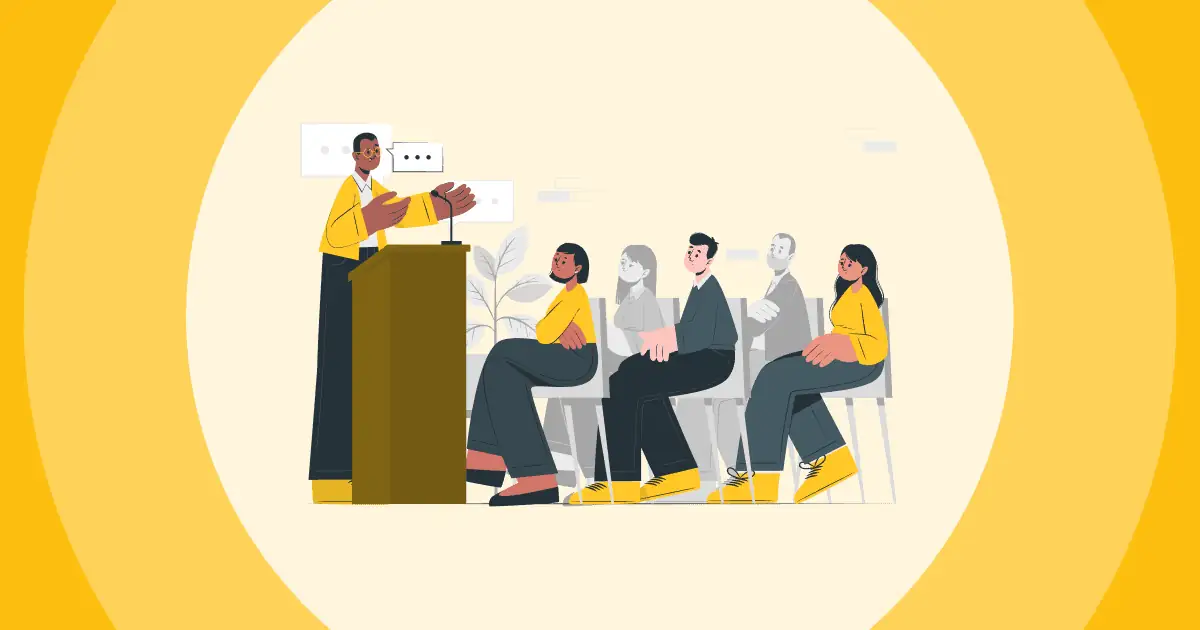

How to Use Speaker Notes Effectively: 4 Practical Tips
- The Speaker Lab
- July 30, 2024
Table of Contents
Do you ever feel like you’re forgetting half of what you wanted to say during a presentation? Or maybe you just wish there was a way to give your audience a little more context without cramming your slides with text? If this is you, then it’s time for us to introduce you to speaker notes. This trusty tool is something that every presenter needs but often underutilizes. When speakers do use them, however, they can create impactful presentations that resonate. In this article, we’re going to show you exactly why you need to make speaker notes your secret weapon and how to create effective ones.
Understanding the Power of Speaker Notes
Imagine this: you’re on stage, presenting a brilliant new idea. But then you see it—eyes glazing over in the audience. They’re lost in the sea of bullet points on your slides.
This, unfortunately, is a common scene that can be avoided with effective speaker notes. Speaker notes provide prompts for you, the one presenting, ensuring you cover all essential points in a clear and engaging manner. When you have speaker notes, you can avoid pasting your script on your PowerPoint slides, which gives your audience an opportunity to truly hear your message instead of just reading along with you. Speaker notes ensure you keep your audience hooked, leading them seamlessly through your narrative.
Find Out Exactly How Much You Could Make As a Paid Speaker
Use The Official Speaker Fee Calculator to tell you what you should charge for your first (or next) speaking gig — virtual or in-person!
Benefits of Speaker Notes
Speaker notes can significantly enhance both your preparation process and delivery. Let’s take a look.
- Enhanced Engagement and Eye Contact : You know what’s even more engaging than your best PowerPoint slides ? Actual, genuine human connection. Speaker notes empower you to maintain strong eye contact with your audience, drawing them in with your message and charisma.
- Deeper Audience Connection: Speaker notes help you deliver presentations in a natural, conversational style. By glancing at your key points and prompts, you’ll come across as conversational instead of robotic—fostering that speaker-audience bond.
- Increased Confidence and Preparedness: There’s nothing worse than when your mind goes blank during a presentation. With comprehensive notes as your trusty sidekick, those fears dissipate. You’ll feel far more confident striding onto that stage, ready to engage your listeners. And knowing your material backward and forwards empowers you to address audience questions with confidence.
- Effective Transitions and Cues: Co-presenting with others? Speaker notes can include smooth transition points for each speaker. They serve as a roadmap for seamless handoffs, keeping your presentation cohesive from start to finish. Want to highlight specific points during Q&A? Make a note to easily call back to important stats or insights.
How to Create Effective Speaker Notes
Now that you know why speaker notes are non-negotiable for success, let’s get down to crafting powerful, dynamic notes for your presentations.
The Art of Concision
The last thing you want is to create speaker notes that sound like a novel. Remember, these are prompts, not a script. Keep things concise, focusing on keywords, phrases, and cues that jog your memory rather than word-for-word paragraphs.
| Ineffective Note | Effective Note |
|---|---|
| “Discuss the staggering 82% of businesses using video marketing, highlighting its remarkable impact on audience engagement. Remember to emphasize how incorporating videos on landing pages and in email campaigns can boost conversion rates.” | “82% use video – engagement boost. Landing page & email campaigns boost conversion “ |
Crafting Engaging Prompts and Reminders
While keeping speaker notes brief, you also want to ensure they’re impactful.
- Spark Your Narrative Flow: Begin each slide’s notes with a concise point that summarizes the slide’s key takeaway. This will make it easier to edit notes later on.
- Trigger Powerful Stories and Examples: Rather than writing out long anecdotes, use concise bullet points that trigger the stories in your mind. These types of cues jog your memory more naturally than trying to read out a fully formed anecdote.
- Add Impact with Key Statistics and Numbers: Instead of forcing a dense table or chart onto your visual slides, add key stats directly into your speaker notes as points of reference for your audience. You can then leave information behind after your talks to ensure your audience remembers your key principles and methodologies.
- Weaving Seamless Transitions: For presentations with multiple speakers or complex narratives, consider adding clear cues and reminders into your notes. For instance, you can write “Transition to Sarah—Team Dynamics Case Study,” “Click to activate animation,” or “Pause for audience questions.” This way, your presentations flow smoothly without missing a beat.
Utilizing Technology for Speaker Notes
Take advantage of tech tools to create and maximize the power of speaker notes. For professionals who use Macs, Keynote offers a stellar platform for adding speaker notes , seamlessly integrated for smooth, captivating presentations.
If, on the other hand, you’re a PC user, there are tech tools for you too. Windows and Microsoft users can utilize programs like PowerPoint to seamlessly create presentations . Want more robust, advanced options? Check out platforms like Reveal.js Notes Server. No matter what your needs, there are speaker-friendly platforms out there for you to use. But remember, tools alone won’t magically elevate your presentations—crafting clear, engaging speaker notes should always be step one.
Get The #1 Marketing Tool To Book More Paid Speaking Gigs
This FREE tool helped one speaker book $36,000+ in speaking gigs before he had a website! Learn how you can use this tool to Get Booked & Paid to Speak™ on a consistent basis.
FAQs on Speaker Notes
What are speaker notes.
Speaker notes are additional information, prompts, or cues associated with each slide in your presentation. They’re visible only to you while presenting, helping you stay organized, on track, and confident on stage. Consider them your secret weapon for a more impactful delivery.
How do you write a note for your presentation?
Keep it concise. Think bullet points with keywords, short phrases, and triggers rather than writing out entire sentences. Include a concise point summarizing the main message of your slide, incorporate story prompts, jot down relevant stats, and if working with co-presenters, add cues for transitions.
Where can I find speaker notes?
Most presentation software programs (think PowerPoint or Keynote) have a designated section where you can add speaker notes. You’ll find them right beneath the slide you’re editing. During your presentation, speaker notes usually appear below your current slide, visible on your screen but hidden from the audience.
Crafting presentations shouldn’t feel like navigating a maze. Rather, they should be the directions you need to navigate your presentation with confidence. Indeed, when you master the art of writing notes, you have the power to transform a standard presentation into a truly remarkable experience. With your notes in hand, you can spend more time engaging with your audience and focusing on your message. The trick is to write notes that are too lengthy, so that you can glance at them, remember where you’re headed next, and keep talking. By incorporating strategic speaker notes into your next big presentation, you’ll take the stage with confidence.
- Last Updated: July 26, 2024

Explore Related Resources
Learn How You Could Get Your First (Or Next) Paid Speaking Gig In 90 Days or Less
We receive thousands of applications every day, but we only work with the top 5% of speakers .
Book a call with our team to get started — you’ll learn why the vast majority of our students get a paid speaking gig within 90 days of finishing our program .
If you’re ready to control your schedule, grow your income, and make an impact in the world – it’s time to take the first step. Book a FREE consulting call and let’s get you Booked and Paid to Speak ® .
About The Speaker Lab
We teach speakers how to consistently get booked and paid to speak. Since 2015, we’ve helped thousands of speakers find clarity, confidence, and a clear path to make an impact.
Get Started
Let's connect.
Copyright ©2023 The Speaker Lab. All rights reserved.

- PRESENTATION SKILLS
Writing Your Presentation
Search SkillsYouNeed:
Presentation Skills:
- A - Z List of Presentation Skills
- Top Tips for Effective Presentations
- General Presentation Skills
- What is a Presentation?
- Preparing for a Presentation
- Organising the Material
- Deciding the Presentation Method
- Managing your Presentation Notes
- Working with Visual Aids
- Presenting Data
- Managing the Event
- Coping with Presentation Nerves
- Dealing with Questions
- How to Build Presentations Like a Consultant
- 7 Qualities of Good Speakers That Can Help You Be More Successful
- Self-Presentation in Presentations
- Specific Presentation Events
- Remote Meetings and Presentations
- Giving a Speech
- Presentations in Interviews
- Presenting to Large Groups and Conferences
- Giving Lectures and Seminars
- Managing a Press Conference
- Attending Public Consultation Meetings
- Managing a Public Consultation Meeting
- Crisis Communications
- Elsewhere on Skills You Need:
- Communication Skills
- Facilitation Skills
- Teams, Groups and Meetings
- Effective Speaking
- Question Types
Subscribe to our FREE newsletter and start improving your life in just 5 minutes a day.
You'll get our 5 free 'One Minute Life Skills' and our weekly newsletter.
We'll never share your email address and you can unsubscribe at any time.
Few of us feel entirely comfortable writing a presentation. There is something very daunting for many people about the process of moving your thoughts from your head to paper (or a series of slides on the computer).
However, there are things that you can do to help yourself. These include knowing your material well and taking time to consider what you want to say.
This page provides advice on how to write a presentation. It discusses the initial writing, and then also explains how to review and edit your work. This will help to ensure that your presentation is as effective as possible.
Before you start...
Before you start to write your presentation, you need certain information: the objective, the subject, and details of the audience, for example. For more about this, see our page on Preparing Your Presentation .
Based on the information you have gathered, you should also have started to develop your ideas and select the main points to include. For more about this, see our page on Organising Your Material .
Some basic starting points
There are two really important things to remember when starting to write a presentation:
1. Give your presentation an introduction, a main message, and a conclusion.
Some people summarise this as ‘say what you’re going to say, say it, then say what you’ve said’ .
However, that is not the whole story. Your introduction needs to ‘set the scene’ a bit and give a broad outline of what you are going to cover in your presentation. If you are using presentation software such as PowerPoint, this should be a single slide. Your conclusion needs to sum up and present your main message to your audience, probably again in a single slide.
If you are taking questions after your presentation, and you are using PowerPoint, you will probably have a slide up on the screen during questions. You could, of course, have a final slide that says something like “Thank you for listening, any questions?”, or gives your contact details.
However, you could also leave up a final slide that highlights your conclusions.
This will help to ensure that your key messages remain in the minds of your audience.
2. Think about using stories to get your message across
We are hard-wired by thousands of years of evolution to listen to stories. Stories helped us survive by reminding us about important behaviours. We therefore tend to remember them much better than dry lists of facts or bullet points.
It is much easier to work with this than ignore it.
There are two aspects of this.
First, you should try to think about your presentation as telling a story to your audience. What is the point that you are trying to make, and how can you best get it across?
Second, it is helpful to use stories as part of your presentation . For example, if you start by telling a story or anecdote, it will act as a ‘hook’ to draw in your audience. You can also use stories to illustrate each point you want to make. Of course, your story has to link to your main message, because you can pretty much guarantee that your audience will remember the story much longer than the conclusion!
Structuring Your Presentation
The structure and content of your presentation will of course be unique to you.
Only you can decide on the best way to present your messages. However, you might like to consider some standard presentation structures for inspiration:
1. Harnessing the Power of Three
In public speaking and rhetorical debate, as well as in much communication, three is a magic number. The brain finds it relatively easy to grasp three points at a time.
People find three points, ideas or numbers, easier to understand and remember than four or more.
You could therefore structure your presentation using the magic number of three.
For example, your presentation should have three main elements: the introduction, middle and conclusions. Within the main body of your presentation, divide your key message into three elements and then expand each of these points into three sub-points. If you are using a visual aid such as PowerPoint, limit the number of bullet points to three on each slide and expand on each of these as you go along.
What should you do if you have more than three points to make?
Reduce them until you don’t have more than three points!
Your audience will probably only remember three of your five or six points anyway—but which three? Do the work for them, and identify the three most important points, and leave the others out.
2. What, Why, How?
An alternative structure uses the questions “What?”, “Why?” and “How?” to communicate your message to the audience. In a way, this also harnesses the power of three, but is a special case for driving action.
“What?” identifies the key message you wish to communicate. Think about the benefit of your message for your audience. What will they gain, what can they do with the information, and what will the benefit be?
“Why?” addresses the next obvious question that arises for the audience . Having been told “what”, the audience will naturally then start to think “why should I do that?”, “why should I think that?” or “why should that be the case?”. Directly addressing the “why?” question in the next stage of your presentation means that you are answering these questions and your talk is following a natural route through the material. This will ensure that you have the audience on your side immediately.
“How?” is the final question that naturally arises in the audience’s mind . They want to know how they are going to achieve what you have just suggested. Try not to be too prescriptive here. Instead of telling people exactly how they should act on your message, offer suggestions as to how they can act, perhaps using examples.
You should try to back up what you say with evidence. You can use case studies, personal examples or statistics here, but try to ensure that you use them in the form of stories.
There is more about this on our page Presenting Data .
Editing Your Content
Once you have a first draft of your presentation, it is important to review and edit this.
This will help to ensure that it really does get your message across in the most effective way.
When editing presentation content, you should consider:
The language . Make sure that what you are saying will be clear to your audience. Remove any jargon and try to use plain English instead. If necessary, explain terms when you first use them.
Sentence structure . Use short sentences and keep the structure simple. Remember that you will be talking through your ideas and that the audience will be listening rather than reading.
The flow . Make sure that your presentation structure leads your audience through your ideas and helps them to draw your conclusion for themselves.
Use metaphors and stories to aid understanding and retention.
‘Hooks’ to get and hold the audience’s attention . Ensure that you have included several ‘hooks’ at various points in the presentation. This will help you to get and then keep the audience’s attention. These might be stories, or audience participation, or some alternative visual aids , such as a short video.
Check, and double check, for spelling and grammar . Make sure that any presentation slides or illustrations, titles, captions, handouts or similar are free from spelling mistakes.
Ideally, you should take a break from the presentation before editing so that you can look at your writing with a fresh pair of eyes.
You might also want to ask a friend or colleague to have a look, particularly at the flow and the language. If possible, ask someone who is not familiar with the material .
A final thought
The actual writing of your presentation is really the final stage of your preparation.
If you have done your homework, you will already be clear about the reason why you are presenting, the subject matter, and the main points you want to make. Actually putting it down on paper should therefore be relatively straightforward.
Continue to: Deciding the Presentation Method Preparing for a Presentation
See also: Organising the Presentation Material Working with Visual Aids Coping with Presentation Nerves Dealing with Questions
How to Add Speaker Notes in PowerPoint (Tutorial)

Speaker notes in PowerPoint can be a lifesaver for presenters who need a quick reference during their talk. Instead of struggling to remember key points or losing your place during a presentation, you can have your notes right in front of you.
Whether you're a seasoned presenter or new to public speaking, this tutorial will help you feel more confident and prepared for your next presentation. With insights and practical tips from our in-house presentation designers , you'll have all the tools you need for success.
Let's dive in and explore how to add speaker notes in PowerPoint, taking your presentations to the next level!

In this tutorial, we’ll cover the following topics :
- Starting with the basics: How to add speaker notes in PowerPoint
- Ready to Captivate Your Audience? Let’s see how to view speaker notes while presenting
- From PCs to Macs, learn how to print speaker notes in PowerPoint
- Get answers to your FAQs and unlock tips for better presentations
Let’s start with the basics - or feel free to skip to your preferred section using the list above.
Adding speaker notes in PowerPoint
Adding notes to PPT is a reasonably straightforward process, regardless of your operating system. Here's how to add notes in PowerPoint:
- Select a slide you want to add notes to.
- View the Notes pane located beneath each slide. If it's not visible, you can make it appear by clicking Notes on the bottom taskbar.
- You will see a blank space with the prompt "Click to add notes." That's where you can enter your speaker notes.
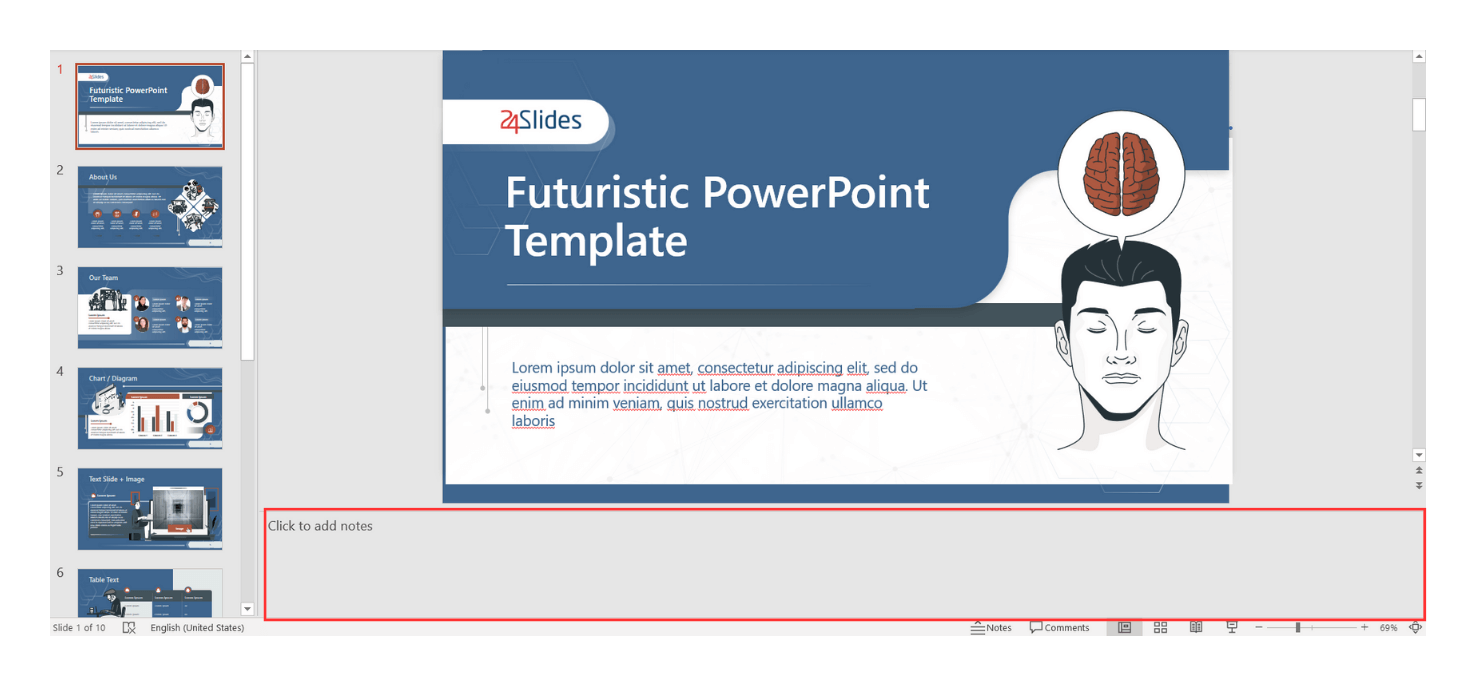
Pro tip: Add Notes Via Notes Page view
Are you looking to give an impeccably organized presentation? Feronika Wulandari , design manager from 24 Slides, has a pro tip for you!
"For presentations that will be copied or distributed to the audience as a reference later, it is crucial to provide detailed speaker notes. Merely looking at our presentation slides may leave the audience struggling to grasp the context.”
If you're aiming for an impeccably organized and informative presentation, Feronika's advice is invaluable. Take your presentations to the next level by utilizing the powerful Notes Page view in PowerPoint . This feature allows you to incorporate comprehensive speaker notes into your slides, ensuring your audience can fully grasp the context after the presentation.
In the Notes Page view, you have complete control over the content of your speaker notes. Customize the font size, and enrich the notes with images, shapes, charts, and more. You can even tailor the background color to suit your preferences or corporate branding. As Feronika says:
“In the notes view, we can include ample text to facilitate the audience's understanding of the presentation's context. It also is an excellent tool for attaching references and citations, particularly for content-heavy presentations like scientific ones.”
Ready to try it out? Here's how you access the Notes Page view:
- Click View .
- Look for the Presentation Views section .
- Select Notes Page .

If you want even more control over how you want your notes to look, you can check out the Notes Master . This is how you can try it out:
- Look for the Master Views section .
- Select Notes Master.

Here you can choose the design and layout of the notes page and select options for your page setup. This is what the Notes Master looks like:
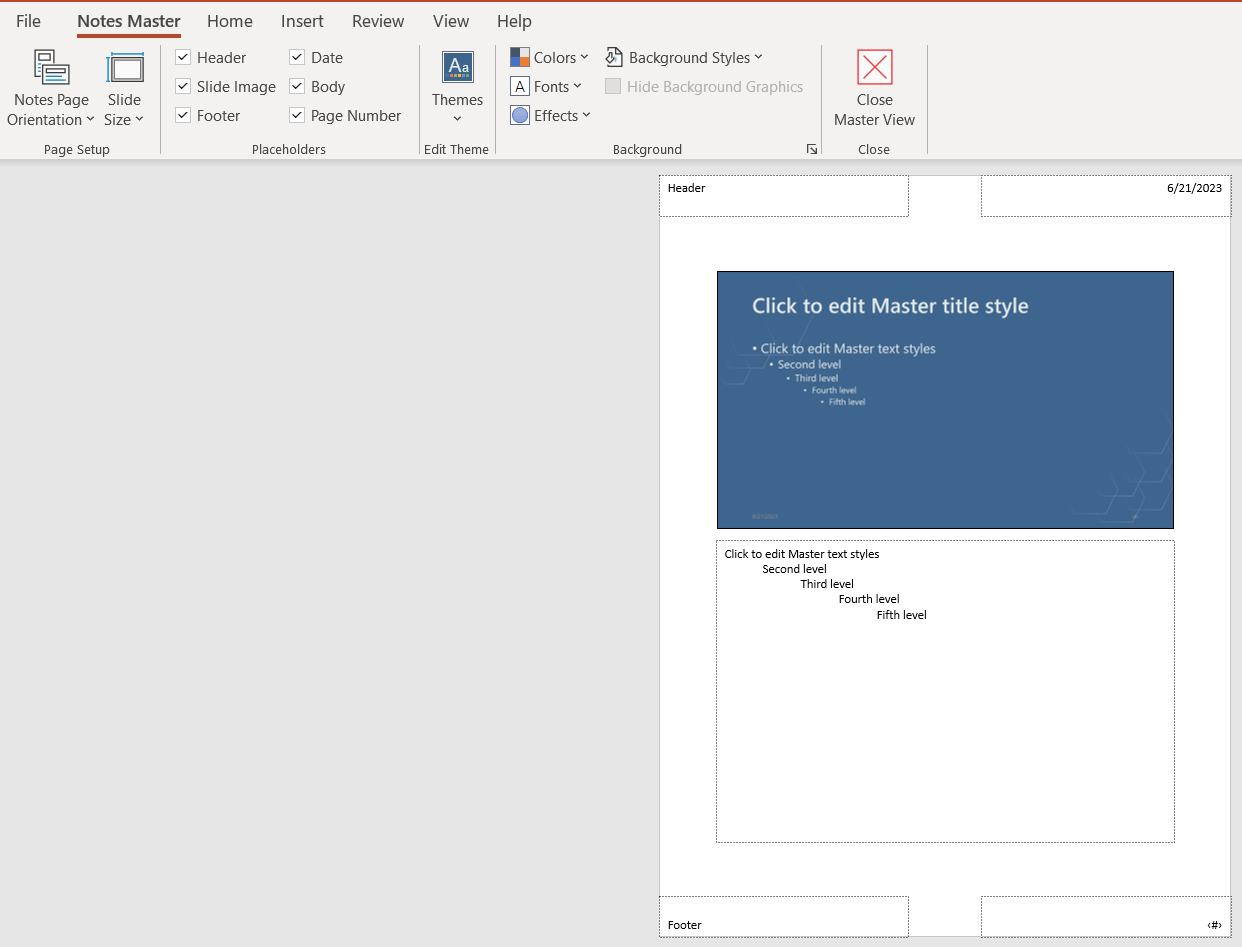
Now that you know how to add notes to PowerPoint, let's see how to present PowerPoint with notes.
Ready for your next presentation? Check out how to see speaker notes while presenting
To prepare for your next presentation, follow these steps so you can have your notes on hand without your audience being able to see them. First, click on the Slide Show tab , and select the box Use Presenter View . This is what the Presenter View in PPT looks like:
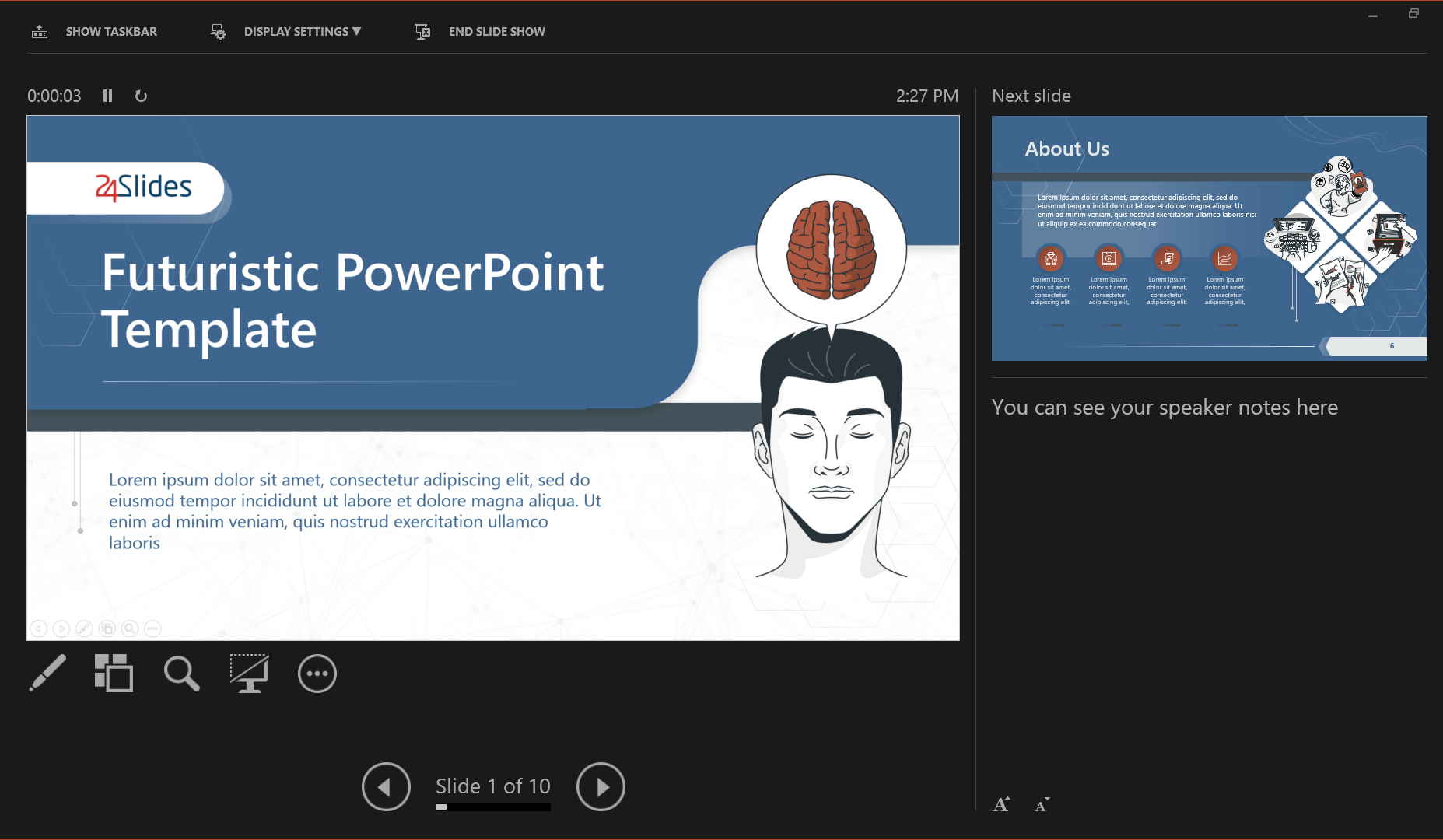
To access the presenter view, start your slideshow and then click on the left button of your mouse. From the options that appear, select Show Presenter View .
And last, learn how to print notes in PowerPoint
Printing PowerPoint presenter notes can be done in different ways, depending on your operating system. Let's look at each one of them.
How to print Speaker Notes (PowerPoint - Windows)
- Click File in the top left corner.
- Choose Notes Pages from the Settings dropdown menu.
- Adjust any other printer settings.
- Click Print .
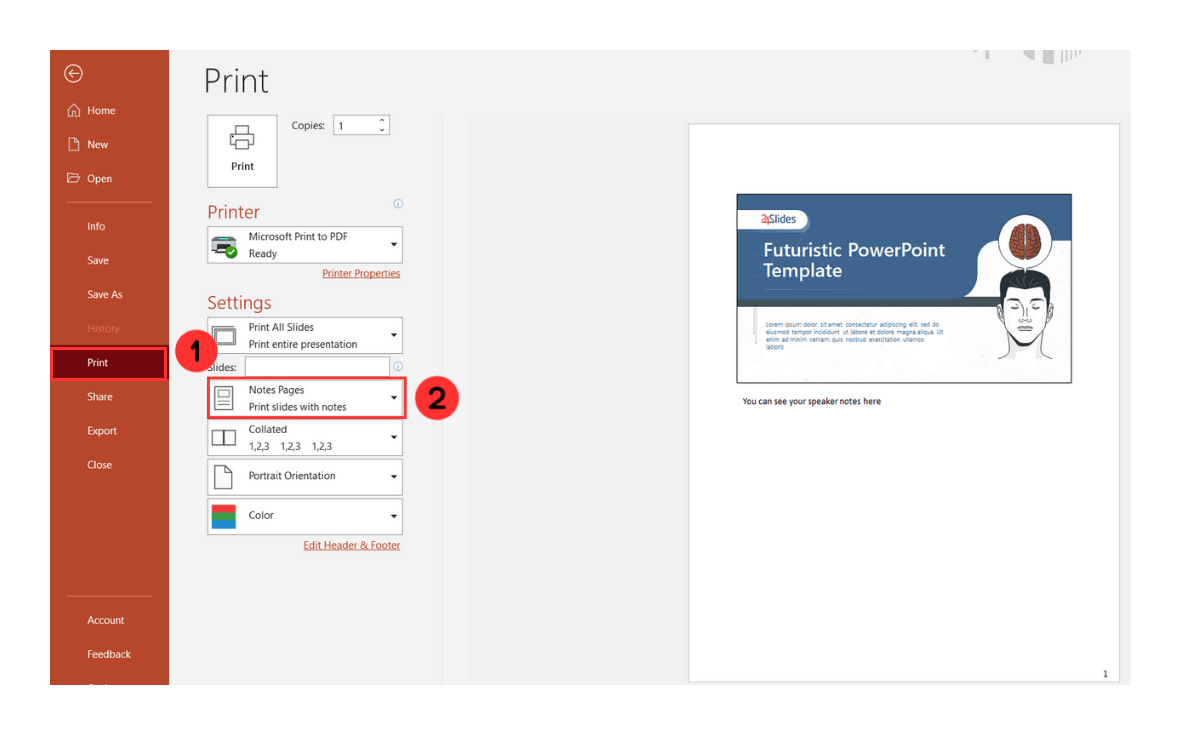
How to print Speaker Notes (PowerPoint - macOS)
- Click File .
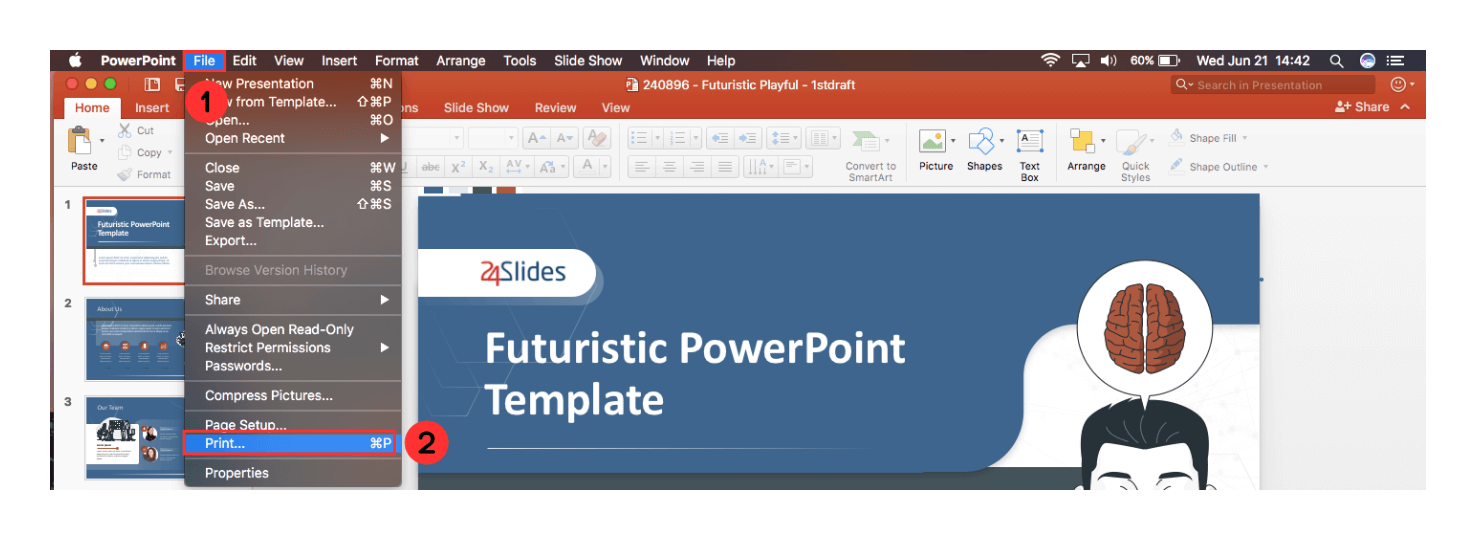
3. Click Show Details .
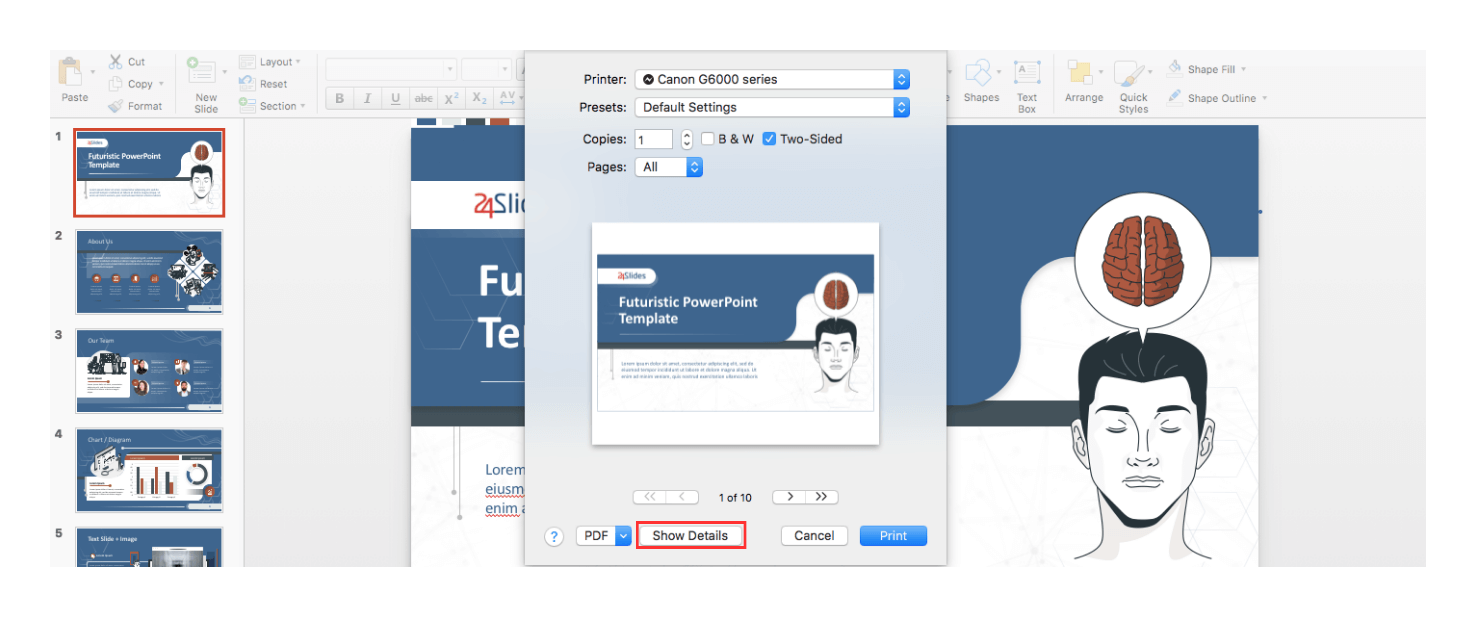
4. Select Notes from the Layout dropdown menu.
5. Adjust any other printer settings.
6. Click Print .
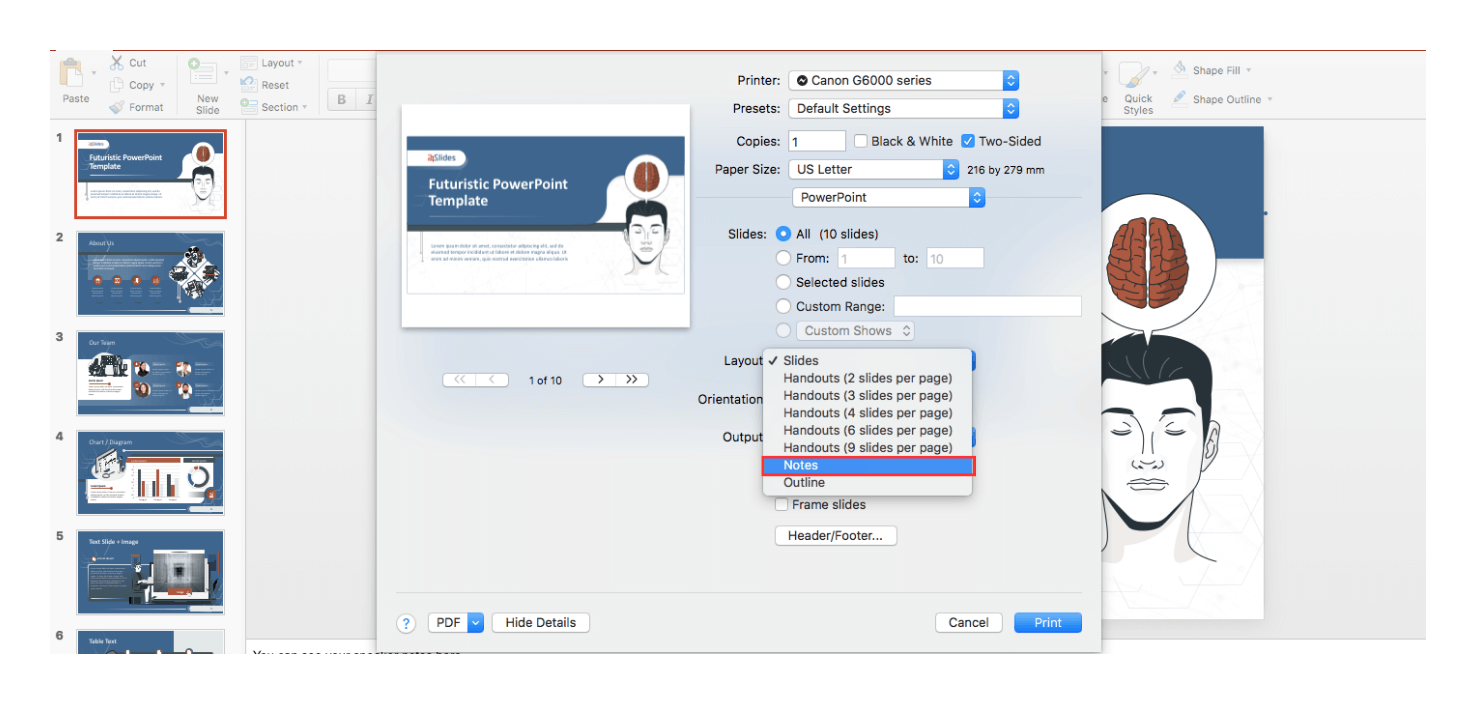
You may also want to know: How to print notes without slides?
If you want to print speaker notes only, this is what you should do:
- Go to the View tab and click Notes Page . On each page, you’ll see a thumbnail of the slide and the notes it has.
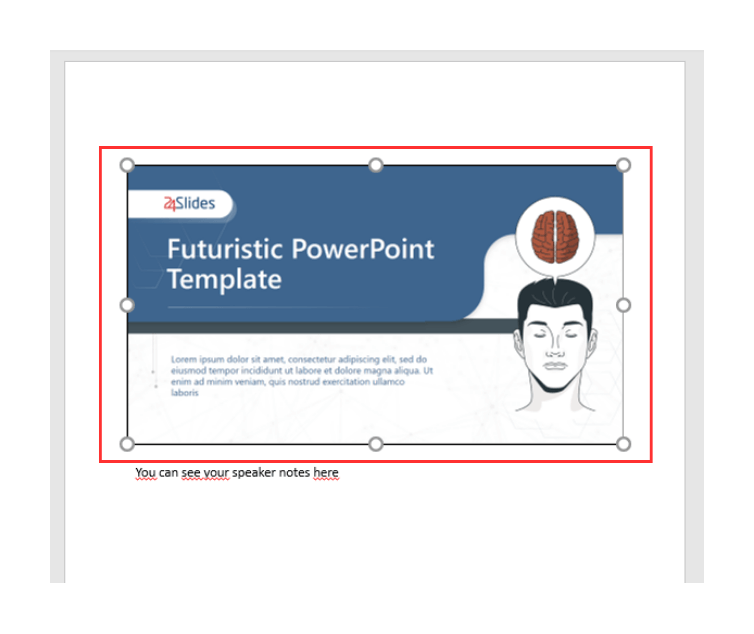
2. Select the thumbnail on each page and press delete . Repeat this step for each notes page.
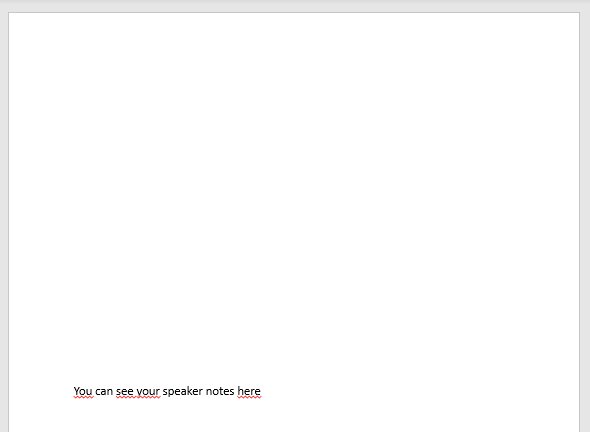
3. Finally, go to the File tab and click Print. Now, repeat the note-printing process shown in the section above.
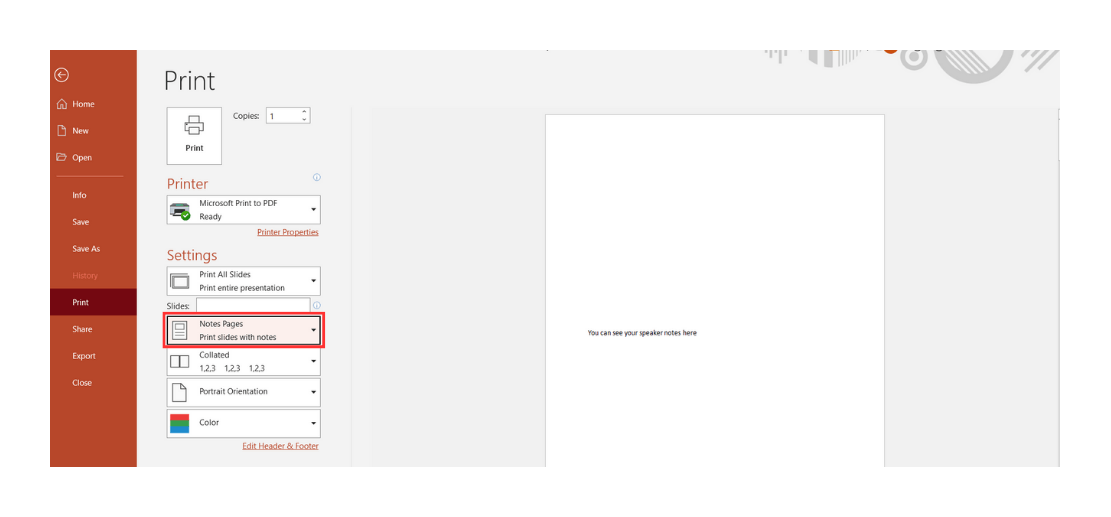
How to print PowerPoint slides with notes: Multiple per page
If you want to print multiple slides on the same page, including the notes, follow these steps: 1. Open the File menu, select Export , and click on Create Handouts.
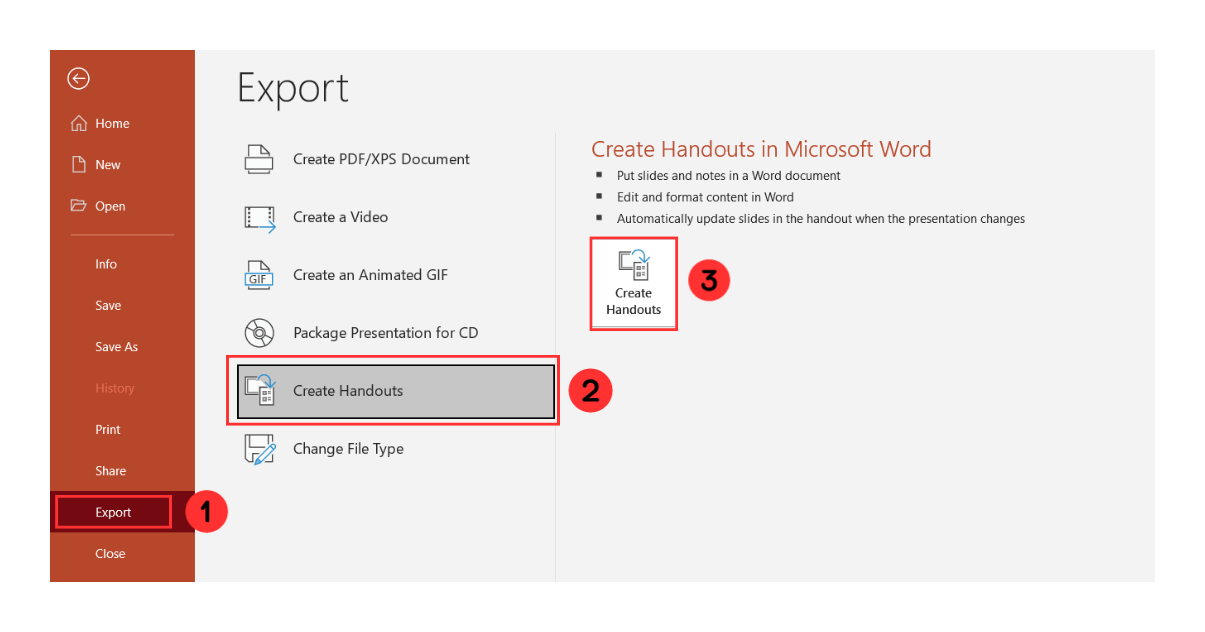
2. Select Notes next to slides , and click OK.
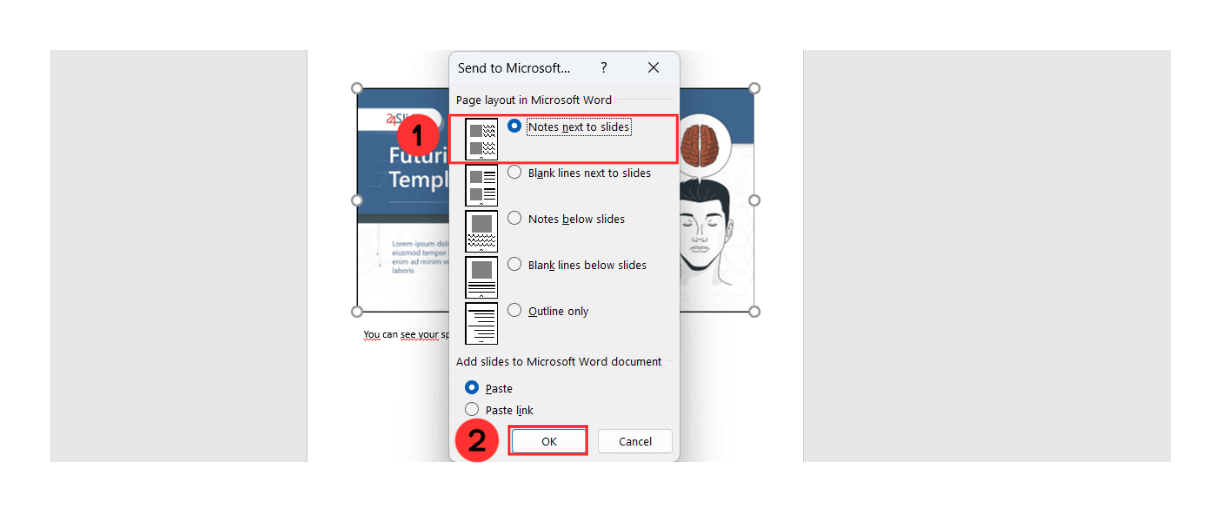
This will begin the export to Word, where you can finish printing your slides and notes as a document.
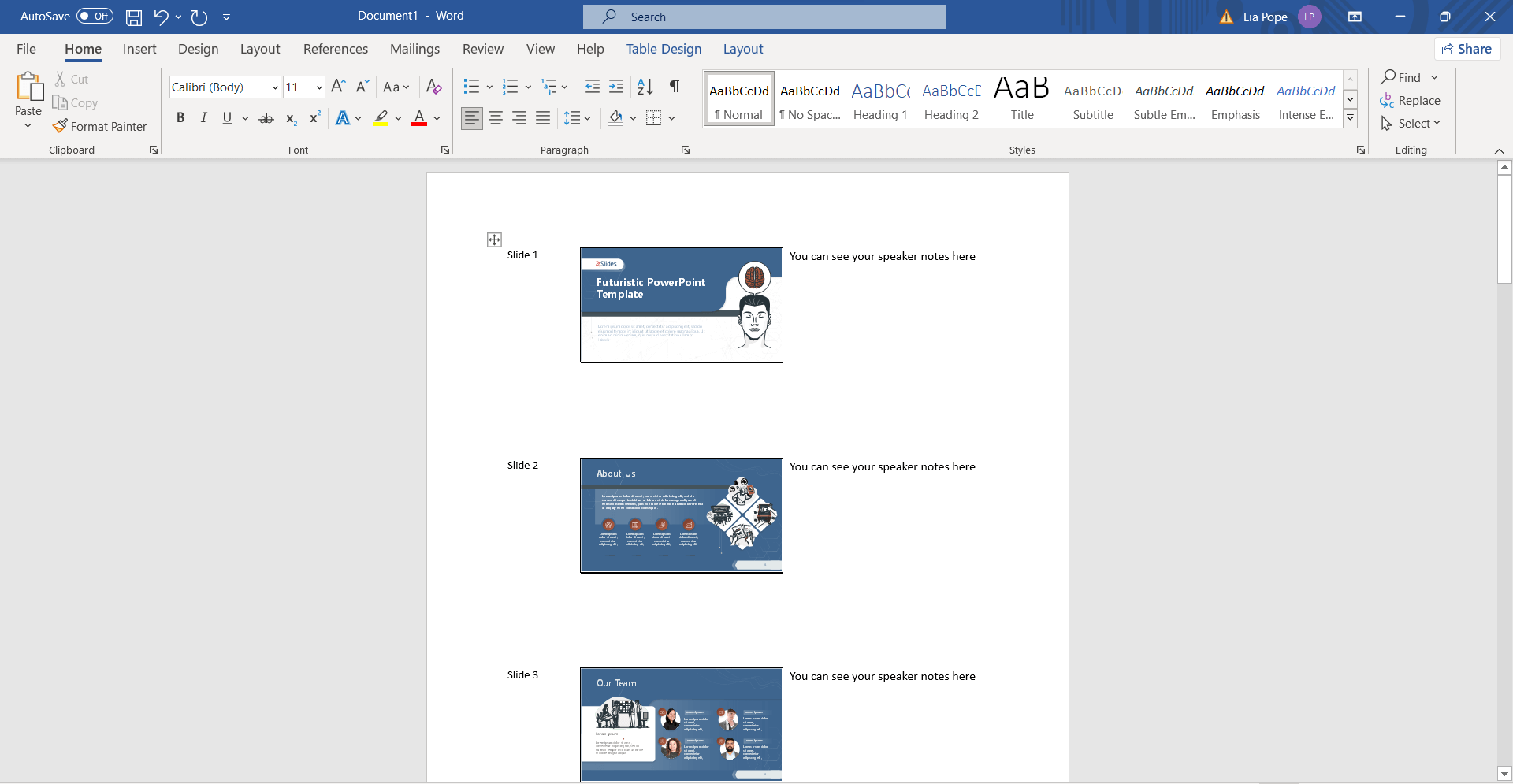
Customer Frequently Asked Questions
What are speaker notes in powerpoint.
Speaker notes on PowerPoint presentations are a feature that allows presenters to add additional information that won't appear in the presentation slides.
PowerPoint notes can be used to provide additional context and details about the content on the slide, such as statistics or critical messages. They can also help emphasize specific points without cluttering their slides with too much information. They are a valuable tool for presenters to keep essential points at hand while giving a presentation.
These are some examples of speaker notes in PowerPoint:
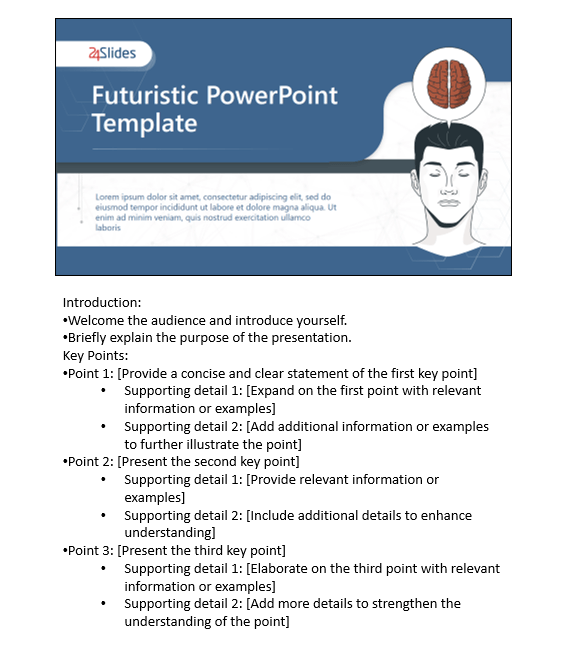
Benefits of using speaker notes in PowerPoint
Why add speaker notes to PowerPoint? Learning how to use notes can be a game-changer , it can benefit you in many ways.
Speaker notes on PowerPoint can help you recall important points and key messages as you give a presentation. They also provide a security blanket, giving you the confidence to deliver your speech without worrying about forgetting something.
Remember, not worrying about memorization can help you prioritize inflection and tone and make you look more professional and connected with your audience.
How do I edit slide Notes?
A good thing to remember is that you can edit your speaker notes anytime you want. So, if there is a last-minute change or a new detail you would like to consider, you can follow these steps:
- Select the slide where you want to edit notes.

You will be able to see the Notes written in the Notes Pane . Click inside it so you can edit de content. Click outside the Notes Pane to save your changes.
What is the use of Notes Page view?
The Notes Page view is a PowerPoint feature that can help you upgrade your note-taking experience . Rather than presenting your notes in a simple text format, this feature presents them as individual pages with diverse layouts, colors, and formatting options for you to explore and customize.
If you would like to check out this feature, check out our Notes Page View section .
What is the advantage of the Notes Page view?
So, why is this feature impressive? Well, the Notes Page view offers several advantages that simplify the management of your notes:
- Organization: When it comes to giving presentations, being organized is essential. You can't afford to waste time deciphering your notes. With the Notes Page view, you effortlessly organize them into distinct pages, sections, or categories, allowing you to find what you need quickly.
- Personalization: The Notes Page view also puts you in complete control. It lets you customize the appearance and layout of your notes according to your preferences. You can explore a wide array of templates, themes, and styles, making your note-taking experience unique.
What is the difference between Slide Sorter view and Notes Page view?
The Slide Sorter view and Notes Page view are two different viewing options in PowerPoint .

The Slide Sorter view in PowerPoint provides a condensed and sequential display of all the slides in your presentation. It presents miniature versions of each slide in a grid layout, allowing you to manage the order and structure of your presentation easily.
This view is beneficial when you need to reorganize your content or gain a quick understanding of your entire presentation at a glance.
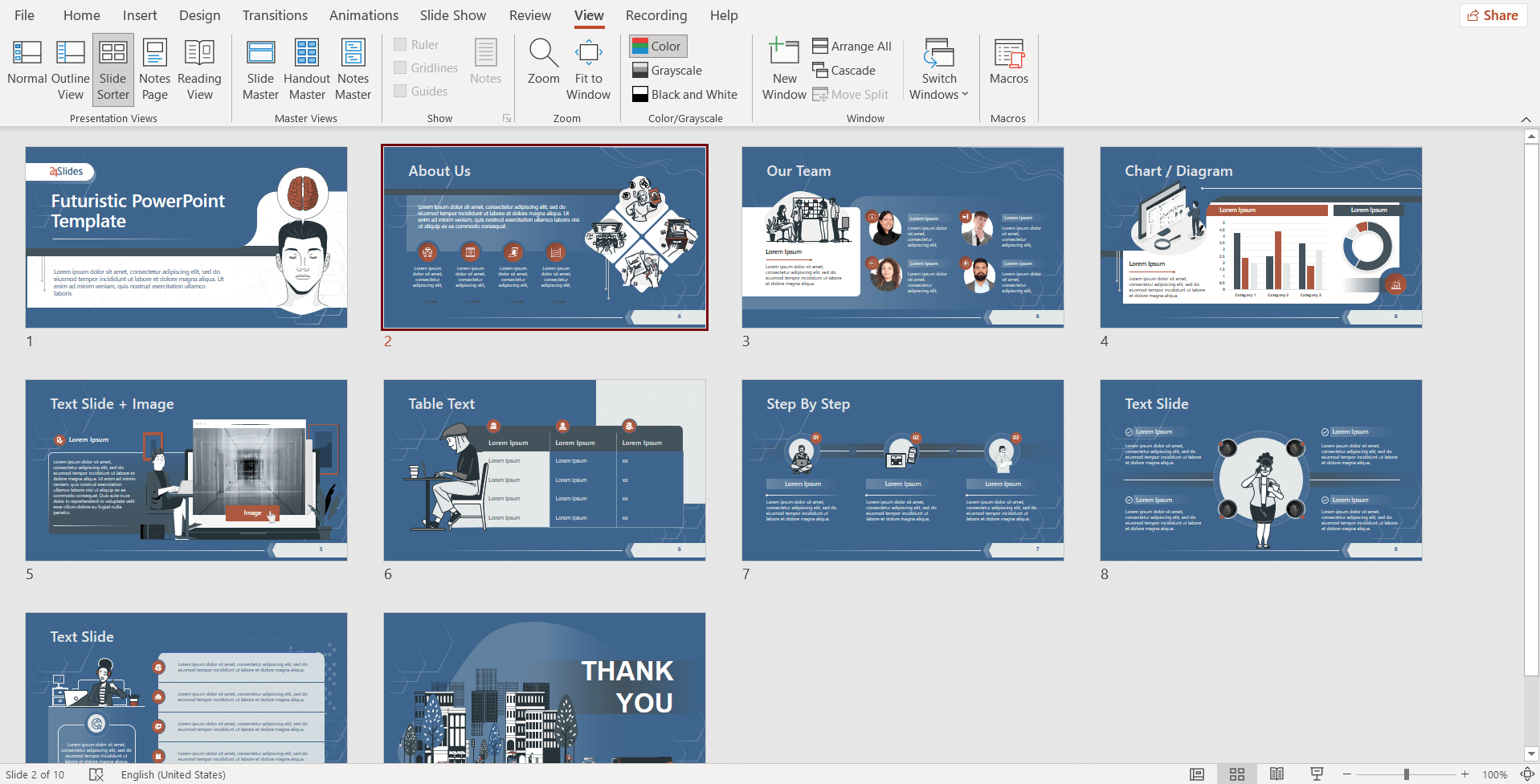
On the other hand, the Notes Page view allows you to see your slides along with any accompanying speaker notes . It is ideal for creating and reviewing speaker notes, providing a dedicated area to jot down the additional information you want to reference during your presentation.
You can customize and format your notes as needed, making them a valuable resource for guiding your delivery or providing more in-depth explanations.
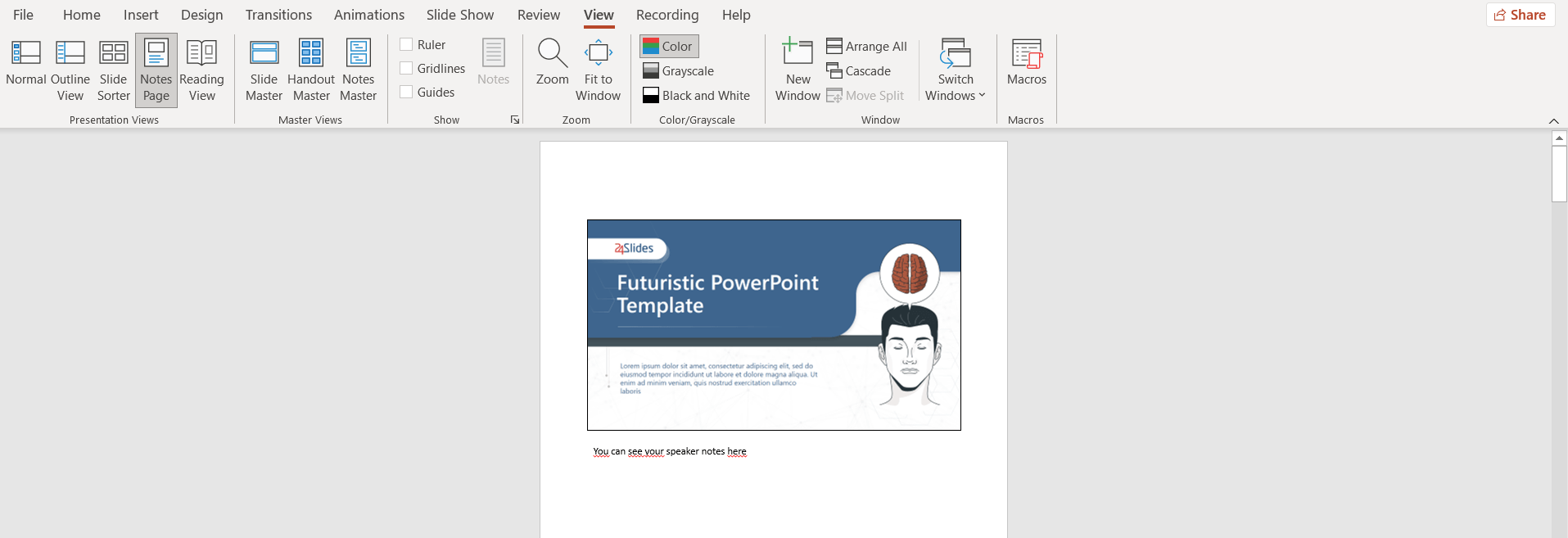
Get outstanding presentations that make you stand out from the crowd!
If you want to improve your presentation skills and give a more professional image to your business, this tutorial can help. However, the design for your presentation is crucial, and that's where our presentation design solutions come in.
At 24Slides , we transform presentations from "good" to "extraordinary," saving you time and effort. Say goodbye to long working hours on PowerPoint and let our design experts amaze you overnight!

You might also like these articles:
- How to Add a Timer to Your Powerpoint Presentations
- How to Make a PowerPoint Slideshow that Runs Automatically
- How to Create Your Perfect Webinar Presentation (+Examples)
- Master Slides 101: How to Create and Use Master Slides in PowerPoint
- How to Track Changes in PowerPoint
Create professional presentations online
Other people also read

Tutorial: Save your PowerPoint as a Video

How To Convert Google Slides To PowerPoint and Vice Versa

How To Add Animations To PowerPoint
- Using notes when presenting – best practice

Successfully persuading an audience

How do you use acronyms in presentations?
This article contains best practice tips and answers to the most common questions related to using notes when presenting.
Using notes within a presentation is a topic that regularly gets asked about during my presentation skills training sessions. (Both novice and experienced speakers have LOTS of questions about when and how to use notes during a presentation!).
To help you use and format your presentation notes in the most useful way, I have collated some of the most common questions (and answers) that I get asked relating to using notes during a presentation or speech.
I hope that you find these best practice tips for using notes when presenting useful, and please keep checking back, as I will add to this article as more questions come up.

Want to watch this article as a video?
Key questions related to using notes when presenting (click each question to jump to it).
Should I use notes when presenting?
What are the benefits of using notes in a presentation.
Do I have to hold presentation notes in my hand?
How should I format my presentation notes?
How do i make cue cards for my next presentation, should i have my presentation notes on my phone, how should i use notes when presenting online, what is the most important thing to remember when using notes in a presentation.
One of the most common questions asked by speakers that are keen to grow and develop is: “Should I use notes when presenting?”.
Notes should always be used if they increase your ability to deliver your message clearly, confidently and concisely.
Why? Remember your public speaking goals.
For a successful speaker, the goal is always to impart their message in a clear, concise and confident manner. If you do not achieve this, then your message is unlikely to be heard, and your audience will not be able to act upon it.
Think of all of the presentations or speeches that you have attended in your life. It is highly unlikely that you wanted the speaker to become confused, forget their words and not be able to deliver their message. That would have been a waste of time for you and them, and likely have made you both feel incredibly uncomfortable.
Your audience wants you to succeed. They want to hear your message.
If you need to have notes to successfully deliver your message or presentation, then go for it.
Using notes for your next presentation guarantees that you will be able to recall and deliver your message clearly, confidently and concisely as you will always have something available to refer to, if you get stuck or forget your words.
Your audience wants you to succeed and deliver your message. They would therefore prefer that you have notes and are able to deliver your message, than not have notes and not be able to complete the presentation.
You should always have notes to support you as a speaker, if you feel you need them.
Rich shares his thoughts on this question in this recent video...
Click the video to watch this question answered by Rich Watts, public speaking expert and 2x national public speaking champion.
To view more public speaking tips videos, visit our Rich Public Speaking Instagram account here.
Do I have to hold my presentation notes in my hands?
If you feel confident that you won’t need to consult your notes every few seconds, then you may benefit from having your notes nearby (for if you need them), but not permanently in your hands.
For example, you may wish to have a copy of your notes stored in your jacket or trouser pocket, or on a table nearby. Then, if you need them, they can be easily consulted. However, if you do not need to consult these ‘hidden’ notes, then the audience will never know that they existed, and you will appear as a super confident speaker, with your whole speech or presentation memorised!
Think of this set of hidden notes as a safety net - there if you need them, but hopefully you won’t!
Remember that your cue cards or presentation notes are a visual element of your presentation. Their appearance to the audience can impact your success as a speaker.
Our audience makes conscious and unconscious judgements about our abilities as a speaker, based on our visual appearance. How would you feel about someone wearing mechanics’ overalls undertaking open heart surgery on you? Similarly, how would you feel about a person in a formal suit and tie completing structural works on your home?
Your notes should reflect positively on you as a speaker.
Best practice tips for cue cards for a presentation include:
Ensure that your notes are printed or written on good quality card., the reverse of the card (facing the audience) should be blank..., keep your cards small (a5 size is ideal)..., keep the number of note cards that you have to a minimum..
- The best format for presentation notes is a set of short prompts that trigger your brain to recall the sentences and messages that you want to impart. Ideally they should be a list of words that will aid your recall. Your rehearsals will ensure that your brain recognises the words on your note cards, and can then recall the rest of the sentence, paragraph or message that you want to present.
- Avoid writing out long sentences or every word of your presentation. This will increase the chances of you simply reading your presentation off of your notes. If you do this, you are unlikely to build rapport or engagement with your audience as you will not be able to make eye contact with them as you present.
- Your prompts within your presentation notes should always be clearly written and well-spaced. Check that you can read them from a distance, without squinting or straining, to avoid any confusion or distraction when you are presenting on the day.
It is becoming increasingly common for presenters to refer to notes that they have written on their phone, whilst they present.
Opinion is split on doing this. Some people believe that it appears lazy and informal, whilst others recognise it as an efficient and useful way to successfully present.
For now, as a speaker you will need to make an informed decision about the opinions of your audience before using notes from a phone or iPad. If you are in any doubt, avoid using a phone or tablet for notes, as you do not want it to frustrate your audience or distract from your message.
Generally, for more formal events it is recognised that using printed, well-formatted notes is preferable. For shorter, more informal gatherings, reading notes from a phone or tablet is viewed as more acceptable.
This will likely change further over time.

Presenting online is becoming increasingly common, but the challenge of remembering your key messages and using notes remains.
Many online presentation platforms, such as Zoom and Google Meets, allow you to have notes open on a separate screen or monitor, that is not shared with the audience online. However, many of us do not have multiple monitors or screens available to us, and if we do, breaking eye contact and regularly turning our head to the side to consult notes is certainly not viewed as presentation best practice.
The best way to format your notes when presenting online is to have a digital note positioned on your screen just below your camera. If you cannot have a digital note because you are sharing your screen with your audience, then place a handwritten or printed note just above and behind your camera. This can be consulted without seeming to break eye contact with your online audience.

The most important thing to remember about using notes in a presentation is that using notes is a must, if you feel that they will improve or guarantee your ability to deliver your message clearly, confidently and concisely.
Your audience will thank you for it - they want to hear your message.
For more best practice tips and advice, please consult our public speaking blog here .
If you have a question about any area of public speaking that you would like answered, please contact us here.

Quick notes – Structuring a presentation

Quick notes – Opening your presentation
Comments are closed.


VisualStory®
- Duarte DataStory®
- Presentation Principles™
Slide:ology®
Slide Design
Speaker Coaching
- Presenting Virtually™
- Illuminate™
- Adaptive Listening™
- Team training
- Learning journeys
- Brand and product storytelling
- Keynotes and events
- Sales enablement
- Communication systems
- Accelerator Lab™
- Our culture
- Our leaders
- Case studies
- Media mentions
- Guides and tools
- Learner support

Everything you need to know about using speaker notes in PowerPoint®

Chariti Canny
Through preparing for our Slide Design training , we realized there’s a feature that many presenters don’t realize plays a key role in slide design and speaker support: speaker notes in PowerPoint®.
To use your speaker notes in PowerPoint most effectively during your next talk, follow the tips below.
What are speaker notes in PowerPoint?
Speaker notes in PowerPoint help presenters recall important points, such as key messages or stats, as they give a presentation. Some presenters even upload their whole script in there!
Even if you aren’t writing a complete script, using speaker notes for the high-level points of your script will help you match your talk track to what’s happening on the current slide you’re on.
It can also be handy for other purposes, such as:
- Adding nuanced information about a slide’s graphics
- Giving instructions for how to click through an animation
- Adding links to important files
- Providing stage directions
- Giving reminders of when to pause or give an anecdote
- Setting up triggers for gestures to a co-host or the audience
- General note-taking – just like if someone would use a scratch piece of paper

What are the benefits of speaker notes in PowerPoint?
You are the storyteller, and your slides are your support, forming the atmosphere and emphasizing your key points. Because there’s a limit to how much information people can process at one time — they will either listen to you or read your slides — it’s important to show only information essential for your story.
Speaker notes in PowerPoint allow you to move nonessential text and stats off your slides so that your audience can fully absorb your message. Having the info in the speaker notes allows you to be ready should your audience ask questions about your data , or other points in your presentation that may require additional information.
Though speaker notes should be a somewhat simplified version of what you are saying, using them for the high-level points of your script will help you match your talk track to what’s happening as you move through your presentation.
Spending a little time structuring speaker notes in PowerPoint can also be an easy way to turn your presentation into a dual-purpose file. Not only can you use your file to present, you can also use it as a standalone document that can be effectively shared without you presenting. This more advanced feature is described below.

How do I add speaker notes in PowerPoint?
There are two ways to add speaker notes in PowerPoint.
Method no. 1
Directly edit in slide editing mode (aka Normal View). Click the “Notes” section of the window and begin typing. If the “Notes” section is hidden, click the “Notes” button found in “Options” on the bottom right of the PowerPoint screen.

Method no. 2
Edit your notes in “Notes View.” Click on the “View” tab in the ribbon and click “Notes Page.” Here you have more room on the screen to write your notes and adjust the font size and layout.
How should you write speaker notes in PowerPoint?
Although some people feel more comfortable putting their complete script into the speaker notes section, one could also be brief in the notes, allowing them to sound more authentic when presenting. I have worked on a lot of high-stakes presentations and have seen this done both ways with success. So, it depends on your comfort level and ability with public speaking .
The first bullet point of your speaker notes can convey the overarching idea for the slide, and your other points can support it. I call these speaking touchpoints, and often they are short words or phrases that will remind me of what I want to say.
If one of your supporting concepts involves telling an anecdote or story (which we teach and recommend in all of our workshops, by the way!) you can trigger your memory by leaving a note to yourself in brackets. For example, you could type:
- As a company, we’ve been through difficult times before
- [Story: 2008 financial crisis]
It’s also important to keep these simple because the space to view them is limited. Though, there are times when a more elaborate note needs to be included. I’ve found that including a very important phrase in full is one of my favorite things about speaker notes. We often spend a lot of time crafting that pivotal moment, the pace of it, and the wording. Leave room to easily see it in presenter view.

Once, I sat through a presentation where the presenter stayed on one slide for quite some time. He was telling a long story that was coming back to resolve and tie together various points of information on the slide. To help himself stay on track, he wrote about six key speaking touchpoints in a list in the speaker notes, duplicated the slide (so it looked the same to the audience), then completed his next few speaking touchpoints for the slide. When he reached the bottom of the first six touchpoints he clicked the slide without missing a beat and continued the talk track. The audience had no idea that he just moved slides and he was able to use his notes, even though they were long.
The speaker notes are also an opportunity to include “stage directions.” These can be anything from reminding yourself to click and advance an animation, gesture to a co-speaker or member of the audience, or even take a breath and pause.
How do you project speaker notes in PowerPoint during a presentation?
PowerPoint is set up to show notes only to the speaker when a presentation is connected to another output, such as a monitor, a projector, a video conferencing app, etc. Just select the “Slide Show” tab and click “Presenter View” to enable a display that only you can see on your computer.
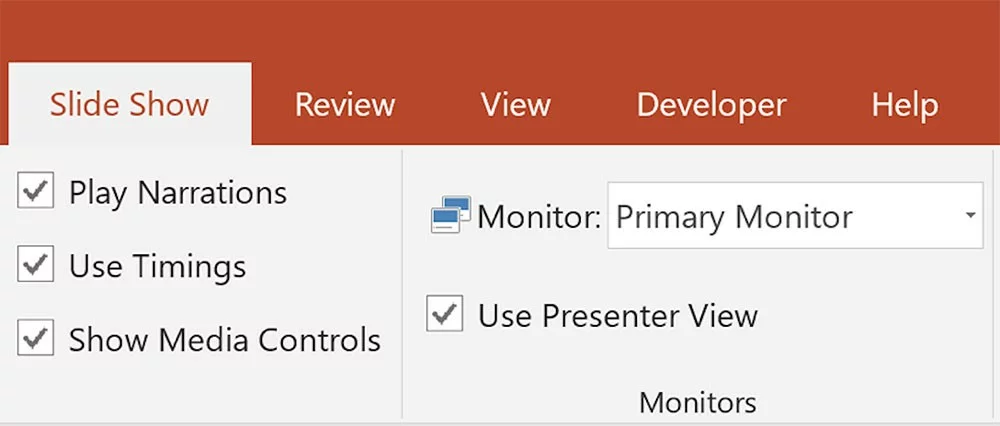
You’ll see your slides, speaker notes, and even a timer, but your audience will only see slides projected on a monitor or screen.
How else can I use my speaker notes in PowerPoint?
I mentioned that you can structure the Notes pages to act as a standalone document that can be shared without you presenting. This is a more advanced way to use notes, but extremely valuable.
Let’s say your presentation wowed your audience so much that they requested copies of your slides so they can reference them later, or share with others. Because you created a presentation meant to be shown, not read, chances are that your file won’t make sense to someone who wasn’t in the room.

Unless, of course, they can read and make sense of your speaker notes. Speaker notes can be used to create beautiful presentation artifacts for your audiences. By giving people a physical reminder of your presentation content, they’ll keep thinking about your talk long after you give it, and they’ll more easily share your message with others.
We recommend you do this with Slidedocs ®, a skimmable visual document that is a version of your slides meant to standalone. It’s great for pre-reads before meetings, leave-behinds at a presentation, or of course, a summary of your great presentation without your messy speaker notes and stage directions in there!
David Allen, the author of the bestselling series Getting Things Done , leaves information behind after his talks to ensure that his audience remembers his key principles and methodologies.
After we created a cinematic presentation for David, we translated the rich, evocative images and layouts of his presentation into handouts using our Slidedocs® methodology so that anyone could read and understand his message even if they didn’t attend his presentation.
How can I use speaker notes in PowerPoint to create handouts?
Step 1: First, make the overall changes to the Notes master, such as how you want the slide image to appear and how much space you want your notes to have.

Step 3: Next, make changes to the layout in the Notes Master, keeping in mind that changes here will be reflected on all the notes pages.
In the image below, an example of a default Notes Master is shown at left, with a redesigned Notes Master on the right. In the modified version on the right, the slide image was resized and moved to the top left, and the notes box was reformatted and moved.
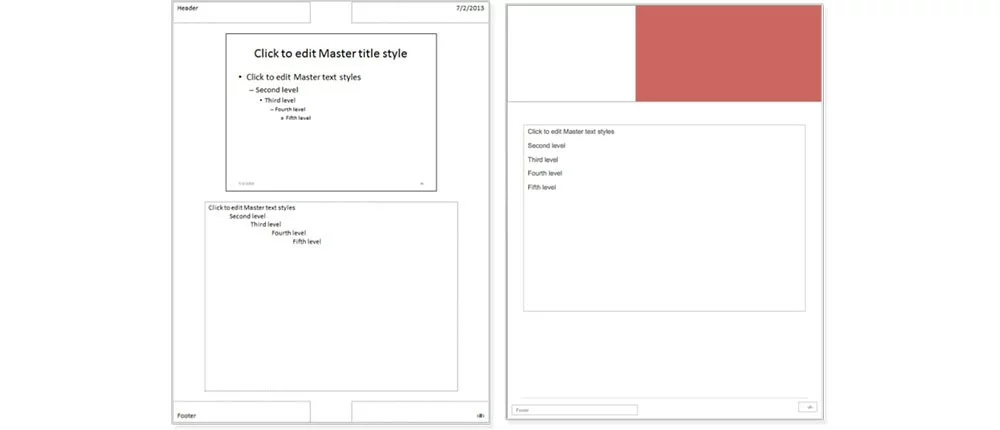
Not only can the Notes Master be adjusted, but each Notes Page itself can have text, charts, quotes, and images added as separate and additional content to augment what’s on the surface slide.
You can scale your slide thumbnail to any size and place it anywhere on the master. Headers, footers, and the note placeholder can be moved into any position you’d like. You can add objects to the Notes Master, but remember that objects added in Notes Master will appear on every slide’s notes page.
Thus, you must be strategic about what you add. To that point, adding a logo or some other universal image would make sense in the Notes Master.
Step 4: Once the Notes Master has been restructured, return to Notes Page View: View tab > Notes Page. You’ll see that the notes format matches the changes you made in the Notes Master.*
Step 5: For each page, add any custom graphics, data, text, or other items that relate to that slide. Remember, these will not appear on the slides. They will only appear in these notes.
In the layouts we created for David Allen below, we placed a small image of the slide on the top left of the page and a graphic and quote at the top right.
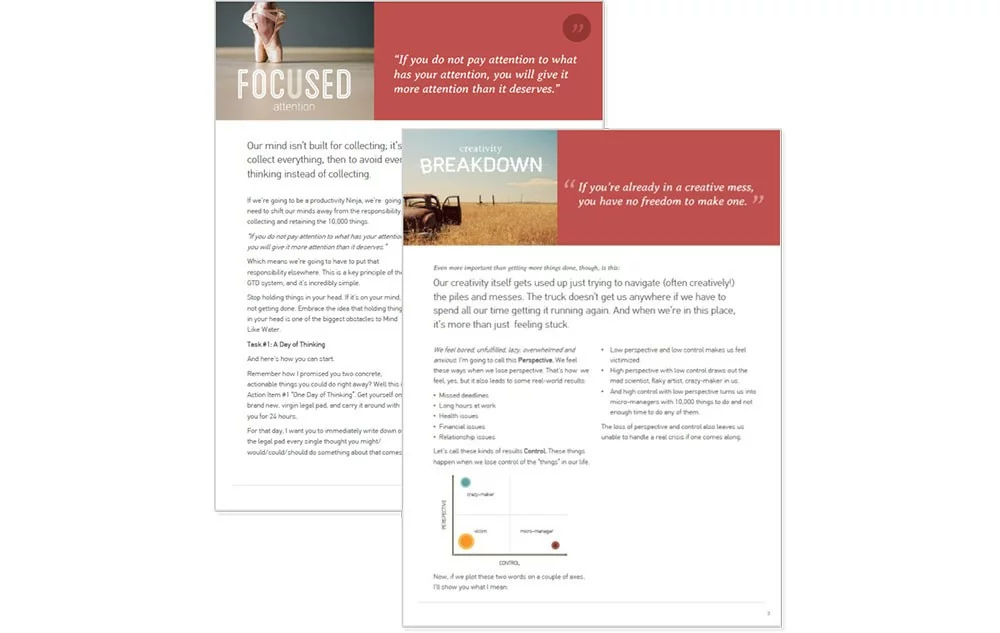
How do I print speaker notes in PowerPoint?
Perhaps you’d rather print out your notes instead of viewing them digitally on a monitor. Or maybe you’ve gone the extra step and customized your notes and now you’re ready to distribute them to your audience.
Step 1: Click the File tab and select Print to open the print dialog.
Step 2: Pull down the second menu within the Settings options. PowerPoint defaults to the Full Page Slides option, and you’ll need to switch it to Notes Pages option.
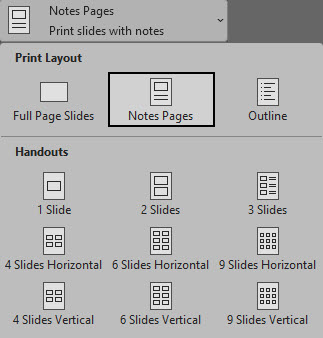
Now you can print the file in Notes Page View to give a hard copy to your audience.
Note: Image resolutions may be slightly less in printed or PDF Notes View. Text and shapes will remain the same.
By putting thought into how you prepare, use, and re-use your speaker notes, you ensure that your message resonates long after you and your audience leave the room.
How to get expert PowerPoint help the easy way
If you have a big, high-stakes presentation coming up, and would like additional help on crafting your speech, delivering your keynote, designing your slides, or engaging an audience to take an action, our Consulting services are here to help!
Talk to a Solution Architect about your needs, we’ve done the presentations, keynotes, and speeches for the big stages like HubSpot’s INBOUND , Salesforce’s Dreamforce , and many other events in between.
If you’d like to train up your team on better presentation design skills, we recommend talking to a Training Concierge about building a custom learning journey for your needs.
And if you’d like help today for your presentation fast approaching, take our 90-minute on-demand course on Slidedocs ® along with Slide:ology ®. Then you’ll be properly equipped to download our free Slidedocs® PowerPoint templates so you can get started on the path to nailing your next presentation immediately!
*A technical footnote: If your Notes Page view doesn’t change when you make changes to your Notes Master, you may need to reset your Notes Page view. Unfortunately, the following instruction only works on Windows. For resetting notes when on MacOS you will need to use the Developer Tab, which is not covered in this article. Open Notes Page view. On an empty spot of the notes page, right click and select Notes Layout. Select the box “Reapply Master”. This will remove any previous formatting that was on the notes and reset it to the current Notes Master. This will need to be done on each slide that may cling to the old Notes Page master format.

This article was originally published on March 23, 2020. It has been updated in August 2024 for relevancy.
Check out these related courses
Captivate™
Improve your public speaking
Overcome bad habits, conquer fears, and increase your confidence in any speaking setting. Discover your strengths and build on them to improve your delivery.
Structure and storyboard a talk
Analyze your audience and organize your ideas into a story structure that will move them. Transform content into visual concepts and build a storyboard for your presentation.
Personalized help for speakers
Up-level your speaking skills with one-on-one support. We’ll help you rehearse your talk, polish your presence, and transform your message delivery.
Craft a persuasive talk
Learn how the world’s greatest speakers use story to persuade. Develop a story structure that powerfully expresses your ideas, applying the principles of empathy, contrast, and variety.
Presentation Principles™
Learn presentation basics
Follow a step-by-step method to write compelling stories, amplify ideas visually, and present with confidence while learning at your own pace.
Turn ideas into visuals
Use visual thinking and design principles to transform information into effective and memorable graphics for presentations.
Build effective slides
Create attractive slide decks using presentation software, even if you’re not a designer. Our training, tips, and tricks will help you work smarter, faster, and more efficiently.
Create “skimmable” documents
Build helpful pre-reads and impactful leave-behinds with presentation software to support knowledge sharing and decision-making.
Check out these related resources

Want more influence at work? Try these simple vocal techniques
Sounding more confident at work is all about improving your communication skills. And every skill is learnable, it just takes practice. Learn how today with these vocal techniques.

How to move your presentation audience with story techniques in presentations
If you want to persuade audiences into action, the structure of your presentation is a big factor. Learn how to structure your presentation so you’re met with success.

Power of the pre-read: Make mighty recommendations through story
Got lots of data to present? Don’t make busy slides. Send some of it ahead of time with a pre-read. Learn when and how to use them, and an easy way to get started with our free pre-read template.

3 leaders who effectively use storytelling to transform
Storytelling is for everyone, especially executives. Learn from 3 executives how they powerfully employed leadership storytelling to inspire audience and move them to action.

Public speaking for introverts: 6 essential tips
Introverts can learn public speaking skills too! See this roundup of 6 tips from a public speaking expert, and start raising your confidence in public speaking today.
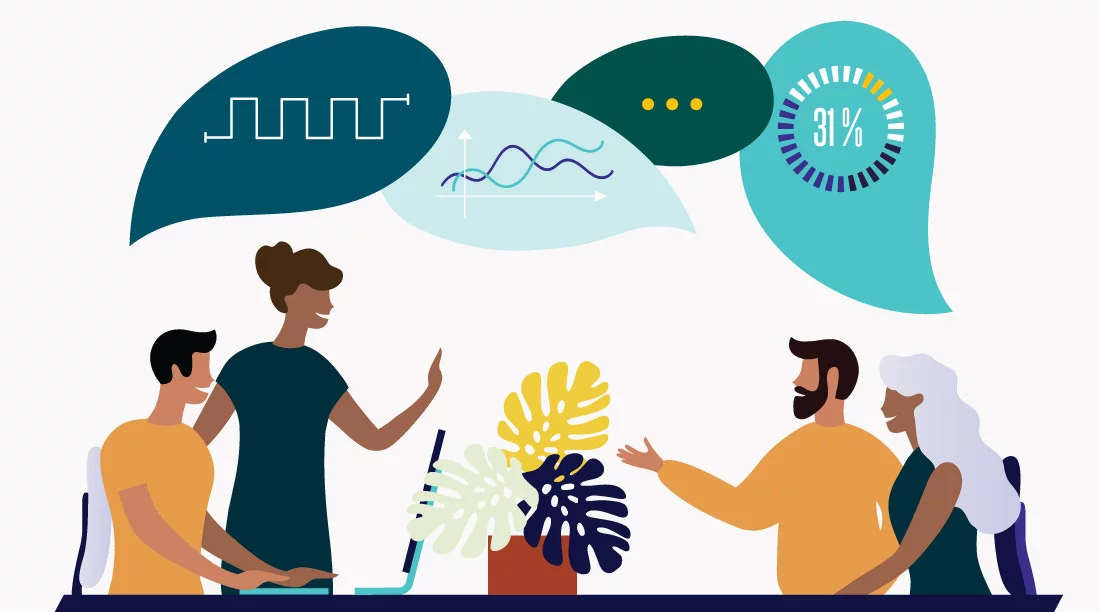
Creating moments of impact: Using Sparklines for strategic conversations
Learn how to take the same presentation structure from a Presentation Sparkline™ and use it to drive strategic conversations.

Improve your practice.
Enhance your soft skills with a range of award-winning courses.
How to Structure your Presentation, with Examples
August 3, 2018 - Dom Barnard
For many people the thought of delivering a presentation is a daunting task and brings about a great deal of nerves . However, if you take some time to understand how effective presentations are structured and then apply this structure to your own presentation, you’ll appear much more confident and relaxed.
Here is our complete guide for structuring your presentation, with examples at the end of the article to demonstrate these points.
Why is structuring a presentation so important?
If you’ve ever sat through a great presentation, you’ll have left feeling either inspired or informed on a given topic. This isn’t because the speaker was the most knowledgeable or motivating person in the world. Instead, it’s because they know how to structure presentations – they have crafted their message in a logical and simple way that has allowed the audience can keep up with them and take away key messages.
Research has supported this, with studies showing that audiences retain structured information 40% more accurately than unstructured information.
In fact, not only is structuring a presentation important for the benefit of the audience’s understanding, it’s also important for you as the speaker. A good structure helps you remain calm, stay on topic, and avoid any awkward silences.
What will affect your presentation structure?
Generally speaking, there is a natural flow that any decent presentation will follow which we will go into shortly. However, you should be aware that all presentation structures will be different in their own unique way and this will be due to a number of factors, including:
- Whether you need to deliver any demonstrations
- How knowledgeable the audience already is on the given subject
- How much interaction you want from the audience
- Any time constraints there are for your talk
- What setting you are in
- Your ability to use any kinds of visual assistance
Before choosing the presentation’s structure answer these questions first:
- What is your presentation’s aim?
- Who are the audience?
- What are the main points your audience should remember afterwards?
When reading the points below, think critically about what things may cause your presentation structure to be slightly different. You can add in certain elements and add more focus to certain moments if that works better for your speech.

What is the typical presentation structure?
This is the usual flow of a presentation, which covers all the vital sections and is a good starting point for yours. It allows your audience to easily follow along and sets out a solid structure you can add your content to.
1. Greet the audience and introduce yourself
Before you start delivering your talk, introduce yourself to the audience and clarify who you are and your relevant expertise. This does not need to be long or incredibly detailed, but will help build an immediate relationship between you and the audience. It gives you the chance to briefly clarify your expertise and why you are worth listening to. This will help establish your ethos so the audience will trust you more and think you’re credible.
Read our tips on How to Start a Presentation Effectively
2. Introduction
In the introduction you need to explain the subject and purpose of your presentation whilst gaining the audience’s interest and confidence. It’s sometimes helpful to think of your introduction as funnel-shaped to help filter down your topic:
- Introduce your general topic
- Explain your topic area
- State the issues/challenges in this area you will be exploring
- State your presentation’s purpose – this is the basis of your presentation so ensure that you provide a statement explaining how the topic will be treated, for example, “I will argue that…” or maybe you will “compare”, “analyse”, “evaluate”, “describe” etc.
- Provide a statement of what you’re hoping the outcome of the presentation will be, for example, “I’m hoping this will be provide you with…”
- Show a preview of the organisation of your presentation
In this section also explain:
- The length of the talk.
- Signal whether you want audience interaction – some presenters prefer the audience to ask questions throughout whereas others allocate a specific section for this.
- If it applies, inform the audience whether to take notes or whether you will be providing handouts.
The way you structure your introduction can depend on the amount of time you have been given to present: a sales pitch may consist of a quick presentation so you may begin with your conclusion and then provide the evidence. Conversely, a speaker presenting their idea for change in the world would be better suited to start with the evidence and then conclude what this means for the audience.
Keep in mind that the main aim of the introduction is to grab the audience’s attention and connect with them.
3. The main body of your talk
The main body of your talk needs to meet the promises you made in the introduction. Depending on the nature of your presentation, clearly segment the different topics you will be discussing, and then work your way through them one at a time – it’s important for everything to be organised logically for the audience to fully understand. There are many different ways to organise your main points, such as, by priority, theme, chronologically etc.
- Main points should be addressed one by one with supporting evidence and examples.
- Before moving on to the next point you should provide a mini-summary.
- Links should be clearly stated between ideas and you must make it clear when you’re moving onto the next point.
- Allow time for people to take relevant notes and stick to the topics you have prepared beforehand rather than straying too far off topic.
When planning your presentation write a list of main points you want to make and ask yourself “What I am telling the audience? What should they understand from this?” refining your answers this way will help you produce clear messages.
4. Conclusion
In presentations the conclusion is frequently underdeveloped and lacks purpose which is a shame as it’s the best place to reinforce your messages. Typically, your presentation has a specific goal – that could be to convert a number of the audience members into customers, lead to a certain number of enquiries to make people knowledgeable on specific key points, or to motivate them towards a shared goal.
Regardless of what that goal is, be sure to summarise your main points and their implications. This clarifies the overall purpose of your talk and reinforces your reason for being there.
Follow these steps:
- Signal that it’s nearly the end of your presentation, for example, “As we wrap up/as we wind down the talk…”
- Restate the topic and purpose of your presentation – “In this speech I wanted to compare…”
- Summarise the main points, including their implications and conclusions
- Indicate what is next/a call to action/a thought-provoking takeaway
- Move on to the last section
5. Thank the audience and invite questions
Conclude your talk by thanking the audience for their time and invite them to ask any questions they may have. As mentioned earlier, personal circumstances will affect the structure of your presentation.
Many presenters prefer to make the Q&A session the key part of their talk and try to speed through the main body of the presentation. This is totally fine, but it is still best to focus on delivering some sort of initial presentation to set the tone and topics for discussion in the Q&A.

Other common presentation structures
The above was a description of a basic presentation, here are some more specific presentation layouts:
Demonstration
Use the demonstration structure when you have something useful to show. This is usually used when you want to show how a product works. Steve Jobs frequently used this technique in his presentations.
- Explain why the product is valuable.
- Describe why the product is necessary.
- Explain what problems it can solve for the audience.
- Demonstrate the product to support what you’ve been saying.
- Make suggestions of other things it can do to make the audience curious.
Problem-solution
This structure is particularly useful in persuading the audience.
- Briefly frame the issue.
- Go into the issue in detail showing why it ‘s such a problem. Use logos and pathos for this – the logical and emotional appeals.
- Provide the solution and explain why this would also help the audience.
- Call to action – something you want the audience to do which is straightforward and pertinent to the solution.
Storytelling
As well as incorporating stories in your presentation , you can organise your whole presentation as a story. There are lots of different type of story structures you can use – a popular choice is the monomyth – the hero’s journey. In a monomyth, a hero goes on a difficult journey or takes on a challenge – they move from the familiar into the unknown. After facing obstacles and ultimately succeeding the hero returns home, transformed and with newfound wisdom.
Storytelling for Business Success webinar , where well-know storyteller Javier Bernad shares strategies for crafting compelling narratives.
Another popular choice for using a story to structure your presentation is in media ras (in the middle of thing). In this type of story you launch right into the action by providing a snippet/teaser of what’s happening and then you start explaining the events that led to that event. This is engaging because you’re starting your story at the most exciting part which will make the audience curious – they’ll want to know how you got there.
- Great storytelling: Examples from Alibaba Founder, Jack Ma
Remaining method
The remaining method structure is good for situations where you’re presenting your perspective on a controversial topic which has split people’s opinions.
- Go into the issue in detail showing why it’s such a problem – use logos and pathos.
- Rebut your opponents’ solutions – explain why their solutions could be useful because the audience will see this as fair and will therefore think you’re trustworthy, and then explain why you think these solutions are not valid.
- After you’ve presented all the alternatives provide your solution, the remaining solution. This is very persuasive because it looks like the winning idea, especially with the audience believing that you’re fair and trustworthy.
Transitions
When delivering presentations it’s important for your words and ideas to flow so your audience can understand how everything links together and why it’s all relevant. This can be done using speech transitions which are words and phrases that allow you to smoothly move from one point to another so that your speech flows and your presentation is unified.
Transitions can be one word, a phrase or a full sentence – there are many different forms, here are some examples:
Moving from the introduction to the first point
Signify to the audience that you will now begin discussing the first main point:
- Now that you’re aware of the overview, let’s begin with…
- First, let’s begin with…
- I will first cover…
- My first point covers…
- To get started, let’s look at…
Shifting between similar points
Move from one point to a similar one:
- In the same way…
- Likewise…
- Equally…
- This is similar to…
- Similarly…
Internal summaries
Internal summarising consists of summarising before moving on to the next point. You must inform the audience:
- What part of the presentation you covered – “In the first part of this speech we’ve covered…”
- What the key points were – “Precisely how…”
- How this links in with the overall presentation – “So that’s the context…”
- What you’re moving on to – “Now I’d like to move on to the second part of presentation which looks at…”
Physical movement
You can move your body and your standing location when you transition to another point. The audience find it easier to follow your presentation and movement will increase their interest.
A common technique for incorporating movement into your presentation is to:
- Start your introduction by standing in the centre of the stage.
- For your first point you stand on the left side of the stage.
- You discuss your second point from the centre again.
- You stand on the right side of the stage for your third point.
- The conclusion occurs in the centre.
Key slides for your presentation
Slides are a useful tool for most presentations: they can greatly assist in the delivery of your message and help the audience follow along with what you are saying. Key slides include:
- An intro slide outlining your ideas
- A summary slide with core points to remember
- High quality image slides to supplement what you are saying
There are some presenters who choose not to use slides at all, though this is more of a rarity. Slides can be a powerful tool if used properly, but the problem is that many fail to do just that. Here are some golden rules to follow when using slides in a presentation:
- Don’t over fill them – your slides are there to assist your speech, rather than be the focal point. They should have as little information as possible, to avoid distracting people from your talk.
- A picture says a thousand words – instead of filling a slide with text, instead, focus on one or two images or diagrams to help support and explain the point you are discussing at that time.
- Make them readable – depending on the size of your audience, some may not be able to see small text or images, so make everything large enough to fill the space.
- Don’t rush through slides – give the audience enough time to digest each slide.
Guy Kawasaki, an entrepreneur and author, suggests that slideshows should follow a 10-20-30 rule :
- There should be a maximum of 10 slides – people rarely remember more than one concept afterwards so there’s no point overwhelming them with unnecessary information.
- The presentation should last no longer than 20 minutes as this will leave time for questions and discussion.
- The font size should be a minimum of 30pt because the audience reads faster than you talk so less information on the slides means that there is less chance of the audience being distracted.
Here are some additional resources for slide design:
- 7 design tips for effective, beautiful PowerPoint presentations
- 11 design tips for beautiful presentations
- 10 tips on how to make slides that communicate your idea
Group Presentations
Group presentations are structured in the same way as presentations with one speaker but usually require more rehearsal and practices. Clean transitioning between speakers is very important in producing a presentation that flows well. One way of doing this consists of:
- Briefly recap on what you covered in your section: “So that was a brief introduction on what health anxiety is and how it can affect somebody”
- Introduce the next speaker in the team and explain what they will discuss: “Now Elnaz will talk about the prevalence of health anxiety.”
- Then end by looking at the next speaker, gesturing towards them and saying their name: “Elnaz”.
- The next speaker should acknowledge this with a quick: “Thank you Joe.”
From this example you can see how the different sections of the presentations link which makes it easier for the audience to follow and remain engaged.
Example of great presentation structure and delivery
Having examples of great presentations will help inspire your own structures, here are a few such examples, each unique and inspiring in their own way.
How Google Works – by Eric Schmidt
This presentation by ex-Google CEO Eric Schmidt demonstrates some of the most important lessons he and his team have learnt with regards to working with some of the most talented individuals they hired. The simplistic yet cohesive style of all of the slides is something to be appreciated. They are relatively straightforward, yet add power and clarity to the narrative of the presentation.
Start with why – by Simon Sinek
Since being released in 2009, this presentation has been viewed almost four million times all around the world. The message itself is very powerful, however, it’s not an idea that hasn’t been heard before. What makes this presentation so powerful is the simple message he is getting across, and the straightforward and understandable manner in which he delivers it. Also note that he doesn’t use any slides, just a whiteboard where he creates a simple diagram of his opinion.
The Wisdom of a Third Grade Dropout – by Rick Rigsby
Here’s an example of a presentation given by a relatively unknown individual looking to inspire the next generation of graduates. Rick’s presentation is unique in many ways compared to the two above. Notably, he uses no visual prompts and includes a great deal of humour.
However, what is similar is the structure he uses. He first introduces his message that the wisest man he knew was a third-grade dropout. He then proceeds to deliver his main body of argument, and in the end, concludes with his message. This powerful speech keeps the viewer engaged throughout, through a mixture of heart-warming sentiment, powerful life advice and engaging humour.
As you can see from the examples above, and as it has been expressed throughout, a great presentation structure means analysing the core message of your presentation. Decide on a key message you want to impart the audience with, and then craft an engaging way of delivering it.
By preparing a solid structure, and practising your talk beforehand, you can walk into the presentation with confidence and deliver a meaningful message to an interested audience.
It’s important for a presentation to be well-structured so it can have the most impact on your audience. An unstructured presentation can be difficult to follow and even frustrating to listen to. The heart of your speech are your main points supported by evidence and your transitions should assist the movement between points and clarify how everything is linked.
Research suggests that the audience remember the first and last things you say so your introduction and conclusion are vital for reinforcing your points. Essentially, ensure you spend the time structuring your presentation and addressing all of the sections.
Home Blog Presentation Ideas How to Write a Presentation Script
How to Write a Presentation Script
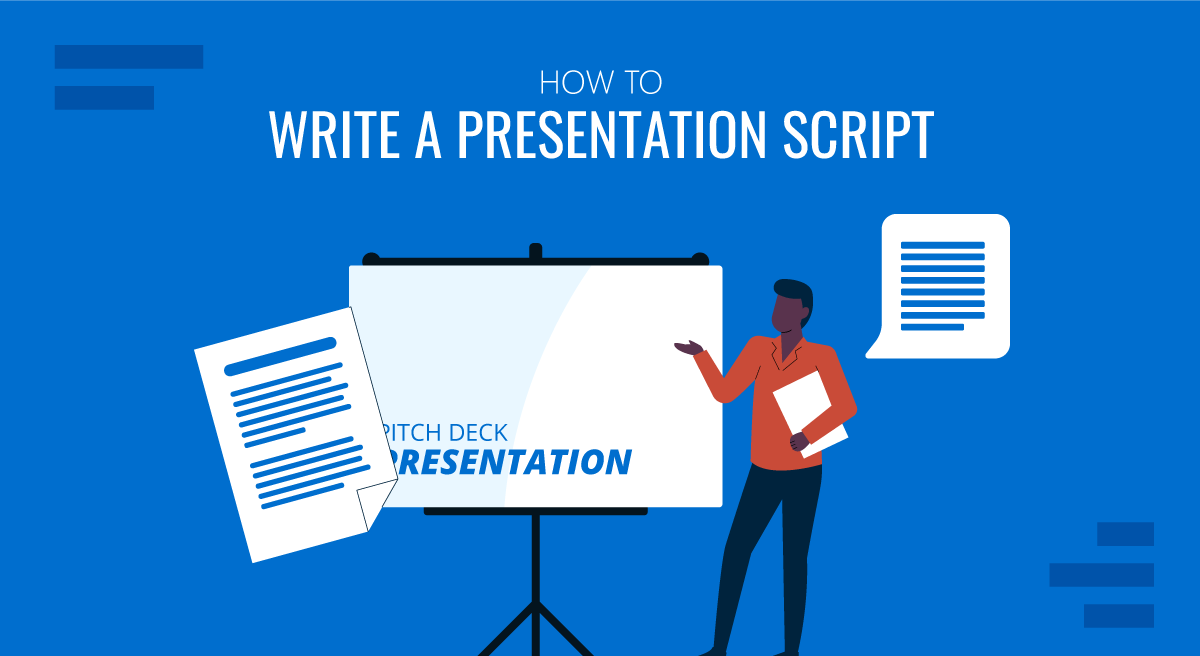
Delivering a successful presentation is a combination of a confident speech and professional-quality graphics. The first element is sometimes neglected, as presenters rely mostly on the slides and add an improvisation element to the speech. Truth is, if you aim to hone your presentation skills, you need to work on the speech. And for that to be a powerful asset, the answer is to learn how to write an effective presentation script.
This article will detail how to create a presentation script, which elements it should contain, how to relate the script to the presenter’s notes, and much more.
Table of Contents
What is a Presentation Script
How do you start a presentation script, how do you write a presentation script, how to connect a presentation script with presenter notes, recommended ppt templates to write a presentation script, final words.
A presentation script is a written guide that outlines what a speaker will say during a presentation. It includes the key points, transitions, and supporting details needed to communicate the message clearly and effectively. The script helps the speaker stay on track, ensuring the presentation is organized, concise, and delivered within the allotted time. It often integrates cues for visual aids and other presentation elements.
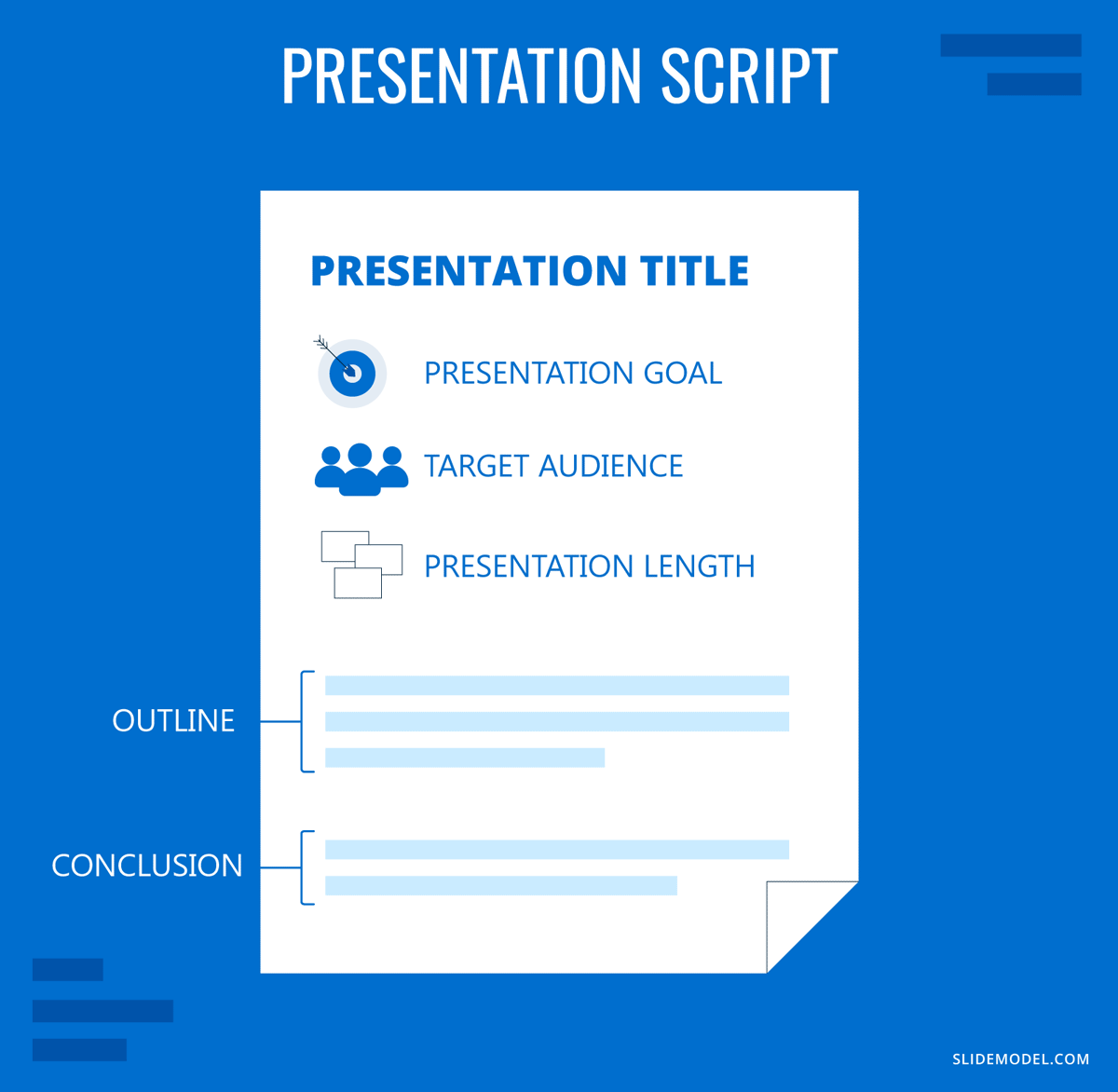
Defining the Purpose and Objective
Every effective presentation script starts with clearly understanding its purpose and objectives. Defining these elements early ensures your script remains focused, relevant, and aligned with your desired outcomes.
Your core message is the central idea you want your audience to take away from your presentation. It should be clear, concise, and memorable. To define your core message, ask yourself:
- What is the one thing I want my audience to remember?
- Why is this message important?
- How does this message benefit my audience?
Once you have a clear core message, everything in your script for a speech should support and reinforce it. This focus will help you avoid straying into irrelevant topics and ensure your presentation remains cohesive.
Next, the presenter should establish clear objectives for the talk. Objectives must be specific, measurable outcomes you want to achieve with your presentation. They give you a clear direction and help you measure the success of your presentation. Objectives can be:
- Informational: Educate the audience on a particular topic.
- Persuasive: Convince the audience to adopt a viewpoint or take a specific action.
- Motivational: Inspire the audience to feel or act in a certain way.
- Instructional: Teach the audience how to do something.
For example, suppose your core message is about the importance of cybersecurity. In that case, your objectives might include informing the audience about common threats, persuading them to adopt better security practices, and instructing them on implementing them.
Check our article on SMART goal setting for a practical approach to defining measurable goals.
Aligning the Script with Desired Outcomes
Once you’ve defined your core message and objectives, your script should be structured to achieve these outcomes. This involves:
- Prioritizing content: Focus on the information and arguments directly contributing to your objectives.
- Building logical flow: Ensure that each section of your presentation leads naturally to the next, creating a narrative that reinforces your core message.
- Incorporating calls to action: If your objective is to persuade or motivate, include clear, actionable steps your audience can take after the presentation.
By defining the purpose and objectives of your presentation script, you set the stage for a focused, effective, and impactful delivery.
In this section, we’ll explore section by section how to write a presentation script. The following image is a guideline of presentation script examples on how to create icebreakers for each section
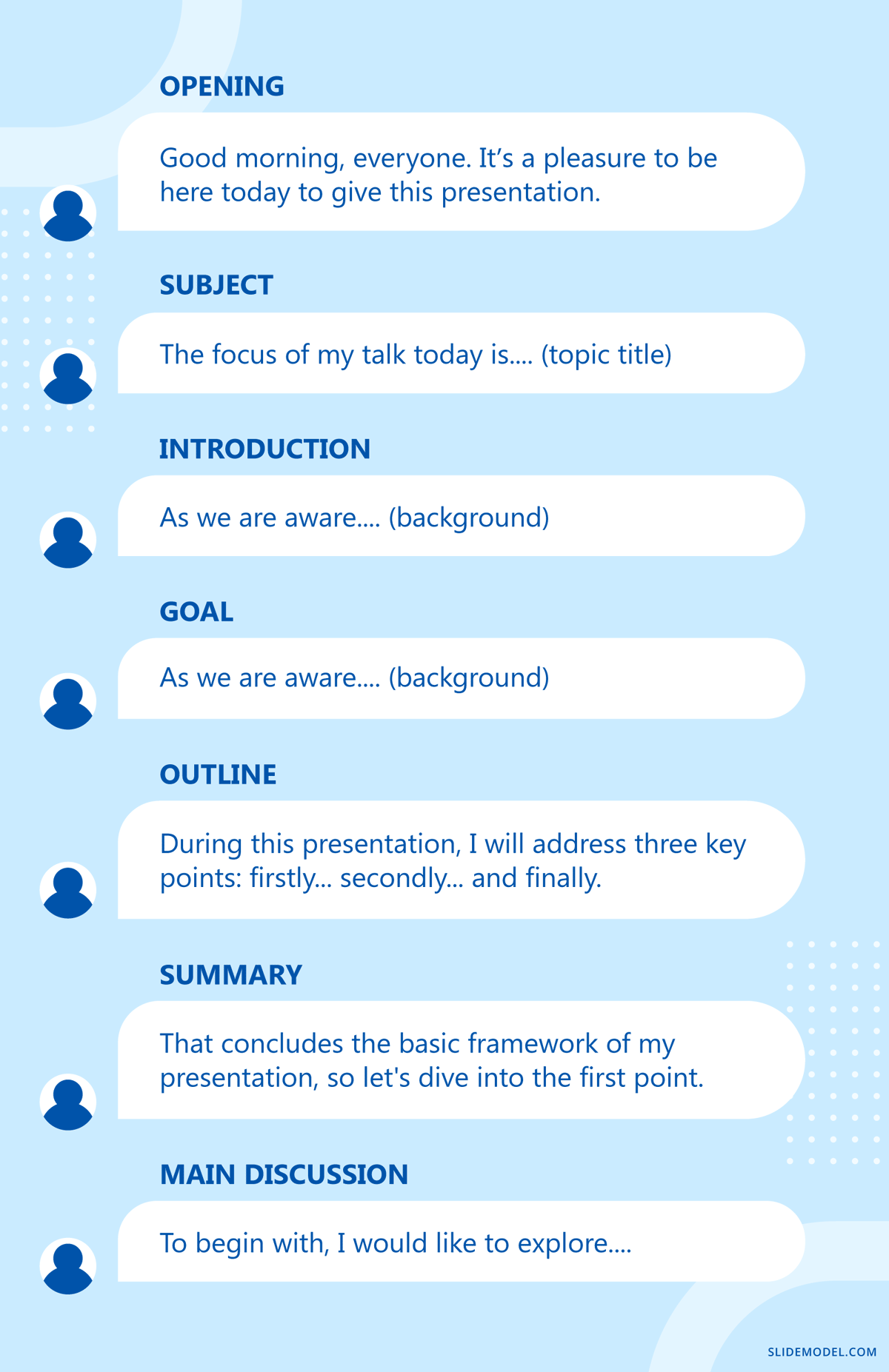
Crafting a Compelling Introduction
The introduction is your opportunity to capture the audience’s attention and set the tone for the rest of the presentation. It should be engaging and clearly overview what the audience can expect.
If you are wondering how to start a presentation , key elements of a strong introduction include:
- Opening hook: Start with a statement, question, or anecdote that grabs the audience’s attention. This could be a surprising statistic, a relevant quote, or a provocative question.
- Purpose statement: Clearly state the purpose of your presentation and what you hope to achieve. This helps the audience understand why they should care about your words.
- Agenda overview: Briefly outline the main points you will cover. This will give the audience a roadmap of what to expect and help them follow along.
Let’s say your presentation is about digital marketing trends. In that case, you might start with a surprising statistic about the growth of AI technology usage, followed by a statement about the importance of staying ahead of digital trends, and then outline the specific trends you will discuss in an upcoming slide.

Organizing the Body of the Script
The body of your script is where you present your main content. It should be organized logically, with each section building on the previous one to reinforce your core message.
Break down your content into clear, manageable sections. Each section should cover a specific point or idea. Smooth transitions between sections help maintain the flow of your presentation and keep the audience engaged . Phrases like “building on that idea,” “another important factor,” or “let’s now shift our focus to” can help guide the audience through your presentation.
Use data, examples, case studies , and visuals to support your points. This will strengthen your argument and make your presentation more engaging.
For instance, in a presentation about social media’s impact on consumer behavior, you might organize the body into sections on social media usage trends, the psychology of social media influence, and case studies of successful social media campaigns.

Engaging the Audience with Stories and Examples
One of the most effective ways to make your presentation engaging and relatable is by incorporating stories and examples. These elements help illustrate your points, making them more memorable and impactful.
Consider the following strategies:
- Use personal anecdotes: Sharing personal experiences related to your topic can help establish a connection with the audience and make your presentation more relatable.
- Include case studies: Real-world examples or case studies can help illustrate how the concepts you’re discussing apply in practice. This is especially effective when presenting to a business or professional audience.
- Tell a story: Structure part of your presentation as a narrative, with a clear beginning, middle, and end. Stories are inherently engaging and can make complex information more digestible.
You can learn more about this technique with our article on storytelling for presentations .
Developing a Memorable Conclusion
The conclusion is your final opportunity to reinforce your core message and leave a lasting impression on your audience.
A strong conclusion should:
- Summarize key points: Recap the main points of your presentation to reinforce them in the audience’s mind.
- Reiterate the core message: Restate your core message in a way that resonates with the audience and underscores its importance.
- End with impact: Conclude with a powerful statement, call to action, or thought-provoking question that leaves the audience with something to think about or do.
If your presentation was about the importance of innovation in business, you might conclude by summarizing its key benefits, restating that innovation is crucial for long-term success, and ending with a call to action for the audience to start thinking about how they can innovate in their roles.
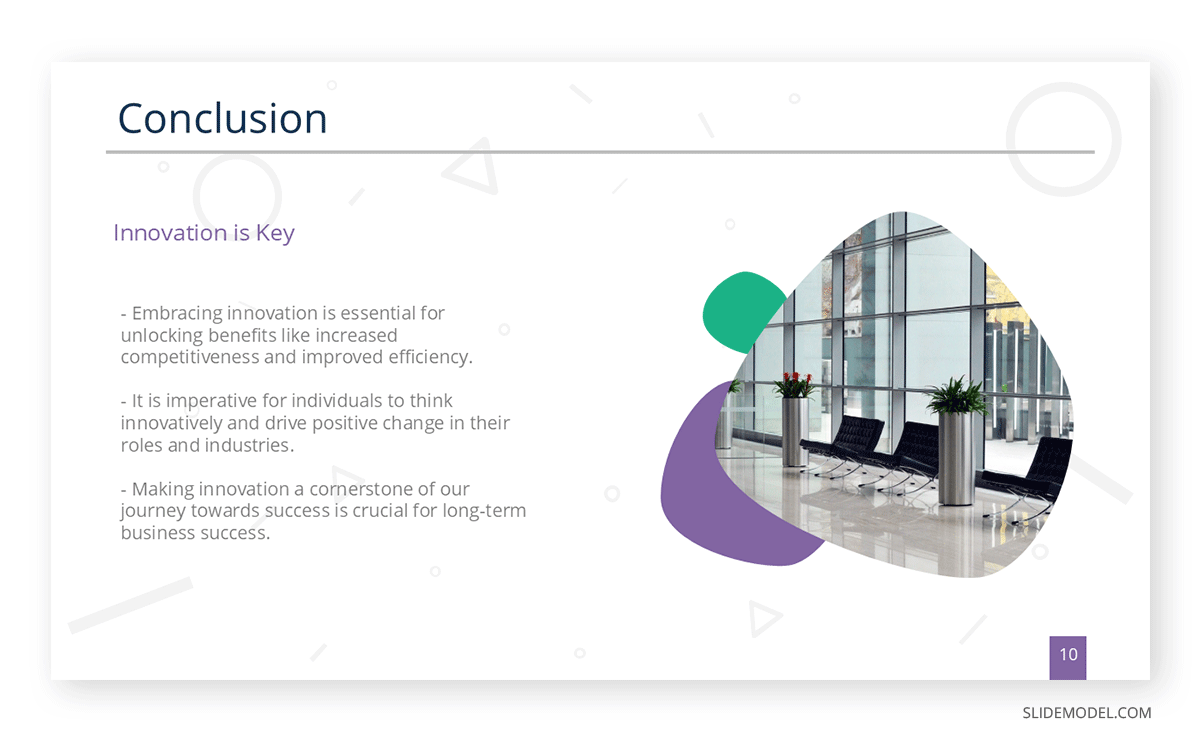
Get more insights on how to end a presentation with our article.
Although the presentation script is a fantastic resource for preparing your presentation and also for rehearsal, presenters cannot bring lengthy text pages with them and start reading if they feel lost. This is where presenter notes come in handy, and in this section, we’ll learn how to turn the presentation script into presenter notes.
The first step in this process is to go through the detailed script a couple of times, highlighting the main ideas, data, and messages to convey to the audience. You can follow the process as with meeting notes and apply the strategies explained in that article.
Now, we need to condense the information into simpler sentences, direct phrases, or keywords that trigger memory recall. These phrases will be added to the slides in the format of speaker notes linked to each slide. It’s crucial to mark the transitions from one topic to another in the presentation so we can articulate the speech or remember to emphasize a point.
Remember, if we suddenly need to include last-minute details, we can use visual cues or a printed version of our slides with extra handwritten notes.
Before we conclude this article, we want to recommend some PowerPoint templates that can help the presentation script creation process, especially for team collaboration, where the presentation goes through multiple iterations. Remember these designs also serve as Google Slides templates .
1. 6 Step Creative Timeline Diagram for Presentation Scripts
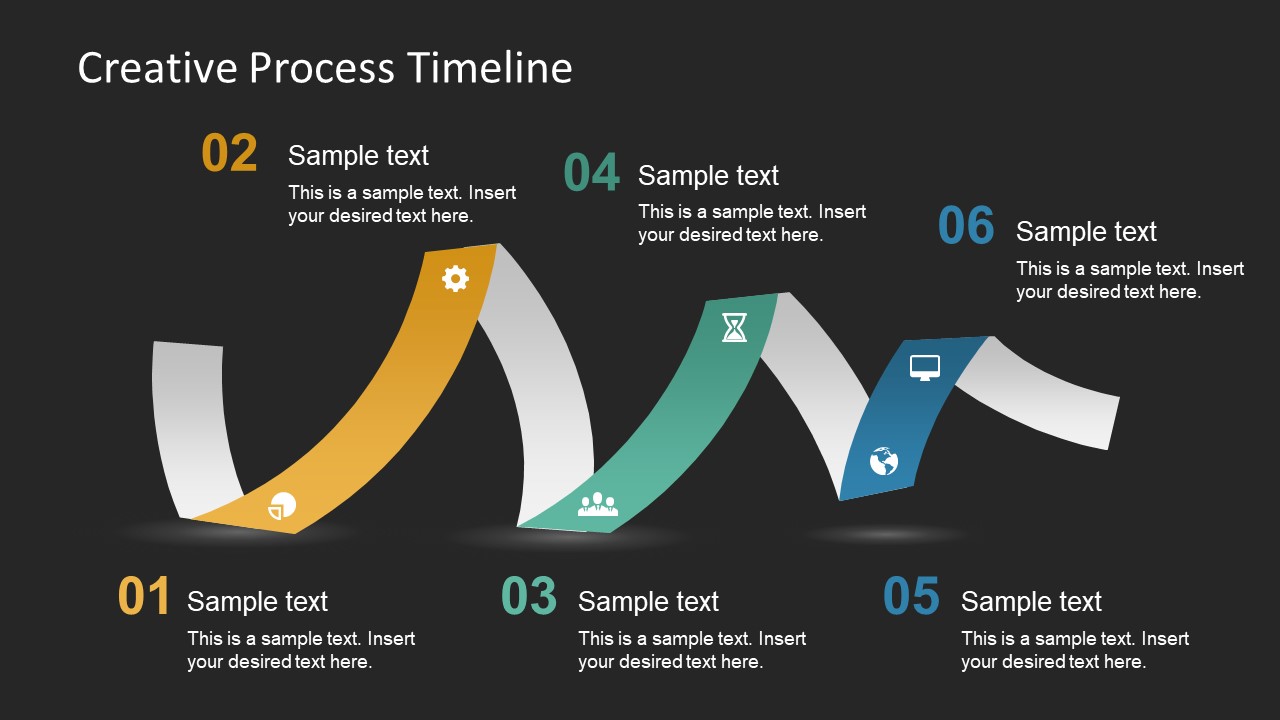
Say you need to create a sample script for a presentation or work with your team for a department presentation: this is where this best PPT template is beneficial. We can summarize processes or points that we intend the presentation to cover into six actionable steps that can be discussed within the team. The icons included help us to connect concepts with the steps we’re describing.
Use This Template
2. Product Timeline Script of Speech PPT Template

In sales and product presentations, we need to contextualize the dates on which we expect things to happen. By using this timeline PPT template as a visual aid, presenters can carry a printed version or digital version on another device to remind themselves of the milestones that a product or service is due in the near future.
3. The Presentation Experience Script PowerPoint Template
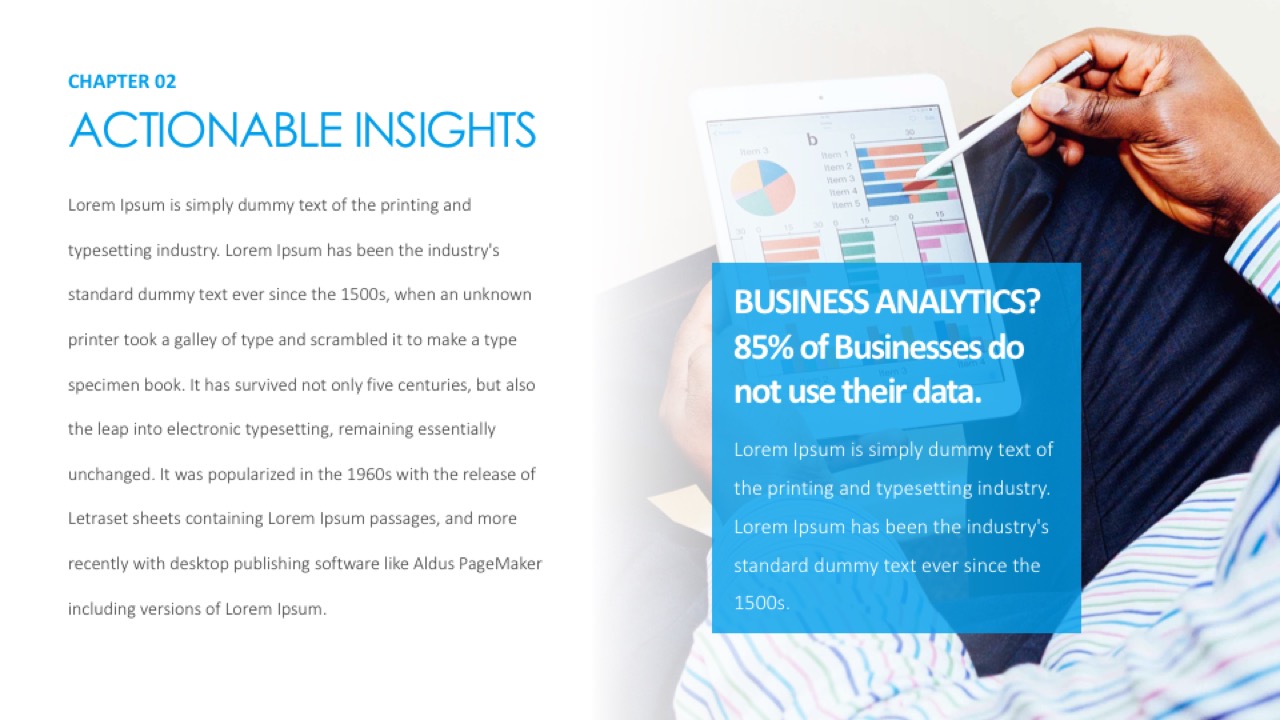
Although this template is tailored to sales presentations, this slide deck is ideal for writing a recap of the presentation script. You can add facts, questions, numeric data, and more.
4. Steps & Stairs Diagram Presentation Script Google Slides Template

This diagram template for PowerPoint and Google Slides is a highly visual 3D aid intended for defining the steps to write the script or to present processes. Use this staircase design template to summarize key information about your presentation speech.
Creating a detailed, professional presentation script doesn’t have to be a daunting process. As long as we understand the basis of how to structure what we intend to say, questions and answers about which content to include shall arise.
Follow the steps shown in this article and you will master the process to create your own presentation scripts in no time.
Like this article? Please share
Presentation Skills, Speech Filed under Presentation Ideas
Related Articles

Filed under Presentation Ideas • August 29th, 2024
How to Make a Presentation Longer: 7 Strategies to Master
Extend your talk in style. Join us to discover how to make a presentation longer while providing a high-end experience to your audience.
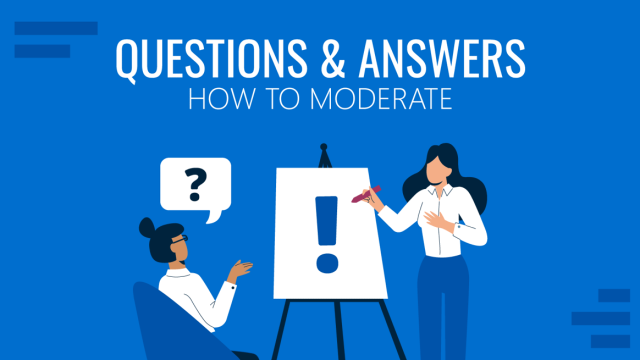
Filed under Business • August 7th, 2024
How to Moderate Question-and-Answer Sessions in Your Presentation
Reduce your anxiety over Q&A sessions by learning how to moderate this part of your presentations. A step-by-step guide.
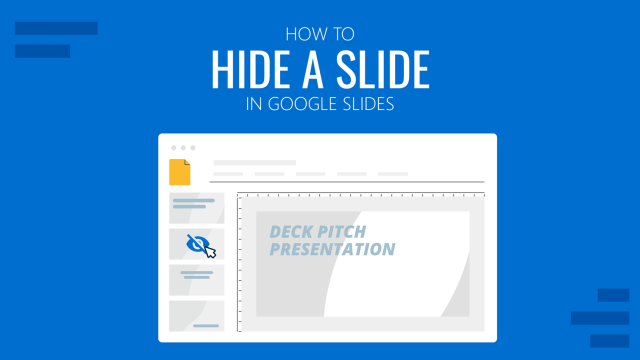
Filed under Google Slides Tutorials • July 25th, 2024
How to Hide a Slide in Google Slides
Hiding a slide in Google Slides is a task that takes less than a minute. Learn how to quickly implement this tool for your presentations in this article.
Leave a Reply
- PRO Courses Guides New Tech Help Pro Expert Videos About wikiHow Pro Upgrade Sign In
- EDIT Edit this Article
- EXPLORE Tech Help Pro About Us Random Article Quizzes Request a New Article Community Dashboard This Or That Game Happiness Hub Popular Categories Arts and Entertainment Artwork Books Movies Computers and Electronics Computers Phone Skills Technology Hacks Health Men's Health Mental Health Women's Health Relationships Dating Love Relationship Issues Hobbies and Crafts Crafts Drawing Games Education & Communication Communication Skills Personal Development Studying Personal Care and Style Fashion Hair Care Personal Hygiene Youth Personal Care School Stuff Dating All Categories Arts and Entertainment Finance and Business Home and Garden Relationship Quizzes Cars & Other Vehicles Food and Entertaining Personal Care and Style Sports and Fitness Computers and Electronics Health Pets and Animals Travel Education & Communication Hobbies and Crafts Philosophy and Religion Work World Family Life Holidays and Traditions Relationships Youth
- Browse Articles
- Learn Something New
- Quizzes Hot
- Happiness Hub
- This Or That Game
- Train Your Brain
- Explore More
- Support wikiHow
- About wikiHow
- Log in / Sign up
- Education and Communications
- Communication Skills
- Public Speaking
How to Prepare Notes for Public Speaking
Last Updated: May 21, 2023 Fact Checked
This article was co-authored by Deb DiSandro . Deb DiSandro is the Owner of Speak Up On Purpose, an organization dedicated to improving and teaching public speaking. Deb has over 30 years of experience as a national speaker and has presented at the Erma Bombeck Writer’s Conference and the National Society of Newspaper Columnists. She was awarded the National Speakers Association Member of the Year 2007 and has been published in Writer's Digest, Daily Herald, Women's Day, and Better Homes & Gardens. There are 10 references cited in this article, which can be found at the bottom of the page. This article has been fact-checked, ensuring the accuracy of any cited facts and confirming the authority of its sources. This article has been viewed 246,176 times.
You have to give a speech, and you wonder how you can give it without staring at a piece of paper. Rather than memorize the words, you can use notes. Notes are easy to make. First, write and refine your speech. Pick out keywords that represent the main ideas of your speech and write them on notecards. Finish filling out the notecards with important talking points. Good notes make you sound natural as a speaker while having a safety net in case you get lost.
Creating and Breaking Down Your Speech

- This is a draft. Pay attention to word choice and sentence structure. Make it as good as possible, but remember that you'll be able to fix any mistakes before you make your notes.
- Get all of your ideas on paper. It doesn't matter if they're crazy, inspiring, or weird. You have a chance to perfect what doesn't work later on. [2] X Research source

- It's a good idea to time yourself while you do this. That way, you'll know when you need to cut down your speech's length.
- Learn transitional phrases to help your speech flow naturally. [4] X Research source

- Highlight things that worked from your first draft and areas that you want to keep that need to be reworded.

- Record your own speech and listen to the phrases and pacing. Listen for any awkward phrases and try to smooth them out in the next draft.
- If you know someone who's given a public speech before, ask them to listen. They will have more experience and will be less biased.

Making Your Notes

- For example, you are speaking about the life of a politician. You can use the word “Military” to show yourself when it's time to talk about their military experience.
- Images can also help solidify the order of your speech. Visualize uniformed soldiers marching in unison and you won't forget you need to talk about military training.
- Write out the first words of your transition sentences to help keep yourself on track.

- For example, if you need to introduce your second idea at the three minute mark, write three minutes on the card containing that idea.

- Write the words in a pen that's legible to you. Black or blue ink works best.
- If you have bad handwriting, you can type out your notes. Cut and glue them onto your notes or print them directly by using the “Size” option in the “Print Layout” tab.

- For example, write out “award” or “Purple Heart” to remind yourself to mention the awards someone earned in service.

- For instance, write down “75% pass” if you need to inform your audience how many people pass a class.

- Customize the color code to whatever works best for you.
- This works best if you color code while you practice your speech, but it could be distracting or confusing by the time you give the speech.

- You can also bind the cards together. Use a drill or hole punch on the upper left corner of the notes. Loop a string through them. They'll be easy to flip and can't be mixed up.
- However, make sure the flipping of the notecards is not distracting to the audience.
Rehearsing Your Speech

- Memorizing a speech word-for-word is unhelpful because the audience can tell that you're reciting a script. Only use memorization and scripted words if you're painting a picture with your words or you need to tell a joke with comedic timing.

- Because you are using a minimal outline, your speech will sound a little different every time. However, it'll also sound more natural.

- You can time yourself again while giving the speech so you know exactly how long it is rather than making a guess. It can show you when you're going off-script too much. Keep in mind when you give the speech, you're bound to talk faster and the speech will be shorter.
Community Q&A
- Research name pronunciations before writing your speech. Thanks Helpful 4 Not Helpful 1
- Try to have 3 main points in the middle of your speech so the audience remembers it well. You can back these points up with further information or quotes. Thanks Helpful 4 Not Helpful 1
- Look at your card quickly and smoothly. Keep your thumb next to the line on your note card so you don't lose your place. Thanks Helpful 3 Not Helpful 1

- When using visual aids, make them sparse and with few words. Visual aids are supposed to be for the audience. Thanks Helpful 0 Not Helpful 1
Things You'll Need
- Blue or black pen
- Colored highlighters
- Index cards
You Might Also Like

- ↑ https://pac.org/content/speechwriting-101-writing-effective-speech
- ↑ https://wrd.as.uky.edu/sites/default/files/1-Shitty%20First%20Drafts.pdf
- ↑ http://writingcenter.unc.edu/tips-and-tools/speeches/
- ↑ https://open.lib.umn.edu/publicspeaking/chapter/10-2-keeping-your-speech-moving/
- ↑ https://www.unr.edu/writing-speaking-center/student-resources/writing-speaking-resources/editing-and-proofreading-techniques
- ↑ http://www.washington.edu/doit/presentation-tips-0
- ↑ https://examples.yourdictionary.com/keyword-outline-examples.html
- ↑ http://academics.umw.edu/speaking/resources/handouts/preparing-speaking-notes/
- ↑ https://www.ted.com/participate/organize-a-local-tedx-event/tedx-organizer-guide/speakers-program/prepare-your-speaker/rehearsals
- ↑ https://www.student.unsw.edu.au/speaking-audience
About This Article

Public speaking can be scary, but using notes can increase your confidence and make it a little easier. To prepare notes for public speaking, begin by writing your speech. Once you’ve written the first draft, read the speech out loud and make any necessary changes so it sounds smooth. When you’re happy with your speech, translate it into notes by highlighting keywords to mark where each new idea begins. Then, write one keyword per notecard. Make sure your writing is clear so you can read it easily as you speak! If you need to remember specific details or statistics, include these on your notecards. For example, you could write ”75%” in your notes if you need to tell the audience how many people pass a class. When you’ve finished making your notes, number each one to avoid getting them mixed up. For more information from our Public Speaking co-author, like how to practice your speech, read on! Did this summary help you? Yes No
- Send fan mail to authors
Reader Success Stories
Conrad Pickl
Oct 17, 2017
Did this article help you?

Zachary Peel
Sep 19, 2021
Megan White
Jul 27, 2016
Tambra Shafer
Oct 15, 2017
Anahi Pizano
Feb 10, 2020

Featured Articles

Trending Articles

Watch Articles

- Terms of Use
- Privacy Policy
- Do Not Sell or Share My Info
- Not Selling Info
wikiHow Tech Help Pro:
Level up your tech skills and stay ahead of the curve
How-To Geek
How to use speaker notes in powerpoint.

Your changes have been saved
Email is sent
Email has already been sent
Please verify your email address.
You’ve reached your account maximum for followed topics.
Quick Links
Add speaker notes in powerpoint, use speaker notes during a powerpoint presentation.
Adding speaker notes to a PowerPoint presentation provides reference material for the speaker when they're presenting a slideshow, allowing them to stay on track without forgetting key message points. Here’s how to add and use speaker notes.
To add speaker notes in PowerPoint, you’ll first need to be in the Normal view. If you’re not already there, you can switch to Normal view by going to the “View” tab and then selecting “Normal” in the “Presentation Views” group.
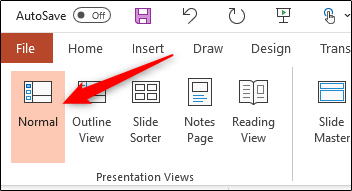
Next, in the pane on left, select the slide where you'd like to add speaker notes.
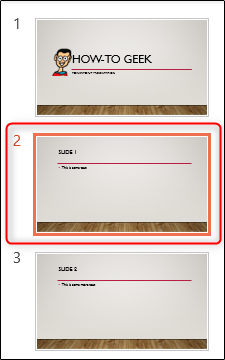
Next, click the “Notes” button at the bottom of the window.

A small box reading “Tap to Add Notes” will appear beneath the slide. For Mac users, this will say “Click to Add Notes.”
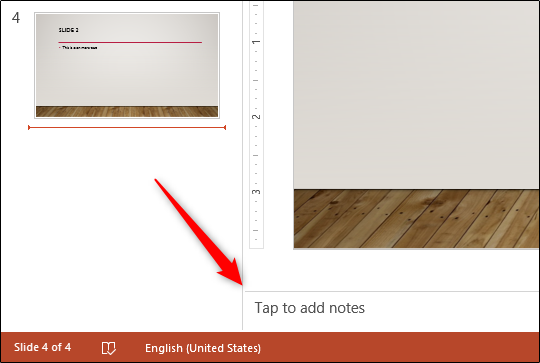
Now, simply type the speaker notes for that slide. Repeat this process for each slide you'd like to add notes to.
There are two ways to use speaker notes during a presentation: by presenting on a secondary monitor or by printing out the speaker notes .
Using a Secondary Monitor
It’s safe to assume that most presentations will be presented on a secondary monitor. If this is the case for you, there’s not a whole lot you really need to do.
Related: How to Add an Extra Monitor to Your Laptop
The first thing you need to do is change the view to Slide Show. You can do this by selecting the Slide Show icon at the bottom-right corner of the window.

In this view, the audience will see only the slides as you’re going through the presentation. However, on your primary monitor, you’ll see the current slide, a preview of the upcoming slide, and your speaker notes for the current slide.
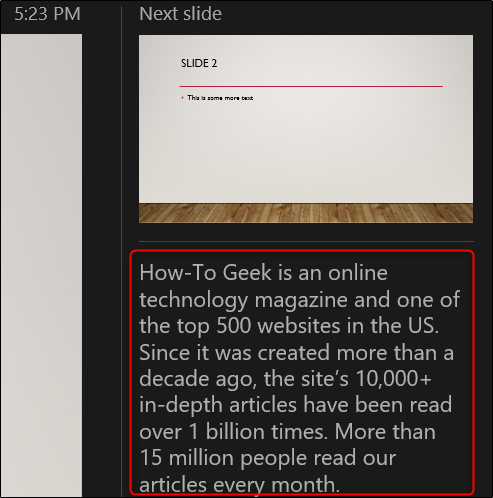
This is a convenient way to have a virtual copy of the speaker notes while you’re giving a presentation, but it never hurts to have a hard copy.
Printing the Speaker Notes
To print the speaker notes of your presentation, first select the “File” tab in the Ribbon.
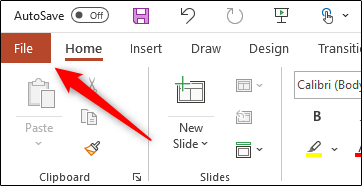
Related: How to Print Multiple PowerPoint Slides to Each Piece of Paper
In the pane on left, select the “Print" button.
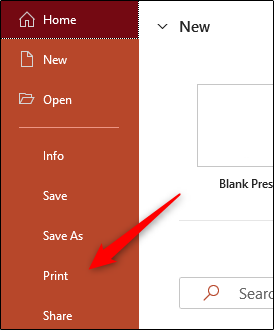
In the “Settings” group, select the option that says “Full Page Slides.”
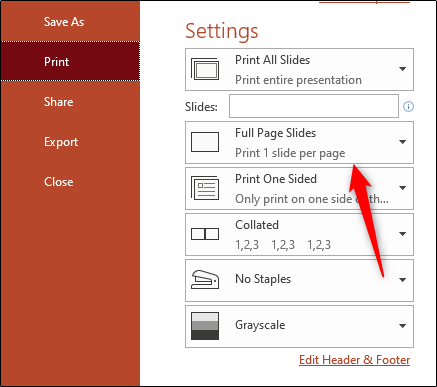
A drop-down menu will appear. Here, select “Notes Pages” in the “Print Layout” group.
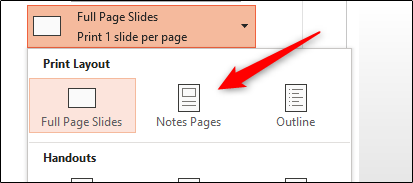
Finally, click “Print.”

You’ll now have a physical copy of your speaker notes.
- Microsoft Office
- Office 2016
- SUGGESTED TOPICS
- The Magazine
- Newsletters
- Managing Yourself
- Managing Teams
- Work-life Balance
- The Big Idea
- Data & Visuals
- Case Selections
- HBR Learning
- Topic Feeds
- Account Settings
- Email Preferences
What It Takes to Give a Great Presentation
- Carmine Gallo

Five tips to set yourself apart.
Never underestimate the power of great communication. It can help you land the job of your dreams, attract investors to back your idea, or elevate your stature within your organization. But while there are plenty of good speakers in the world, you can set yourself apart out by being the person who can deliver something great over and over. Here are a few tips for business professionals who want to move from being good speakers to great ones: be concise (the fewer words, the better); never use bullet points (photos and images paired together are more memorable); don’t underestimate the power of your voice (raise and lower it for emphasis); give your audience something extra (unexpected moments will grab their attention); rehearse (the best speakers are the best because they practice — a lot).
I was sitting across the table from a Silicon Valley CEO who had pioneered a technology that touches many of our lives — the flash memory that stores data on smartphones, digital cameras, and computers. He was a frequent guest on CNBC and had been delivering business presentations for at least 20 years before we met. And yet, the CEO wanted to sharpen his public speaking skills.
- Carmine Gallo is a Harvard University instructor, keynote speaker, and author of 10 books translated into 40 languages. Gallo is the author of The Bezos Blueprint: Communication Secrets of the World’s Greatest Salesman (St. Martin’s Press).
Partner Center

How To Write A Presentation: An Ultimate Guide

Table of Contents
Preparing a presentation can be a daunting experience. Standing in front of an audience to give a speech can be an even more overwhelming prospect. However, you are unlikely to get through university without having to create a presentation. Depending on your subject, instructors may require you to provide feedback from a group task or deliver the findings of a scientific experiment. Whatever the topic, you’ll be presenting to your tutor and fellow students. While preparing a presentation and making your case in front of them is not easy, especially if you’re not used to doing it, it is a good practice since many employers use presentations as part of the recruitment process.
How to Write a PowerPoint Presentation Successfully
Creating an excellent PowerPoint presentation is a skill that any professional must have, especially in the corporate and business world. The problem? It is very easy to get it wrong. From poor color choices to confusing slides, a bad PowerPoint slideshow can distract the audience from the awesome content. A PowerPoint presentation is like a poster presentation; only that the information is on computer slides rather than actual posters. It often accompanies and enhances oral presentations instead of serving as speaking notes. Well-designed slides used sparingly and with good timing can be brilliant. Heck, they can even make an otherwise good presentation awesome. Here are some tips to help you illustrate why your creative talents are the perfect ingredients for a killer presentation.
Use the 10-20-30 Rule
A PowerPoint slide should only have the main points. Guy Kawaski suggested the 10-20-30 rule to make presentations engaging and captivating. He says that a good presentation should not contain more than ten slides, shouldn’t last for more than 20 minutes, and the content should not be more than 30 points. But how do you make your texts lean on the slides? Draw relevant information from your narrative and feature only core ideas and points on slides. You can use the “6×6 technique” to avoid getting too wordy. This guideline suggests using no more than six bullet points or lines per slide with no more than six words per line.
Write an abstract for a Presentation
The purpose of an abstract is to highlight the most critical information in a piece of writing. However, a presentation abstract is different. Try to think of it as an invitation to a party. You want to create as much excitement and curiosity for your presentation as possible. Writing an abstract for a presentation requires the presented information to be more succinct. Unlike a typical abstract or executive summary, the presentation abstract should have less than 250 words and have a simplified and condensed breakdown. The abstract should come after your short bio.
Write A Presentation Outline
When preparing a presentation, there are various ways you can use it to share relevant ideas. One tool that helps presenters is a presentation outline – a synopsis of a talk or pitch. Presentation outlines help you organize your agenda and create a logical flow of thoughts in your script. They give you a clear path to transition your audience from your current status to where you want them to be. Follow these steps to create an outline for your presentation:
- Consider the purpose of your presentation
- Create a structure – introduction, main body, and conclusion
- Use an attention grabber
- Consider visual content
- Include a call to action
Use a Paper Writing Service
Writing presentations can be a stressful process. Students often struggle to get it right and need a guiding hand to help them create engaging and captivating slides. Luckily, CustomWritings presentation writing services that can take care of your PowerPoint presentations. Their team of writers can break down any topic to create slides precisely according to your custom instructions. Besides, the company offers presentation examples and other academic writing services, such as research papers, term papers, assignments, admission essays, and dissertations, at affordable prices across the board for all sorts of projects. No matter your academic level. Whether a Ph.D. or Master’s, you will always get personalized, original, quality, and professional papers at accommodating rates.
Stick to One Idea Per Slide
Like keeping slides virtually uncluttered, focusing on one key idea per slide can help your audience quickly follow along. Too many ideas on one slide can detract the audience from the significance of each idea. By featuring only one point per slide, you also give the idea room for visual impact. For instance, you can experiment with fonts and image sizes to deliver the desired effect.
Include Powerful Visuals
Adding visual elements to your presentation makes your deck more engaging and dynamic. However, the caveat is that visuals used as an afterthought can counter your ideas rather than complement them. Such visuals as nostalgic photos can appeal to the audience’s emotions in a way that a generic stock picture might not. Likewise, using eye-catching charts and graphs to simplify complex information instead of writing out a slew of statistics as text can keep your audience from getting overwhelmed with data. Remember that visual aids should complement your oral presentations, not repeat them or deliver the presentation for you.
Be Savvy with Design Details
A good design can make or break a presentation. If you haven’t got a budget for a designer, presentation tools, such as Canva and Visme, can help you make great slides. Firstly, use color consistently. Bright colors can dazzle, but too many can be off-putting. Use the colors most relevant to your message. Secondly, be consistent with the font. Consistent designs make your presentation look professional. Don’t switch from caps and lower case, Cosmic Sans to Times New Roman, or 10-to-18-point text size. Keep your on-screen text uniform for a more cohesive message. Lastly, format to precision. A wonky line on a slide or a badly pixelated graphic can put some people off, as it looks like you haven’t tried very hard, or worse, you just aren’t good enough. In a snapshot;
- Use color sparingly
- Use font consistently
- Format to perfection
Polish Several Times
Like your favorite shoes, a good presentation needs a few rounds of dusting before it’s all shiny and sparkly. Don’t be afraid to get messy. Arrange your ideas side-by-side and discover new connections that you didn’t see before. You should edit the slides ruthlessly. At first, you may have a considerable amount of information and struggle to get down six bullet points per slide. Edit thoroughly until you pair your message down to the bare essentials. You can also get a fresh pair of eyes to refine your presentation.
Final Thought about Presentation Writing
Written presentations are a powerful way to share ideas – if you create a deck that communicates your points clearly and effectively. Other communication dynamics, such as your oratory skills and body language, can influence your presentation’s success. Nonetheless, a well-written presentation is a resource that your audience can revisit long after you’ve shared it. By applying these PowerPoint presentation tips, you’ll be in a stronger position to inform, entertain, inspire, and activate your audience through a clear message.
Join the thousands who have sharpened their business writing skills with our award winning courses.
Copyright © 2024 Businesswritingblog.com.
- Slidesgo School
- Google Slides Tutorials
How to Add and Work with Speaker Notes in Google Slides

Speaker notes are very useful when giving presentations. These help you highlight the key concepts that you want to talk about in each slide, and they’re not visible for your audience. In this new Slidesgo School tutorial, you’ll learn how to create speaker notes and where to place them. You’ll also find out how to present using speaker notes .
Adding Speaker Notes
Using the presenter view.
- Open your presentation in Google Slides.
- At the bottom of the screen there’s a text field with the message “Click to add speaker notes”. The text that you enter here will be visible for you during your presentation, but not for your audience.
- If you can’t see this text field, click View → Show speaker notes.
- To display the speaker notes during your presentation, you need at least two screens: one for the presentation and another for the notes.
- Click the drop-down arrow next to the Present button.
- Select Presenter view. Your presentation will be displayed fullscreen and a new window will appear, where you can see some information and options:
- Timer : You can check how much time has passed since the beginning of your presentation. You can also pause or reset the timer by clicking the corresponding buttons.
- Previous and Next: Click the corresponding thumbnail to go back to the previous slide or move on to the next slide.
- Zoom: Next to the slide number you’ll find a “+” button and a “-” button. These allow you to increase or decrease the size of the speaker notes.
- Audience Tools: This tab contains a button to allow questions from your audience, which will appear here. You must share the URL that appears above (it will also be displayed at the top of the main screen). If you don’t want to receive further questions, disable this option by clicking Off.
Once you receive the first questions, you can click Present to display them on the main screen. To hide them again, just click Hide.
Do you find this article useful?
Related tutorials.

How to Use the Presenter View in Google Slides
Google Slides, like PowerPoint, has different presentation modes that can come in handy when you’re presenting and you want your slideshow to look smooth. Whether you’re looking for slides only, speaker notes or the Q&A feature, in this new Google Slides tutorial, you’ll learn about these and their respective settings. Ready? Then let’s explore the presenter view!

How to Download Google Slides Templates
When preparing a presentation, many people start panicking because they realize how much time it will take to edit each and every slide. Creating them from scratch, filling them in, looking for pictures, moving the elements...How stressful! But there is a solution that saves you a lot of time. We're sure that you've browsed the internet for templates, or basically, pre-established designs and elements, that can be downloaded for free and can be edited to your liking. Are we right? Then, we have some good news for you!

Discover our collection of printable templates
With the advance of technology, printing has become something that is no longer a necessity. Smartphones have made the paper format less and less frequent, but there are still certain cases in which having physical resources is much more convenient. Whether it's for taking notes, handing out assignments, making worksheets or handing out business cards or invitations, it's necessary to print your customized designs.From now on, in every Slidesgo printable presentation that you download, you will find the instructions for printing on the third slide. Depending on the style, colors or format of each presentation, we will tell you if you can...

How to Add Superscript and Subscript in Google Slides
Let’s take the most famous formula: E=mc^2, Einstein’s relativity equation. It wouldn’t be the same if it was E=mc2, right? Okay, yes, some people write it like that because it’s very famous and it won’t be misunderstood. But technically… It can! This is where the sophistication of superscript or subscript enters the room! Do you know how to write them in equations, copyright brands or even footnotes in your presentations? Let’s figure out how.
- Study resources
- Calendar - Graduate
- Calendar - Undergraduate
- Class schedules
- Class cancellations
- Course registration
- Important academic dates
- More academic resources
- Campus services
- IT services
- Job opportunities
- Safety & prevention
- Mental health support
- Student Service Centre (Birks)
- All campus services
- Calendar of events
- Latest news
- Media Relations
- Faculties, Schools & Colleges
- Arts and Science
- Gina Cody School of Engineering and Computer Science
- John Molson School of Business
- School of Graduate Studies
- All Schools, Colleges & Departments.
- Directories
- Future students
- Current students
- Alumni & friends
- Faculty & staff
Student Success Centre
- Math- & science-based learning support
- Writing assistance
- Conversation sessions
- Learning resources
- Learning Specialists
- When you're in failed standing
- Career Development
- Communication
- Innovation & Entrepreneurship
- Leadership & Collaboration
- Financial Literacy
- Digital Capabilities & Mindsets
- SkillXchange
- StartupReady
- Career counselling and advising
- Career events and job fairs
- Job search resources
- Online job bank
- Resumés & cover letters
- What can I do with my degree in ...
- Alumni services
- Employer services
Preparing presentation notes
Good notes are key to a successful presentation.
The following information is arranged to show you how GOOD speaking notes should look. DO NOT WRITE FULL SENTENCES IN YOUR NOTES.
If you have full sentences, you may be very tempted to READ the notes instead of telling the audience the information. Reading an oral presentation sounds robotic and does not lead to audience engagement.
Good presentation notes are written in short phrases and key words (see below). They are arranged in a way that helps you remember the main ideas and details, and prompt you along as you TELL the audience your information.
Introduction
Give your thesis:
- Example: According to The Book of Lists, what is the greatest human fear in North America?
- Speaking before a group!
Some anxiety is good because . . . But too much anxiety causes problems . . .
To control anxiety and give a good talk, do 2 things (thesis)
- Prepare your material.
- Practice your delivery.
This presentation….= Prepare your materials (outline of presentation)
- Select a topic.
- Determine purpose.
- Analyze audience.
Body of presentation
Pepare you material:.
- Select a topic and a clear purpose - Here's how . . .
- Brainstorm a list of topics that you know and care about.
- Choose a topic from the list. If topic is too broad, narrow it down. Brainstorm questions your audience might have.
- Determine purpose: to inform/teach or persuade/convince.
- Write it down = purpose statement …specific: I want to teach my audience how to make a very good oral presentation by breaking the process down into easy steps.
Analyze the audience - keep their needs in mind as you design your talk:
- Find out who they are.
- Determine their attitude to the topic and to you (positive/negative?).
- Estimate their knowledge about the topic (novice/expert?).
- Gather ideas on topic to meet audience's needs and your purpose.
- Organize ideas in chunks of information (main points).
- Categorize and label ideas.
- Develop a few main points relating to purpose (3-5).
- Map or outline ideas in a hierarchy (tree).
- Write out introduction and conclusion. Intro should create interest, reveal topic, and preview main points.
Sum up and give implications:
Good preparation = confident and = a good talk…also reduces your anxiety!
- Choose a topic and get started early.
- Determine a clear purpose and plan to fulfill it.
- Know your audience and keep them in mind as you gather ideas and organize them.
- Rehearse your talk often using a speech outline.
- DO NOT read your presentation; tell the information.
- Sum up by repeating main points + suggesting implications or action for the audience.
Prepare a speech outline similar to this model:
- Write main points clearly with lots of space in between.
- Consider breaking up talk on numbered file cards (do not write full sentences; continue with notes with indenting and spacing even though you are using cards).
- Highlight important points and add instructions for delivery.
Practice your delivery:
- Rehearse your talk using your cue cards.
- Practice your talk aloud until you really know it (but do not memorize it!).
- Practice out loud and practice with your PowerPoint slides.
- Practice it before friends or family.
© Concordia University
- Start the presentation and see your notes in Presenter view Article
- Add speaker notes to your slides Article
- Rehearse and time the delivery of a presentation Article
- Record a slide show with narration and slide timings Article
- Print your PowerPoint slides, handouts, or notes Article
- Create a self-running presentation Article

Start the presentation and see your notes in Presenter view
Using Presenter view is a great way to view your presentation with speaker notes on one computer (your laptop, for example), while only the slides themselves appear on the screen that your audience sees (like a larger screen you're projecting to).
If you're using a newer version of PowerPoint, just connect the monitors and PowerPoint automatically sets up Presenter View for you.
If Presenter view appears on the wrong screen, you can swap the display quickly .
Turn off Presenter view if you prefer not to use it.

Start presenting
On the Slide Show tab, in the Start Slide Show group, select From Beginning .

Use the controls in Presenter view
To move to the previous or next slide, select Previous or Next .

To view all the slides in your presentation, select See all slides .

Tip: You’ll see thumbnails of all the slides in your presentation (as shown below), making it easy to jump to a specific slide in the show.
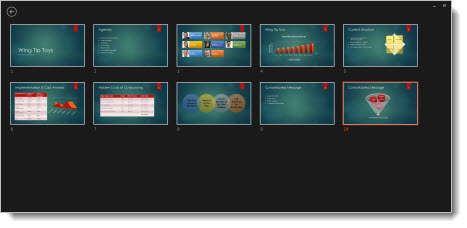
To view a detail in your slide up close, select Zoom into slide , and then point to the part you want to see.
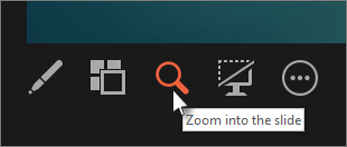
For more details on zooming in, see Zoom in to part of a slide .
To point to or write on your slides as you present, select Pen and laser pointer tools .

Press the Esc key when you want to turn off the pen, laser pointer, or highlighter.
To hide or unhide the current slide in your presentation, select Black or unblack slide show .

You can use PowerPoint on your smartphone as a remote control to run your presentation and view your speaker notes. See Using a laser pointer on your smartphone when presenting in PowerPoint for more information, including a brief video.
Swap the Presenter view and Slide view monitors
To manually determine which screen shows your notes in Presenter view and which shows only the slides themselves, on the task bar at the top of Presenter view, select Display Settings , and then select Swap Presenter View and Slide Show .

What the notes look like in Presenter view
Tip: You can add notes either while you’re presenting, directly from Presenter view, or as you’re editing your presentation. For information on how to add speaker notes to your presentation see Add speaker notes to your slides.

The notes appear in a pane on the right. If you need to add or delete something, simply click in the text box to edit it. The text wraps automatically, and a vertical scroll bar appears if necessary. You can change the size of the text in the Notes pane by using the two buttons at the lower left corner of the Notes pane:

To change the size of the panes in Presenter View, point your mouse at the vertical line that separates them, then click and drag.
Tip: If you don't need to see the current slide in Presenter View at all, and would like your notes to be larger, drag that vertical separator line all the way to the left.
Turn off Presenter view
If you want Presenter view turned off while you are showing your presentation to others:
On the Slide Show tab of the ribbon, clear the check box named Use Presenter View .

Keep your slides updated
If you're working with a team of people to create your slide deck it may be that changes are being made to the slides right up to the last minute. Traditionally once you've started your presentation your slides wouldn't update. If you're using PowerPoint for Microsoft 365 you have the option to let your slides be updated by your team even as you're presenting so that you always have the up-to-the-minute changes.
You can turn this on by going to the Slide Show tab of the ribbon, selecting Set Up Slide Show , and checking the box for Keep slides updated .
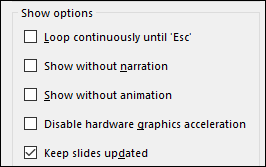
If you've already started your presentation and you want to make sure that setting is on, you can do that from Presenter view. Select the More slide show options button (which looks like three dots) and on the menu make sure Keep Slides Updated is checked.
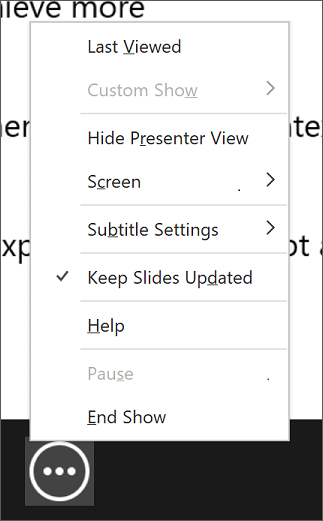
Using a laser pointer on your smartphone when presenting in PowerPoint
To start using Presenter view, select Slide Show > Presenter View .

To move to the previous or next slide, select the Previous or Next arrow.

To turn off the pen, laser pointer, or highlighter, press the Esc key.
To make the screen black or to un-black the screen, Press b on the keyboard.

Extend your Mac desktop to the second monitor
On the Apple menu, select System Preferences .
Open the Displays app.
Click the Arrangement tab in the dialog box.
Clear the Mirror Displays check box.
By doing this process, you now have a two-monitor setup. You can present a PowerPoint slide show on one screen while having other applications open on the other screen, keeeping those other apps private to yourself.
To manually determine which screen shows your notes in Presenter view and which shows only the slides themselves, on the task bar at the top left of Presenter view, select Swap Displays .
When your computer is connected to a projector and you start Presenter View, it appears on your computer's screen, while only the slides appear on the projector screen.

The notes appear in a pane on the right:
The text wraps automatically, and a vertical scroll bar appears if necessary.
You can edit the text in the Notes pane.
You can change the size of the text in the Notes pane by using the two buttons at the lower left corner of the Notes pane:

You can adjust the size of the current slide, and notes and next slide panels, by using your mouse to grab and drag the vertical line that separates the two panels.
Turn off Presenter view before a presentation begins
On the PowerPoint menu, select Preferences .
In the PowerPoint Preferences dialog box, under Output and Sharing , click Slide Show .
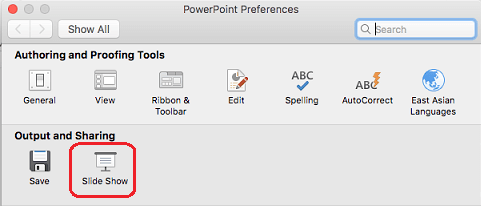
In the Slide Show dialog box, clear the Always start Presenter View with 2 displays check box.
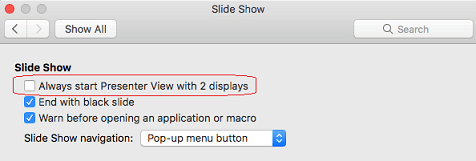
Close the dialog box.
Turn off Presenter view during a presentation
At the top of the Presentation view window, click Use Slide Show .

This button closes Presenter view. As a result, both your personal computer screen and the projector screen show the slide show.
If you're working with a team of people to create your slide deck it may be that changes are being made to the slides right up to the last minute. Traditionally once you've started your presentation your slides wouldn't update. If you're using PowerPoint for Microsoft 365 for Mac you have the option to let your slides be updated by your team even as you're presenting so that you always have the up-to-the-minute changes.
You can turn this on by going to the Slide Show tab of the ribbon, and checking the box for Keep Slides Updated .
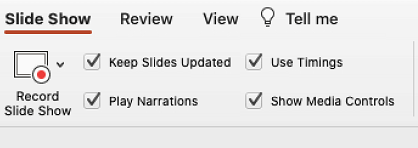
Create a self-running presentation
Record your slide show
Keep slides updated

Need more help?
Want more options.
Explore subscription benefits, browse training courses, learn how to secure your device, and more.

Microsoft 365 subscription benefits

Microsoft 365 training

Microsoft security

Accessibility center
Communities help you ask and answer questions, give feedback, and hear from experts with rich knowledge.

Ask the Microsoft Community

Microsoft Tech Community

Windows Insiders
Microsoft 365 Insiders
Was this information helpful?
Thank you for your feedback.
Man charged in apparent Trump plot wrote ‘This was an assassination attempt,' court filing shows
Ryan wesley routh, 58, was charged with two gun crimes after his sept. 15 arrest and will appear in a florida court on monday., by marlene lengthang | nbc news • published 5 hours ago • updated 3 hours ago.
The man charged in connection with an apparent assassination attempt against Donald Trump in Florida this month dropped off a box at a person’s home that included a letter that declared, "This was an assassination attempt," a court document revealed Monday.
The note came to light in a U.S. District Court filing asking that Ryan Wesley Routh , 58, be held in pre-trial detention.
📺 24/7 South Florida news stream: Watch NBC6 free wherever you are
Law enforcement was contacted by a civilian on Sept. 18 who said that Routh had dropped off a box at his residence several months earlier, the filing said. The witness opened the box after learning of the Sept. 15 incident at Trump International Golf Club in West Palm Beach, Florida.
In that box was ammunition, four phones and various letters.
The Hurricane season is on. Our meteorologists are ready. Sign up for the NBC 6 Weather newsletter to get the latest forecast in your inbox.
One handwritten letter addressed to “The World” said: “This was an assassination attempt on Donald Trump but I failed you.”
The letter said in part: “He ended relations with Iran like a child and now the Middle East has unraveled.”
Routh was arrested on Sept. 15 after a Secret Service agent moving ahead of Trump as he was golfing at Trump International spotted “the partially obscured face of a man” in the brush along the fence line and the barrel of a rifle “aimed directly at him.” The agent fired at Routh, who fled. He was spotted by a witness and was soon after arrested on Interstate 95.

‘Ticking time bomb': Those who raised suspicions about Trump suspect question if enough was done

Suspect in apparent Trump assassination attempt charged with two gun crimes, appears in court
Routh has since been charged with possession of a firearm by a convicted felon and possession of a firearm with an obliterated serial number. He is due in court Monday.
The FBI searched Routh's Nissan Xterra and found six cellphones — one of which contained a Google search of how to travel from Palm Beach County to Mexico.
Cell site records from two of the phones revealed Routh had traveled from Greensboro, North Carolina, to West Palm Beach on Aug. 14, 2024.
Further, on “multiple days and times from Aug. 18, 2024, to Sept. 15, 2024, Routh’s cellphone accessed cell towers located near Trump International and the former president’s residence at Mar-a-Lago,” the filing said.
Also found in the vehicle were 12 pairs of gloves, a Hawaii driver’s license in Routh’s name, his passport and documents. One of the documents was a handwritten list of dates in August, September and October and venues where Trump had appeared or was expected to.
Agents also found a notebook with “dozens of pages” filled with names and phone numbers about Ukraine, discussions on how to join the fight on behalf of Ukraine and notes criticizing the Chinese and Russian governments.
The filing said law enforcement learned that the license plate on the Nissan Xterra was not registered to the vehicle, and two additional license plates were found in the car.
A search of the area where Routh had been hiding near the golf course led to the discovery of a rifle with a scope attached and obliterated serial number, an extended magazine and a backpack and reusable shopping bag that both contained plates “capable of stopping small arms fire.”
On the rifle, investigators found a latent fingerprint on a piece of tape attached to the firearm that preliminarily matched Routh.
NBC News observed heavy police presence and tape on Friday near a row of palm trees and bushes lining the golf course on Summit Boulevard. The area featured an opening in the bushes behind the palm trees, which is easily accessible from the public sidewalk. The gap had a view of the golf course and was large enough for someone to occupy.
This is a developing story, check back here for updates soon .
This story first appeared on NBCNews.com . More from NBC News:
- The first graders who survived Sandy Hook will vote in their first presidential election
- Octopuses seen hunting together with fish in rare video — and punching fish that don't cooperate
- Politicians are promising housing help. Homebuilders say the problems are many and the solutions scant.
This article tagged under:
- Lebanon sees deadliest day of conflict since 2006 as Israeli strikes kill more than 270
- Is this war? The Israeli-Hezbollah conflict is hard to define — or predict
- Tugboat powered by ammonia sails for the first time, showing how to cut emissions from shipping
- Birmingham, Alabama, leaders plead for information on mass shooting and announce reward money
- Attorney for Missouri man seeking to halt execution cites exclusion of potential Black juror
- Ukraine's Zelenskyy visits Pennsylvania ammunition plant to thank workers and ask for more
- Harris owns a gun? Trump wants to cap credit card rates? Party lines blur in campaign's last stretch
- Trump says, if he loses, 2024 run will be his last
- Harris raises $27 million in New York fundraiser, promises economic speech this week
- US is sending more troops to the Middle East as violence rises between Israel and Hezbollah
- Election 2024 Latest: Trump and Harris work to expand their coalitions in final weeks of election
- Analysis: 6 teams saved their season by avoiding an 0-3 start
- Michigan State football's Armorion Smith is raising 5 siblings since his mother's death
- An improbable late-season surge from the Detroit Tigers has them fighting for a playoff spot
- Meghann Fahy and Eve Hewson's 'overnight success' is more than a decade in the making
- Diddy’s music streams jump after arrest and indictment
- Jazz saxophonist and composer Benny Golson dies at 95
- The Fed sees its inflation fight as a success. Will the public eventually agree?
- Before you sign up for a store credit card, know what you're getting into
- Stonehenge's 'altar stone' originally came from Scotland and not Wales, new research shows
- NASA telescope spots a super Jupiter that takes more than a century to go around its star
- A cave on the moon is confirmed, and scientists suspect hundreds more like it could house future explorers
- False reports of explosives found in a car near a Trump rally spread online
- Russia goes all-out with covert disinformation aimed at Harris, Microsoft report says
- FACT FOCUS: A look at false claims made by Trump in California
- Trump falsely accuses immigrants in Ohio of abducting and eating pets
- FACT FOCUS: A look at false and misleading claims made during Trump and Harris' debate
- FACT FOCUS: Posts falsely claim video shows Harris promising to censor X and owner Elon Musk
- A lost cat's mysterious 2-month, 900-mile journey home to California
- Thailand's adorable pygmy hippo Moo Deng has the kind of face that launches a thousand memes
- Police say a pair took an NYC subway train on a joyride and crashed it. They have arrested 1 teen
- A bewildered seal found itself in the mouth of a humpback whale
- Grand prize winner removed 20 Burmese pythons from the wild in Florida challenge
- Round 'em up: Eight bulls escape a Massachusetts rodeo and charge through a mall parking lot
- The benefits of a four-day workweek according to a champion of the trend
- Want to burn calories? Climbing stairs might be the most effective exercise for you
- Allergies can make you miserable. Here's how to track pollen levels near you
- Doing lunges while brushing your teeth, and other ways to stack healthy habits
- Menopause can bring on dental problems, but you can protect your mouth
- Newsletters Newsletters The Morning Wire Our flagship newsletter breaks down the biggest headlines of the day. The Afternoon Wire Get caught up on what you may have missed throughout the day. AP Top 25 Poll Alerts Get email alerts for every college football Top 25 Poll release. The World in Pictures Get The AP’s most compelling photographs sent directly to your inbox. The Sports Wire Your home base for in-depth reporting from the world of sports. World of Faith Comprehensive global coverage of how religion shapes our world. See All Newsletters
- See Oktoberfest's best photos as thousands of beer lovers descend on Munich
- Shohei Ohtani's historic first season with the Dodgers
- Cascading disasters push residents of a Nepalese valley to the brink
- Western nations were desperate for Korean babies. Now many adoptees believe they were stolen
- These South Koreans were adopted as babies. Now they're discovering their past was a lie
- New CIA workplace assault case emerges as spy agency shields extent of sexual misconduct in ranks
- Elite prosecutor misused position by offering Justice Department card in DUI stop, watchdog finds
- Tennessee family's lawsuit says video long kept from them shows police force, not drugs, killed son
- DNA on weapons implicates ex-U.S. Green Beret in attempted Venezuelan coup, federal officials say
- In Ohio, drought and shifting weather patterns affect North America's largest native fruit
- Profiles in clean energy: Dad concerned about climate change shifts company away from oil and gas
- High insulin prices spur a federal lawsuit against three pharmacy benefit managers
- US will let more people take methadone at home
- A new genetic analysis of animals in the Wuhan market in 2019 may help find COVID-19's origin
- Two Georgia deaths are tied to abortion restrictions. Experts say abortion pills they took are safe
- Scientists show how pregnancy changes the brain in innumerable ways
- Lebanese doctor races to save the eyes of those hurt by exploding tech devices
- Biden administration seeks to ban Chinese, Russian tech in US autonomous vehicles
- AI is helping shape the 2024 presidential race. But not in the way experts feared
- Stephen & Evie Colbert's red rice recipe, a dish both jammy and tangy
- Stephen & Evie Colbert offer a cookbook that's also a window on their lives
- Most Hispanic Americans support abortion access: AP-NORC poll
- Malaysian police rescue 187 more children as sex abuse probe of Islamic group deepens
- The family of a doctor accused of blasphemy in Pakistan says police killed him in a fake encounter
- Día más mortífero en Líbano desde 2006: Bombardeos israelíes matan a más de 270 personas
- AP Explica: qué se sabe y qué no de la desaparición de los 43 estudiantes de Ayotzinapa en México
- EEUU enviará más tropas a Oriente Medio ante escalada de conflicto Israel-Hezbollah en el Líbano
- ¿Es una guerra? El conflicto Israel-Hezbollah es difícil de definir, y predecir
- La IA contribuye a dar forma a la contienda presidencial de 2024. Pero no como temían los expertos
- Sureste de EEUU bajo aviso de tormenta mayor por alerta de huracán para partes de Cuba y México
- AP Buyline Personal Finance
- AP Buyline Shopping
- Press Releases
- Israel-Hamas War
- Russia-Ukraine War
- Global Elections
- Asia Pacific
- Latin America
- Middle East
- Election results
- Google trends
- AP & Elections
- Global elections
- Election 2024
- U.S. Supreme Court
- Auto Racing
- Movie Reviews
- What to Stream
- Book Reviews
- Celebrity Interviews
- Financial Markets
- Financial Wellness
- The Ancient World
- Newsletters
- Photo Essays
- Photography
- AP Investigations
- Climate Questions
- Climate Migration
- India Focus
- Artificial Intelligence
- Social Media
- Back to school
- Food & Recipes
Feds: Man accused in apparent assassination attempt left note indicating he intended to kill Trump
Body camera footage shows arrest of man suspected in Trump’s apparent assassination attempt
This photo provided by Hédi Aouidj shows Ryan Routh, a suspect in the apparent assassination attempt of Republican presidential nominee and former President Donald Trump, in Maidan, Ukraine on April 10, 2024. (Hédi Aouidj via AP)
In this imaged released by the Martin County, Fla., Sheriff’s Office, law enforcement officers arrest Ryan Routh, the man suspected in the apparent assassination attempt of Donald Trump, Sunday, Sept. 15, 2024. (Martin County Sheriff’s Office via AP)
- Copy Link copied
WASHINGTON (AP) — The man accused in the apparent assassination attempt of Donald Trump at a golf course in Florida left behind a note detailing his plans to kill the former president and kept in his car a handwritten list of dates and venues where Trump was to appear, the Justice Department said Monday.
The new allegations were included in a detention memo filed ahead of a hearing Monday at which the Justice Department argued that 58-year-old Ryan Wesley Routh should remain locked up as the case moves forward. U.S. Magistrate Ryon McCabe agreed, saying the “weight of the evidence against the defendant is strong” and that he should stay behind bars.
The details were meant to buttress prosecutors’ assertions that Routh is a threat to public safety with a premeditated plan to kill Trump — a plot officials say was thwarted by a Secret Service agent who spotted a rifle poking out of shrubbery on the West Palm Beach golf course where Trump was playing.
The note was placed in a box dropped off months earlier at the home of an unidentified person who did not open it until after last Sunday’s arrest. The box also contained ammunition, a metal pipe, building materials, tools, phones and various letters. The person who received the box and contacted law enforcement was not identified in the Justice Department’s detention memo.
One note, addressed “Dear World,” appears to have been premised on the idea that the assassination attempt would be unsuccessful.
“This was an assassination attempt on Donald Trump but I failed you. I tried my best and gave it all the gumption I could muster. It is up to you now to finish the job; and I will offer $150,000 to whomever can complete the job,” the note said, according to prosecutors.
An attorney for Routh didn’t immediately respond to an email seeking comment Monday morning.
Cellphone records cited by the Justice Department indicate Routh traveled to West Palm Beach from Greensboro in mid-August, and that he was near Trump’s golf club and the former president’s Mar-a-Lago residence “on multiple days and times” between August 18 and the day of the apparent attempted assassination.
He was arrested on Sunday afternoon after a Secret Service agent who was scoping the Trump International Golf Club for potential security threats saw a partially obscured man’s face, and the barrel of a semiautomatic rifle, aimed directly at him. The agent fired at Routh, who sped away before being stopped by officials in a neighboring county.
The Secret Service has said Routh did not fire any shots and never had Trump in his line of sight.
The Justice Department also said Monday that authorities who searched his car found six cellphones, including one that showed a Google search of how to travel from Palm Beach County to Mexico.
They also found a list with dates in August, September and October and venues where Trump had appeared or was scheduled to, according to prosecutors. A notebook found in his car was filled with criticism of the Russian and Chinese governments and notes about how to join the war on behalf of Ukraine.
The detention memo also cites a book authored by Routh last year in which he lambasted Trump’s approach to foreign policy, including in Ukraine. In the book, he wrote that Iran was “free to assassinate Trump” for having left the nuclear deal.
Routh is charged with illegally possessing his gun in spite of multiple felony convictions, including two charges of possessing stolen goods in 2002 in North Carolina, and with possessing a firearm with an obliterated serial number. More serious charges are possible in the weeks ahead.

- International
- Education Jobs
- Schools directory
- Resources Education Jobs Schools directory News Search
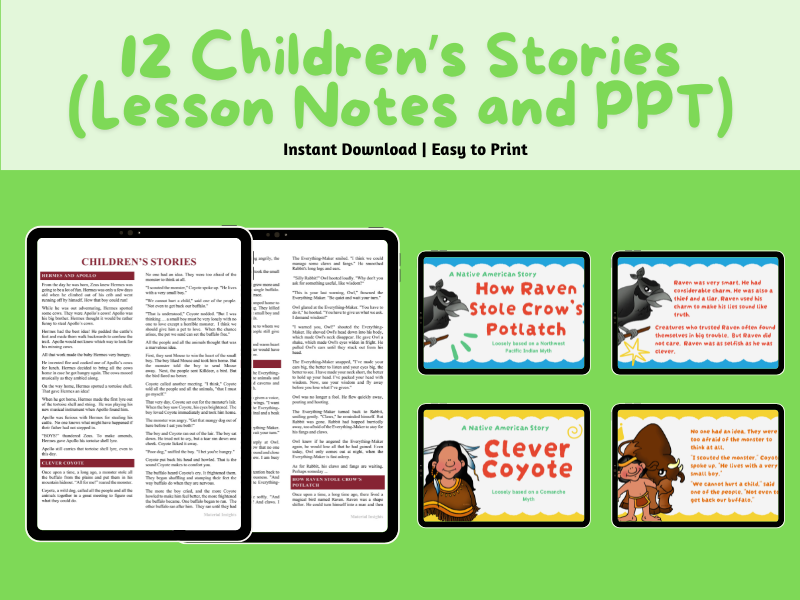
12 Children's Stories (Lesson Note & Powerpoint Presentation w/ 10 Reading Questions)
Subject: English
Age range: 3-5
Resource type: Lesson (complete)
Last updated
21 September 2024
- Share through email
- Share through twitter
- Share through linkedin
- Share through facebook
- Share through pinterest

12 Children’s Stories (Lesson Note & Powerpoint Presentation w/ 10 Reading Questions)
- Hermes and Apollo
- Clever Coyote
- How Raven Stole Crow’s Potlatch
- The True Story of Mulan
- The Invisible Warrior
- The Hero Twins
- Happy Together
- The Fox and the Crow
- The Fox and the Goat
- The Fox and the Sick Lion
- Child of Water & Little Blue Rock
Tes paid licence How can I reuse this?
Your rating is required to reflect your happiness.
It's good to leave some feedback.
Something went wrong, please try again later.
This resource hasn't been reviewed yet
To ensure quality for our reviews, only customers who have purchased this resource can review it
Report this resource to let us know if it violates our terms and conditions. Our customer service team will review your report and will be in touch.
Not quite what you were looking for? Search by keyword to find the right resource:

IMAGES
VIDEO
COMMENTS
Mind maps are diagrams used to represent words, ideas, tasks, or other items linked to and arranged around a central key word or idea. Mind maps are used to generate, visualize, structure, and classify ideas, and can be used as notes to aid a presentation. The advantages of using a mind map are similar to those of using keywords on cue words ...
First things first: the date's in the diary and you need to prepare. Let's break it down. 1. Preparing your presentation. Imagine you're a designer in the automotive industry and your boss has asked you to give a presentation. The subject: the future of the car and how it will fit with all the other modes of transport.
6/ Engage Emotionally. Connect emotional levels with your audience by appealing to their aspirations, fears, desires, or values. They help create a deeper connection and engagement from the very beginning. Make sure your introduction is concise and to the point. Avoid unnecessary details or lengthy explanations.
Spark Your Narrative Flow: Begin each slide's notes with a concise point that summarizes the slide's key takeaway. This will make it easier to edit notes later on. Trigger Powerful Stories and Examples: Rather than writing out long anecdotes, use concise bullet points that trigger the stories in your mind.
1. Give your presentation an introduction, a main message, and a conclusion. Some people summarise this as 'say what you're going to say, say it, then say what you've said'. However, that is not the whole story. Your introduction needs to 'set the scene' a bit and give a broad outline of what you are going to cover in your presentation.
Make sure your notes are easily readable. Use a large, 16pt sans serif font like Arial, double spaced. Write your notes in the upper half of the page to enable you to keep your head up, and to avoid having to look far down your notes or losing your place. Let the formatting of your notes inspire and guide your presentation: Use different fonts ...
Here's how to add notes in PowerPoint: Select a slide you want to add notes to. View the Notes pane located beneath each slide. If it's not visible, you can make it appear by clicking Notes on the bottom taskbar. You will see a blank space with the prompt "Click to add notes."
The most important thing to remember about using notes in a presentation is that using notes is a must, if you feel that they will improve or guarantee your ability to deliver your message clearly, confidently and concisely. Your audience will thank you for it - they want to hear your message. For more best practice tips and advice, please ...
Step 2: Then, navigate to the Notes Master View: View tab > Master > Notes Master. Here, you will see the default slide placement, along with the placeholder for your speaker notes. Step 3: Next, make changes to the layout in the Notes Master, keeping in mind that changes here will be reflected on all the notes pages.
6 Don't use slides as notes. An effective presentation has elements that don't always make it into the presented deck. An anecdotal story during your introduction, for example, is a presentation technique that's more effective when spoken rather than written on a slide. A fundamental presentation mistake is reading off of your ...
This clarifies the overall purpose of your talk and reinforces your reason for being there. Follow these steps: Signal that it's nearly the end of your presentation, for example, "As we wrap up/as we wind down the talk…". Restate the topic and purpose of your presentation - "In this speech I wanted to compare…". 5.
This is where presenter notes come in handy, and in this section, we'll learn how to turn the presentation script into presenter notes. The first step in this process is to go through the detailed script a couple of times, highlighting the main ideas, data, and messages to convey to the audience. You can follow the process as with meeting ...
Cut and glue them onto your notes or print them directly by using the "Size" option in the "Print Layout" tab. 4. Include brief details under the keywords. Follow the keywords with the details you need to express in your speech. Create bullet points or numbering beneath the words.
Next, in the pane on left, select the slide where you'd like to add speaker notes. Next, click the "Notes" button at the bottom of the window. A small box reading "Tap to Add Notes" will appear beneath the slide. For Mac users, this will say "Click to Add Notes.". Now, simply type the speaker notes for that slide.
Key takeaway: Reduce clutter where you can. 2) Great presenters don't use bullet points. Bullet points are the least effective way to get your point across. Take Steve Jobs, considered to be one ...
Use the colors most relevant to your message. Secondly, be consistent with the font. Consistent designs make your presentation look professional. Don't switch from caps and lower case, Cosmic Sans to Times New Roman, or 10-to-18-point text size. Keep your on-screen text uniform for a more cohesive message.
Simply jot down key phrases or headlines in bullet form. The point of the notes is to jog your memory. They shouldn't be so complete that someone else could pick them up and get the meat of your presentation. Make sure your notes are easy to read, which means writing large enough and leaving lots of white space.
Use note cards. Writing yourself a script could provide you with more comfort. To prevent sounding too robotic or disengaged, only include talking points in your note cards in case you get off track. Using note cards can help keep your presentation organized while sounding more authentic to your audience. Next steps
Add notes while creating your presentation. The Notes pane is a box that appears below each slide. (It is outlined in magenta in the picture below.) An empty Notes pane will prompt you with text that says, Click to add notes. Type your speaker notes there. If you don't see the Notes pane or it is completely minimized, click Notes on the task ...
Adding Speaker Notes. Open your presentation in Google Slides. At the bottom of the screen there's a text field with the message "Click to add speaker notes". The text that you enter here will be visible for you during your presentation, but not for your audience. Adding speaker notes. If you can't see this text field, click View → ...
Come with notes on the main points you'd like to address in a presentation, rather than a script to read word-for-word. Doing so will make your speaking seem more relaxed and natural. In order to improve your writing for public speaking, practice your presentation and ask for feedback to ensure your speech is the most impactful it can be.
Prepare a speech outline similar to this model: Write main points clearly with lots of space in between. Consider breaking up talk on numbered file cards (do not write full sentences; continue with notes with indenting and spacing even though you are using cards). Highlight important points and add instructions for delivery.
In Presenter view, you can see your notes as you present, while the audience sees only your slides. The notes appear in a pane on the right. If you need to add or delete something, simply click in the text box to edit it. The text wraps automatically, and a vertical scroll bar appears if necessary. You can change the size of the text in the ...
The man accused in the apparent assassination attempt of Donald Trump at a golf course in Florida left behind a note saying that he intended to kill the former president and maintained in his car ...
WASHINGTON (AP) — The man accused in the apparent assassination attempt of Donald Trump at a golf course in Florida left behind a note saying that he intended to kill the former president and kept in his car a handwritten list of dates and venues where Trump was to appear, the Justice Department said Monday.. The new allegations were included in a detention memo filed ahead of a hearing ...
12 Children's Stories (Lesson Note & Powerpoint Presentation w/ 10 Reading Questions) Includes: Hermes and Apollo; Clever Coyote; Wise Owl; How Raven Stole Crow's Potlatch; The True Story of Mulan; The Invisible Warrior; The Hero Twins; Happy Together; The Fox and the Crow; The Fox and the Goat; The Fox and the Sick Lion; Child of Water ...
If you need help brainstorming ideas, see the Writing Tutorial for Excelsior Online Writing Lab. Acing Your Presentation. You have also been asked to create a presentation. Creating a successful presentation takes different skills than writing a paper. Before you get started, take a look at the video from Wienot Films for some helpful ...